Australian
and international
exploratory
performance and
media arts
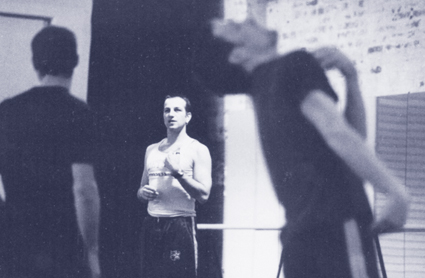
Gideon Obarzanek, Chunky Move
You can count on an evening of discombobulation when Chunky Move come to town with their suitcases full of Bodyparts, their new dance season at the Drama Theatre in August-September.
Gideon Obarzanek gets his teeth stuck into Little Red in All the Better to Eat You With exploring “the complexities of power and abuse beneath the familiar fairytale” Yeh, yeh but we know it’s the “psychotic beauty and seriously sensual” stuff we wanna see, “the surrealist tea party cum serial killer pantomime.” Yes! “A delectable fairytale fit for the new millennium” says The Melbourne Times, to which we say, yum-yum.
There’s more discomfort in Lucy Guerin’s Zero described by the choreographer as “an uneasy work that continually censors itself, reinventing its structural identity and the individuals within it.” Using techniques of film camera operation and playback translated into a real time situation, her choreography with Darrin Verhagen’s electronic soundtrack creates close-ups, jump cuts and extreme shifts in focus.
See it on a dark night.
–
Bodyparts, The Drama Theatre, Sydney Opera House, August 31 – September 4.
RealTime issue #32 Aug-Sept 1999 pg. 2
© inhouse ; for permission to reproduce apply to realtime@realtimearts.net
Traditional art forms have embraced new media in varying degrees, at different speeds. In most, progress has been stop-start, cautious, moreso than with artists who work direct to screen without the variables of, say, performance to take into account. New ways of working (programming, scoring), of presenting work (positioning screens in a performance space, in an installation, in a gallery, in relation to the bodies of performers and audiences), of researching, have had to be learnt from scratch by many artists wanting to explore the multimedia effect of other forms on their vision.
The term ‘multimedia’ has been challenged, at least in principle if not in usage by ‘intermedia’ (Darren Tofts, “Cutting the new media umbilicus”, RealTime/OnScreen #27), suggesting the importance of interplay (rather than the mere multiplicity) of forms and new technology, of the material and the virtual, and the importance of open-ended collaboration.
Under these circumstances, traditional forms blur, intermedia experiments generate hybrids and new works become difficult to categorise. For example, works by Norie Neumark, Philip Samartzis, Nerve Shell, Rodolphe Blois and Randall Wood promise striking visual and environmental experiences but have sound well and truly at their centre, framing and driving their works. It’s not surprising that the word installation has risen to such prominence (and been treated with such critical wariness). The installations listed on these pages are variously sound or video responsive but require participant movement, hopscotch or breath (quite different from the interactivity via mouse and click listed elsewhere in Working the Screen).
In dance and performance, the number of intermedia ventures is steadily multiplying, with notable contributions from Arena Theatre Company, skadada, The Party Line, Company in Space, Brink Visual Theatre, Salamanca Theatre Company, Doppio-Parallelo and others. Dance company Chunky Move have just released a CD-ROM, and choreographers Garry Stewart and Chrissie Parrott are engaged in new media investigations. Visual artists have not been slow to turn to the screen: galleries and contemporary art spaces have become first homes for a large number of new media works, either with one-off exhibitions like Mike Leggett’s Burning the Interface for the MCA, or Artspace and PICA’s continuing hosting and curating of new media shows, or the Bendigo Art Gallery’s current exhibition, byte me, with conference (speakers: Troy Innocent, Jon McCormack, Kevin Murray, Patricia Piccinini, Darren Tofts, James Verdon, Peter Hennessey). There’s Globe e the online journal/gallery. Michael Keighery explores ‘digital ceramics’ at the University of Western Sydney. And recently there’s been an impressive surge in innovative writing ‘in’ the web (tracked in RealTime’s regular hyperfictions and writesites pages) with some significant Australian contributions, prize-winners, and an Adelaide Festival presence in 2000. Public art too has taken to the digital with Patricia Piccinini’s Protein Lattice—Subset Red, 1997, a huge digiprint on a Melbourne building; Robyn Backen’s work-in-progress, the building that speaks, detailed on these pages; Melbourne’s Federation Square outdoor screens; and David Chesworth’s sound installation for the Olympic site (see Keith Gallasch, “Game to play” RealTime #29 page 42). The promise of new media across the arts is steadily being realised—we offer only a few of the many works to be seen shortly.
RealTime issue #32 Aug-Sept 1999 pg. 15
© RealTime ; for permission to reproduce apply to realtime@realtimearts.net
3V Media is developing the Digital Artstore: a distribution outlet for Australian and international digital arts and media work, primarily CD-ROM based, but also including DVD, video and other media forms. The aim of the Digital Artstore project is to provide specialised online and physical channels for the promotion and distribution of digital arts and media work, including work funded by the AFC, Australia Council and other work distributed by other local and overseas organisations and artists. The project is to be carried out in collaboration with leading Australian independent book stores which will provide the physical exhibition and sales points supported by special e-commerce websites.
We are also currently seeking work for the Digital Artstore. If you are aware of work that should go into the Artstore, or working on a project, we may be able to assist you in distributing that work, locally and globally.
The Artstore is part of an Australian Film Commission initiative to develop distribution strategies for digital arts and media work. Completion December 1999. In the interim, some work is already available through the gleebooks global online bookstore www.gleebooks.com
Enquiries: 3V@media.com.au or visit www.digitalartstore.com [expired]
RealTime issue #32 Aug-Sept 1999 pg. 7
© RealTime ; for permission to reproduce apply to realtime@realtimearts.net
Online Australia is involved in an astonishing range of initiatives, partnerships, forums and peak events, across business, government and culture. Amongst its cultural patnerships and sponsorships are the following: MAAP (Multimedia Art Asia Pacific), the online multimedia festival emanating from Brisbane in September is supported as one of its peak events. Online Australia hosted Project 1, a one day coming together of arts organisations, web developers and online business (see page 10). It has also declared the Apple-sponsored Fourth National Entertainment Industry Conference (Sydney, August 6 – 7) as The Peak Music Event of Online Australia Year. The National Cultural Festival Online (see page 7) is another cultural event supported by them.
Online Australia Year 1999 is a Commonwealth Government initiative designed to: help Australians succeed online; build Australia’s online communities; involve Australians in determining and participating in the nation’s online future. Online Australia 1999 comprises a national program of events and activities from March through November 1999 which will focus national attention on information economy developments and issues.
Each month of Online Australia 1999 has a theme, based on key areas identified in the government’s Strategic Framework for the Information Economy. From March to November these themes are: Information Economy; Regional and Rural Development; Small and Medium Business; Government Online; Employment Skills and Y2K; Education and Health Online; Culture and Communities; E-commerce; Australia and the Global Economy.
Here is a selection from Online Australia’s program for August – September:
August. Education & Health Online; Internet World Australia 99, Sydney, Aug 2 – 4; Telecommunications Online Forum, ACIF, SPAN & Telstra, Sydney, August 4; Fourth National Entertainment Industry Conference, Sydney, August 6 – 7; Royal College of Nursing Expo, Sydney, August 14; DTV & Datacasting: TV’s New Dawn, Sydney, August 19; Business/Banking Working in Partnership, Melbourne, Aug 20; Interact 99 Asia Pacific Multimedia Festival, Melbourne, August 20 – Sept 3; Online Australia Agenda Series: Education Online, Sydney, August 26; Health Informatics Summit, Hobart, Aug 29 – 30; Health Services CEO/PECC Forum, Hobart, August 31. Also in August, State Departments E-Health & Telehealth Workshops, Hobart, Perth Darwin, August; and Skills for the Information Economy, National.
September. Culture and Communities: Multimedia Art Asia Pacific Festival 99, Brisbane, Sept 3 – 12; Adult Learners Week: Seniors Online Day, National, September 7; Online Australia Agenda Series: Culture Online, Brisbane, September 9; Asia Pacific Triennial of Contemporary Art, Brisbane, September – January. Online Australia Agenda Series: Access & Participation, Melbourne, September 21; Business to Business Trade Show, Perth, Sept 21-23; Online Australia—SBS Multicultural News Portal, Online, September 24; Communication Research Forum, Canberra, September 27-28; Community Networking/Networking Communities Summit Ballarat, Sept 29 – 30; Online Field Day, Ballarat, September 29 -30; The Australian Virtual Centre for Women and the Law, Online, September; Australian Schools Web Challenge Winners Announced, National, September; NOIE IT & T Skills Website launch, Online, September; Online Australia National Cultural Festival Online (see page 19)
Online Australia is coordinated by The National Office for the Information Economy within The Department of Communications, Information Technology and the Arts.
For more information visit: www.onlineaustralia.net.au [expired]
RealTime issue #32 Aug-Sept 1999 pg. 3
© RealTime ; for permission to reproduce apply to realtime@realtimearts.net
“If new media teaches anything, it is that communal culture is productive. New media, like pop culture, shares its power with group reference. The more the better.”
Ross Gibson*
It would be right to say, the tiredness of the metaphor aside, that there has been an explo- sion of new media activity in Australia, an enormous amount of it online. It’s hard to keep up with, hence the importance of Working the Screen to help anticipate new works and com- prehend the breadth of activity. But explosion is not the right word. In her critical survey of the nurturing and development of new media, Sarah Miller argues that there’s been a great deal of teaching, learning, researching and experimenting going on for a very long time, and, despite funding cuts and some curious spending directions, artists have created many sig- nificant and innovative works throughout the 90s.
When we sent out messages requesting information from artists all over Australia about their works-in-progress the response was immediate and overwhelming. (It was interesting to read recently that the number of new media submissions for MAAP 99 (Multimedia Art Asia Pacific) quadrupled when compared with last year’s figure.) For Working the Screen, over half were works online, the rest installations (working from hard drive), CD-ROMs, a DVD-ROM, films and videos. There were also submissions from artists working in performance, spec- tator-activated installations, public art, dance and sound. Among the creators of the works- in-progress detailed in this liftout were some who once called themselves visual artists but are more likely now to label themselves media artists.
We were unable to contact some artists (overseas, too busy) and some felt that their projects hadn’t developed sufficiently to be reported. However, there were enough queries after our deadline passed to suggest we could immediately produce Working the Screen II. Jack White, producer of Museum Victoria’s Digital Planetarium (Scienceworks Museum, Spotswood) emailed us recently to report that “The new Melbourne Planetarium is cur- rently preparing a series of productions for its opening in September. We are employing 6 local digital artists and a couple of programmers for the job. The new facility is equipped with a 16 metre dome, 3D Star projector, 3
Barco projectors motorised for motion paths, a heap of slide and sfx projectors and six channel surround sound. The visuals are driven through DVMs. Production elements include 2D and 3D animation, multi-layering and all types of compositing, 3D star render- ing etc.”
We’ve just received Chunky Move’s CD-ROM (reviewed in RealTime 32), an Australian dance first exploring the collaborative creation and performance of the dance work C.O.R.R.U.P.T.E.D. 2. It was developed in collaboration with Peter Hennessey and Drome. Sound artist Nigel Helyer is working with Lake DSP in a 12 month partnership to create a 3D audio space with artistic and commercial potential. Justine Cooper, winner of the 1998 National Digital Art Award for Rapt, is developing a Biological Maze, with ramifications artistic and medical. There are also a number of dance new media projects by Jesse McNicholl, Chrissie Parrott and the new artistic director of Australian Dance Theatre, Garry Stewart, that we hope to follow up soon.
We also received many requests for reviews, given the limited availability of critical responses to new media art works, and even a job description redirected to us from recode: “A project between the Song Company and Martin and Peter Wesley-Smith to develop and write a new multi-media work exploring the scientific, ethical, social and political aspects of biogenetics and genetic engineering using the 6 singers of The Song Company and real- time computer processing of sound and images. The project URGENTLY seeks expressions of interest from artists working with video and multimedia wishing to contribute to this project. Further information: Roland Peelman, c/o Eugene Ragghianti.” Don’t hesitate.
We hope that Working the Screen excites interest in the range and complexity of new media work in Australia both as part of our rich screen culture but also right across the arts.
Our thanks to the Australian Film Commission, in particular to Kate Ingham and Julie Regan, for initiating Working the Screen, and to Brendan Harkin and Thea Butler of Online Australia (The National Office of the Information Economy) for their support.
* “Spacing the digital”, page 4
RealTime issue #32 Aug-Sept 1999 pg. 3
© RealTime ; for permission to reproduce apply to realtime@realtimearts.net
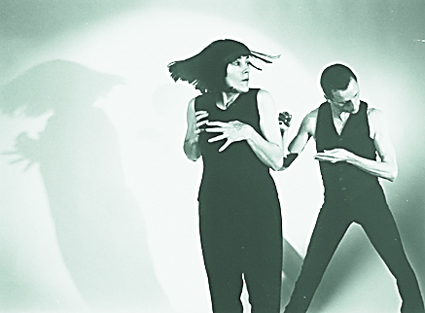
Helen Herbertson, Trevor Patrick, Delirium
photo Jeff Busby
Helen Herbertson, Trevor Patrick, Delirium
Helen Herbertson’s new dance theatre work, Delirium explores the schism between the worlds of sleep and waking. “The disciplines of dance, improvisation, theatre, music, visual arts and film inform Herberton’s work. However the language she creates”, says her press release, “is something quite unlike any of the original stimuli. It’s a personal approach, deeply embedded conceptually in an emotional and physical world and brought to the surface via a delicate interaction and collaboration with several other artists.” In this case the collaborating team includes some of the best in the country—performer Trevor Patrick, writer-director Jenny Kemp, optical illusionist Ben Cobham and composer Livia Ruzic.
–
Experience Delirium at the National Theatre, St Kilda, August 19 – 27.
RealTime issue #32 Aug-Sept 1999 pg. 37
Atomic Fuzz
Ian Haig
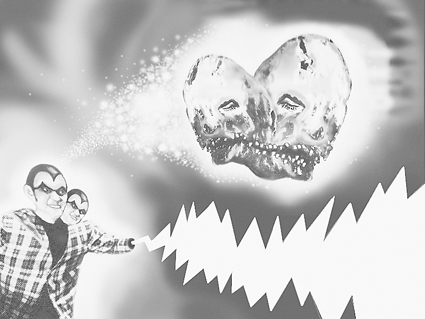
Ian Haig, Atomic Fuzz
Video clip. Animation: Ian Haig, 3 mins. Psychotronic grind….two headed transplant mutants, 50s monster movies, flying saucers, creatures from black lagoons, laboratory experiments, brain operations, invaders from Mars and lots of fuzz…
The biggest technical challenge in this project was working with Atomic Fuzz, because of their recent brain surgery.
Ian Haig is a media artist working across the areas of video, computer animation, and installation. His work has been exhibited nationally and internationally, most recently at VideoBrasil, Sao Paulo, Brazil, and Pandemonium Festival of moving images, UK
Completion September 99.
Tracking
Denis Beaubois
Tracking is an installation exploring the reading of an event through the facial expressions of the viewer. The response of the viewer formulates its own narrative which we, as observers, attempt to decode. It questions the role of documentation as representation and in its place suggests a process of translation.
The proposal is to devise a system of video monitoring which makes use of infra-red technology and night viewing equipment to scan and record audiences viewing performances. The video signal will be relayed in real time to the front of the venue and displayed outside (in the street) via a monitor. All who pass the theatre at the time of performance encounter a real time displaced electronic audience symbolically observing the pedestrian and transient traffic.
Born in Mauritius in 1970, Denis Beaubois lives and works in Sydney. His practice includes performance, video and photography. He has performed and exhibited throughout Australia, New Zealand, Europe and the United States. He has also worked as deviser and performer with Post Arrivalists (1993-95) and Gravity Feed (1994-99). His work titled in the event of amnesia the city will recall… won the Bonn Videonale 8 in Germany. He is presently working in Germany as Artist in Residence at the Artist Unlimited Group in Bielefield.
This work was tested as part of Space 1999 in May this year. It will be presented in Germany in October 1999.
Please Wait Here
Dominic Redfern
Please Wait Here is a video which also forms the central component of an installation piece. It takes as its subject matter daytime television, daytime talk in particular. It examines TV as a sort of campfire onto which we project our thoughts, drifting in and out of the content. The work is not, however, a negative critique of daytime TV’s opiate qualities. It seeks rather to embrace and explore some of the possibilities for a contemplative mode of awareness while in the viewing state.
The work took about 6 months to complete, pushing my home system to its limits, often taking up to 23 hours to preview minor changes to a minute or less of work. A 24 hour working method developed in which I would set the computer to render and then go off to bed, setting the alarm for a time when the computer predicted it would complete its rendering. Once completed the work cannot be backed up as a single file due to it’s size and has to be reconstructed from component parts each time I wish to copy it.
Dominic Redfern is a lecturer in Video Installation at RMIT in the Media Arts course area. He has exhibited work in galleries such as First Floor, Project Space, @lt TV and Westspace, and the Sydney Film Festival, Melbourne International Festival and the Anemone Program (WA).
To be screened at the Film and Television Institute of Western Australia and tour regional galleries as part of the Art’s Edge touring program.
RealTime issue #32 Aug-Sept 1999 pg. 18
© RealTime ; for permission to reproduce apply to realtime@realtimearts.net
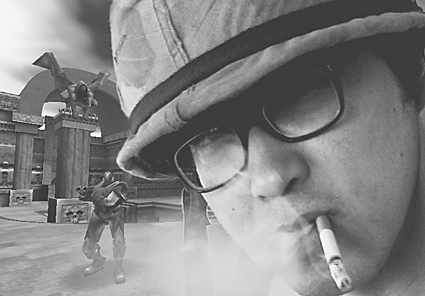
Feng Mengbo, Q3, 1999, digital video
Satisfying physical and cyber-needs
Talk about working the screen! By the time MAAP99 (Multimedia Arts Asia Pacific) Festival hits Brisbane and the Asia Pacific region from September 3 – 12 the organisers will have considered over 180 proposals (quadruple last year’s content) for more than 50 projects showcasing the latest in digital arts in the Asia-Pacific region. From over 60 submissions from Australia alone, the curatorial team selected 4 artists who have been supplied with Macromedia and Metacreations software valued at nearly $10,000. MAAP will bring the artists to Brisbane to participate in the festival.
The work in MAAP99 covers a range of art forms and practices with an emphasis on interactive multimedia, web, video, animation and projects integrating new media. It encompasses a range of public events, online projects, cinema screenings and exhibitions both on-site and online and forums addressing issues of audience awareness and critical engagement with artists working with technologies and screen-based media. MAAP99 is the ultimate co-mingling of the real and the digital, satisfying both physical and cyber-needs.
As you’d expect, such an ambitious project requires major support and MAAP99 has this from Online Australia, an initiative of the National Office for the Information Economy (NOIE) promoting the development of information technology throughout Australia. They’re also partnering the Third Asia Pacific Triennial’s Virtual Triennial exhibition which will be APT3’s official online art content and screen culture provider. Macromedia is again a major sponsor making available just about every tool they produce including Generator. With help from Firmware’s Generator server, live image and text updates to the web will be used extensively during the month-long online festival.
SEE, SEEK and SPEAK
The program has 3 streams. SEE is the national and international screening program at The State Library Cinema, September 4, and Queensland Art Gallery, September 5. It includes recent works from Korea, Malaysia, China, Taiwan and Hong Kong. Feng Mengbo from Beijing will present recent video and web interactive works. Videotage features the One Minute Video Festival, a selection of works from China curated by the Hong Kong Video and New Media co-operative. D.art is the annual showcase of experimental film, digital video and computer animation from dLux media arts in Sydney. Visual artists are creating short works for television to be broadcast in Art Rage. The Art Rage For Kids edition is available to schools as an introduction to creative uses of new technologies. The Samsung Project from Korean artist Young-Hae Chang will feature in a narrative program session titled Strange Stories; Self-Made Cinema. It incorporates recent works from Hong Kong curated and presented by Jo Law and will be toured by the West Australian Film and Television Institute. Digital Degrees features showreels of current digitally produced projects by multimedia and design students from Singapore, New Zealand and Australia.
SEEK is the interactive exhibition program including gallery, public spaces and online exhibitions. net.works/ MAAP99 Australia/Asia Artists Exchange is an online residency project aimed at generating dialogue, exchange, and collaboration between Australia and the Asia Pacific. Rather than run ‘real’ residencies which result in artists making works for the web, net.works/… is a habitation of the web, where the internet is used as a beginning point, a space from which to proceed, to commence a dialogue, to speak an idea, to live and work. It’s hosted by Multimedia Art Asia Pacific for the MAAP99 Festival and funded by the New Media Arts Fund of the Australia Council. Feng Mengbo (Beijing); Young-Hae Chang (Seoul); Rick Vermey (Perth); Tina Gonsalves (Melbourne) are partnered to interactively create joint on-line work.
Xi’an/Ipswich: Double Happiness is a unique cross-cultural internet exchange program with young web explorers from Australia and China. The project involves the joint design and construction of a website that will help create a link across cyberspace and between cultures. The project is managed by Arterial and Global Arts Link in association with the Bremer TAFE and the Xi’an Translators College with software support from Macromedia.
SPEAK comprises a conference, forum and training program. Presented by MAAP99 in association with ANAT and the Queensland Art Gallery, the conference Collapsing Geographies will take place at the Brisbane Exhibition Hall and Convention Centre on Saturday September 11. The focus will be on 3 artist exchange projects involving over 15 web artists from the region. MAAP is sponsoring international guest speaker Naranjan Rajah (Malaysia) at a forum discussing current and future strategies for digital art networks. This is part of the Asia Pacific Triennial Conference, Beyond the Future. As well, at the 30th World Congress of INSEA (International Society of Art Educators) MAAP will present an address and series of workshops to highlight the uses of technology for arts educators.
A real/digital night out
Opening night is Friday September 3 where special guests and late night shoppers will mingle in the Queen Street Mall in Brisbane’s CBD. The program includes large projections and a special opening program netcast live on the web. Melbourne curators Shiralee Saul and Helen Stuckey will present Pre Fab: Invisible Cities and Photon Palaces comparing and contrasting the digital architectural practices currently being developed by Australian artists and architects with those of their Asian peers. This virtual architecture exhibition will be projected onto buildings in the mall area. Cyberpoet Komninos will perform and project his poetry onto the main wall of the Queensland Performing Arts Trust. This will be netcast on the web. There’ll be computer games for those wanting to test their motor coordination. MAAP has also been trying to lure an international pop-star to Brisbane for this high-tech evening. “Diki”, the virtual pop star (originally from Korea, but often holidays in Japan) has promised a new world release for the MAAP 99 opening!
Stay online
Events physically held in Brisbane and in other parts of the region will be available to view from any location with a series of netcasts on the internet. Forums, artists’ live performances and intimate interviews will stream through the MAAP99 festival site to achieve a web festival experience. Each day of MAAP Month an online art project will be launched onto the MAAP website. Thirty online projects have been selected to enliven the web festival experience.
Fame too is on offer with The National Digital Art Awards staged at the Institute of Modern Art. And participation: a “People’s Choice” page will be housed on the MAAP website for judging the best Artist’s Website. These awards are open to all computer artists working in any digital format. Submit entries to the IMA.
MAAP99 is the perfect stay-at-home festival for the avid onliner but it’s also a seductive program for see-ers, seekers and speakers who want that special in-the-body festive experience. RT
MAAP99, Multimedia Arts Asia Pacific Festival, Director, Kim Machan. Brisbane and online http://www.maap.org.au/, September 3-12
RealTime issue #32 Aug-Sept 1999 pg. 24
© RealTime ; for permission to reproduce apply to realtime@realtimearts.net
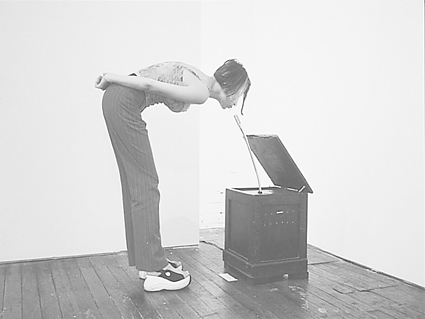
Mari Velonaki, Amor Veneris A
Amor Veneris A
Mari Velonaki
Amor Veneris A is a breath-activated installation (hard disk, breath sensor, various electronic media). A woman’s face is viewed through a magnifying glass which is installed on the top of a wooden box. The spectator can activate/awake her by blowing against her face using the breath switch which protrudes from the box and connects the spectator with the screen woman.
To use the breath switch to activate the quick-time movies, adaptations had to be made due to the fact that the switch was initially designed as an assisting device for people with paraplegia. These adaptations were implemented by means of a differential communications interface (RS-422) in a fully custom made electronics box. Breath sensor (switch) supplied by Enabling Devices-Toys for Special Children, NY, USA.
Mari Velonaki lives and works in Sydney. In a series of installations she aims to engage the spectator with the digital character in an interplay activated by sensory triggered interfaces (speech recognition, eye-tracking, breathing/blowing). Her work has been shown at Artspace, PICA and Ton-Bild Spectakel/Greifensee. Amor Veneris A is a derivative of Amor Veneris, Herringbone Gallery, Sydney, Mardi Gras, 1999.
MAAP 99, Science Centre, Brisbane, September 3 – 12.
A very Pentatonic Scale
Damian Castaldi
Video, installation and tuned aluminium bars. “The video plays the instrument” as light intensity levels vary depending on the changing video image of Curl Curl rockface and the spectator’s body movement between the screen and five transducers (mounted on a pentatonic scale).
The challenge is to program a MAX patch that will successfully coordinate the triggering process. This involves translating source data from Low Level 2 transducers to an analog to MIDI digitiser and outputting to actuators which play the pentatonic scale, to create an intriguing synergy between video, body and acoustics.
Damian Castaldi’s work explores audiovisual and instrumental crossroads between gesture-based, interactive audio systems and digital image for installation and the web. He was the 1997 recipient of the Australia Council New Media Art & Technology partnership with the ABC and works independently and in collaboration with the national artists’ collective nervous_objects.
Completion August 1999.
self remembering—optimal viewing distance
James Verdon
This is the 4th in a series of digital screen based installations interrogating memory and the electronic viewing screen as utilising common technologies of re-presentation and simulation. The installation seeks to articulate connections between memory and the electronic screen as viewed through the sieve of these technologies.
The primary technical challenges relate to the use of relatively unproven digital video delivery technology. The project utilises broadcast quality random access digital video and audio data from dedicated “black boxes.” This data is mixed with live video feed signal and lighting controls all triggered by a visitor’s jumping through a hopscotch court. No one in Australia has used this particular hardware before, and so the project has been a series of steep independent learning curves.
James Verdon is an artist working primarily with electronic media and emerging technologies, often utilising light as a primary interactive element. He is Course Coordinator and teaches theory and studio components of Electronic Design and Interactive Media (EDIM) in the Arts Department at Swinburne University of Technology in Melbourne.
Centre for Contemporary Photography (CCP), Melbourne, August-September 1999. Australia Council.
Facemen
David Cox
Utilising small ‘panasonic’ video LCD projector, commercial doll, video camcorder and face peep hole, Faceman is an installation which uses a small video projector to project the face of the onlooker onto a small puppet. By placing his/her face in a peep-hole cut in a flat surface the viewer then sees a puppet figure with a video-projected face. The work examines the complicity of the viewer in the form and nature of spectacular society.
In playing along with the implicit request of the work (to poke one’s head through the hole) the viewer automatically finds her face and speech transposed onto the symbol of manipulation—the puppet. The work aims to playfully examine the complex relationships between viewer and work, and by extension the role of video imagery in society as a whole.
The work extends ideas explored in earlier work, such as my 1990 black and white film Puppenhead. This and my 1998 film Otherzone examined the overall themes of identity, paranoia and technophobia. David Cox is Digital Screen Production Lecturer, Griffith University, Brisbane.
RealTime issue #32 Aug-Sept 1999 pg. 18
© RealTime ; for permission to reproduce apply to realtime@realtimearts.net
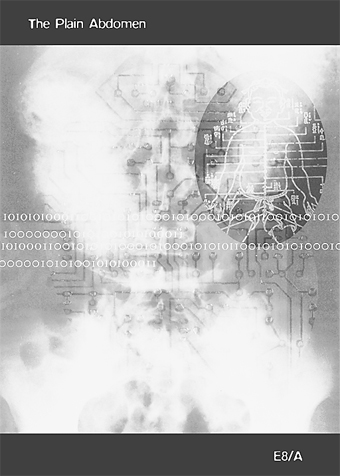
Norie Neumark and collaborators, Dead Centre: the body with organs
Dead Centre: the body with organs
Norie Neumark and collaborators
This sound/performance installation explores and plays with bodily organs as they are being reconfigured in computer culture. It explores computers as one particular incarnation of organs. The work also plays with the way art, not just science, can create metaphors through which we understand and interact with the biological and technological world.
Collaborators: Norie Neumark, sound, direction; Amanda Stewart, text, vocals; Maria Miranda, images; Greg White, sound design, programming.
A conceptual and technical challenge was to have complex, integrated but dynamic sound including composed, performative, and interactive sounds. Another was to create an affective interactivity that is a tendency rather than a trigger. It was also a challenge to have non-representational visuals that respond both to the sound and ideas.
Norie Neumark is a sound and new media artist. Her CD-ROM, Shock in the Ear, won major awards in Australia and internationally. Amanda Stewart is an experimental poet and sound artist. Maria Miranda is a visual artist. Greg White is a composer and programmer. (Maria and Greg also collaborated on Shock in the Ear.)
Completed July 1999, exhibited at The Performance Space, Sydney. New Media Arts Fund, Australia Council, NSW Ministry for the Arts.
Marine
Rodolphe Blois, Randall Wood
Marine is about our ambivalent relationship with water, the emotions it inspires of attraction and fear. A collaboration between soundscape composer Rodolphe Blois and filmmaker Randall Wood, Marine is in the early stages of creative development. It combines electro-acoustic music, cinematic and theatrical elements—a 50 minute “cinema for ears” work. Projected onto 3 screens almost enclosing the audience, the images are being constructed in response to electro-acoustic compositions from abstracted or anecdotal views of water showing natural or techno-based fluid qualities and the movements, reflections and distortions of forms and sources. Marine questions conventional relations between sound and screen and the omnipresence of visual images in cinema, proposing an alternative by giving the sonic dimensions a richer and more prominent role.
Randall Wood is a documentary filmmaker and a visual theatre projection artist. He produces documentary films with a social and humanitarian focus for education and television. His most recent film production is Selo! Selo! for SBS TV (see OnScreen in RealTime #32). His visual theatre work integrates large multi-image projection with dance, puppetry and drama. He is a key collaborator with Brisbane based visual theatre company Brink Performance (Under the Big Sky 1997).
Completion 2000.
The Invisible Songs Project
Steven Ball
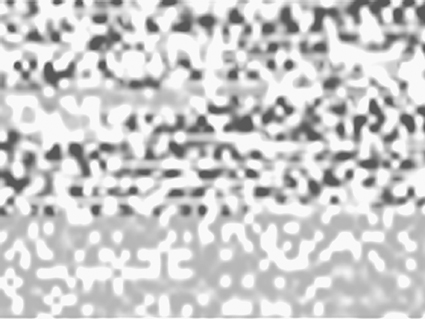
Steven Ball, The Invisible Songs Project
My current work in progress researches ‘digital materialism’, a term coined to suggest the ‘raw material’ of media, and translating the code between sound and image. The animated results will be integrated with investigations of the nature of particular places as a series of short video ‘songs.’ An extensive treatment of this work can be found in the latest Cantrills Filmnotes (no. 91/92, 1999).
As an unfunded (to date) project the working process is necessarily opportunistic and utilises whatever available resources I can freely access. Consequently the biggest technical challenges are largely practical and logistical ones of the storage and transportation of large files and finding enough time to work on it.
I have worked as a film, video and installation artist intermittently since graduating from an English art school in the early 80s. For some years I was closely associated with the Melbourne Super 8 Film Group and produced a large number of films in that gauge. In addition I have worked as a writer as well as curator and administrator with a number of local screen culture organisations
www.starnet.com.au/sball [expired] Completion 2000.
Public Art
the building that speaks
Robyn Backen
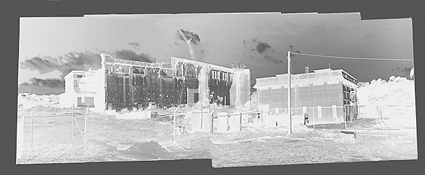
Robyn Backen, the building that speaks
the building that speaks is a public art project proposed by Robyn Backen and is at present in the development stage with its principal commissioner, the Brisbane Powerhouse Centre for the Live Arts. This project focuses on the facade of the building. the building that speaks has an interior and an exterior. The exterior utilises the existing windows/portholes on the boilerhouse facade as a frame from which to blink Morse Code out towards the city. The interior will house a computer which will host the messages. One of the possible messages may be the final Morse Code transmitted by a French vessel (1997) “calling all, this is our last cry before our eternal silence.” The public will also be able to send messages from the computer to the facade.
The interior and exterior will be married by a computer interface. The facade lights will be generated by a computer interface and a Morse Code translator/switcher. Director will synthesise texts generated by the interaction of members of the public with a touch screen. These texts will be displayed and compiled into histories.
Robyn Backen is a Sydney-based artist focusing on installation and public art projects. She is one of the artists commissioned to develop a public art work for the Sydney Sculpture Walk; this work is in its final stages of completion. Robyn Backen is represented by Roslyn Oxley9 Gallery.
Likely completion: early 2000. Brisbane Powerhouse Centre for the Live Arts.
RealTime issue #32 Aug-Sept 1999 pg. 17
© RealTime ; for permission to reproduce apply to realtime@realtimearts.net
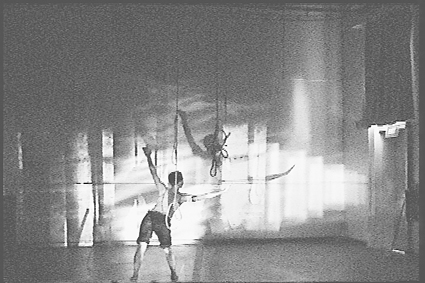
Hellen Sky, Company in Space, Architecture of Biography
Architecture of Biography
Hellen Sky, Company in Space
Architecture of Biography (working title) is a multiform interactive performance work and installation constructing metaphorical relationships to architectural space and universal biographies.
Collaborating artists: Hellen Sky, concept and direction; John McCormick, computer systems, design; Margie Medlin, image & light; spatial design, Simon Barley; dramaturgy/text, Margaret Cameron; sound design, David Chesworth; performers, Ros Warby, Louise Taube, Alan Widdowson, Margaret Cameron.
The challenge is in collapsing traditional relationships between movement, text, image, space, score, and in defining appropriate digital interactive systems, audio and image, and their methods of delivery through traditional and responsive digital means.
Hellen Sky, Co artistic director Company in Space, is a choreographer, performer, image maker creating performance and installation work using dance and new media. These works have been extended as telematic performances, bringing new relationships between performer, audience and site, most recently in Escape Velocity at IDAT ‘99 (International Dance and Technology), Arizona/Melbourne. Hellen is also Co-artistic Director of Dancehouse.
Completion 2000. Collaborative development funded by New Media Arts Fund, Australia Council.
Lampscape Fate
Cazerine Barry
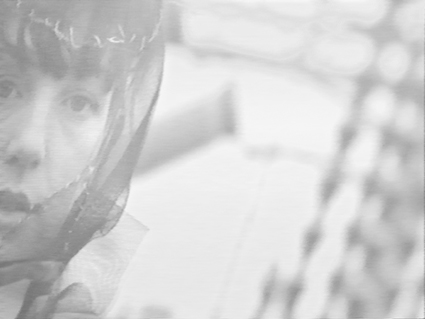
Cazerine Barry, Lampscape Fate
Tools: 1 dancer, 1 computer, 1 camera, 1 video projector. Psychological evocations of the historically infantile. Technically speaking, this is a solo performance; the use of projected multiple performers, however, leaves the audience with the impression of a much larger ensemble. Ethereal and layered images are projected into the performance, literally and conceptually. Sequential video images are used to create a spatial context for the movement while simultaneously exploring temporal and spatial distortion.
Challenges. 1. To perform by myself and sustain interest. 2. To create an image-story in seamless and illusory partnership with the performance. 3. To employ a process which alternates between digital and performance creation, allowing each to reinform the other. 4. To be realistic about the time it takes to adjust moving image compositions that could have taken days to make. 5. To defer the yearning for more time, money and hard-drive space.
Cazerine Barry is a choreographer, performer and video artist. Awards have included a Scholarship to the American Dance Festival, Australian Cinematography Award for FEAR co-produced with Adrian Hauser; an Asialink Fellowship and a residency with the Australian Indonesian Institute co-directed with Kate Mackie. New Media Fellowship, Choreographic Centre 1998.
Work in progress performance, KYKLOS cultural event, September 3 – 4, North Melbourne Arts House. Complete performance for Tokyo International Festival of the Arts, October 1999; Taipei and Hong Kong for Little Asia Tour produced by Hirano Pty Ltd and Melbourne City Council.
At Home Not Alone
John McCormick
An interactive online environment (developed out of company in space’s The Pool is Damned) allowing a global audience to construct the realities of four characters and the effects of power on their lives. Realities are constructed in realtime by choreographing gestures and rhetorical audio soundtrack.
Challenges: to maximise global audience interaction through web TV delivery systems; to ensure sound and video environment are malleable over the modem; to create a multi-user environment allowing more than one person to communicate through the site simultaneously.
John McCormick Co-director company in space and currently a visiting artist at RMIT Interactive Information Institute. John has been designing interactive dance works and computer systems allowing performer and audience to influence outcomes in the work. He is currently researching networking systems, ISDN and WEB Broadcasting for current and future projects.
Completion September 99. Arts Victoria and AFC New Media.
RealTime issue #32 Aug-Sept 1999 pg. 16
© RealTime ; for permission to reproduce apply to realtime@realtimearts.net
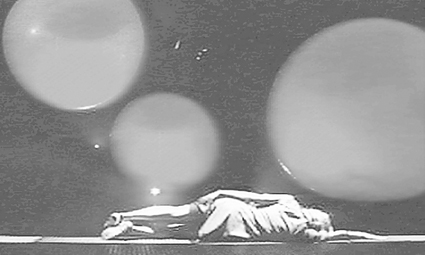
Arena Theatre Company, Eat Your Young
Eat Your Young
Arena Theatre Company
A lush, futuristic action adventure set in a privatised fully automated institution for minors in state care. Three children struggle to stay together in a climate of rapid change, a culture of fear where the young have come to represent the perpetrator, the icon of a society out of control.
The screen is often used as a backdrop in performance, but a performance that truly engages notions of screen culture in its evolution is much more challenging. Eat Your Young plays with the notion of real time by creating inherent formal questions in the viewing of the work. These questions are asked via a seamless vision mixing between the projected pre-recorded and live image (shot on robotically controlled tracking to allow precision repetition of X and Y axis pathways through space and time), design integration, live and pre-recorded vocal dub, computerised show control and continued use of mixed high tech and low tech aesthetic allowing effect and machination to be read simultaneously. Main challenges—our appetite exceeds our purse, clarity of dialogues across collaborators.
Arena Theatre Company aims to create multidisciplined performances that reflect the complex multiple nature of human experience. Arena’s manifesto cites young audiences at the fore of new cultural expression, fluid in their skills of deconstruction and symbolic comprehension. Recent work includes the anthroPOP trilogy AUTOPSY, MASS and PANACEA. Winners of the 1999 ASSITEJ International Honorary Presidents Award.
Completion March 2000. Arena is funded triennially by the Australia Council Theatre Fund and annually Arts Victoria.
Triple Alice
Tess de Quincey
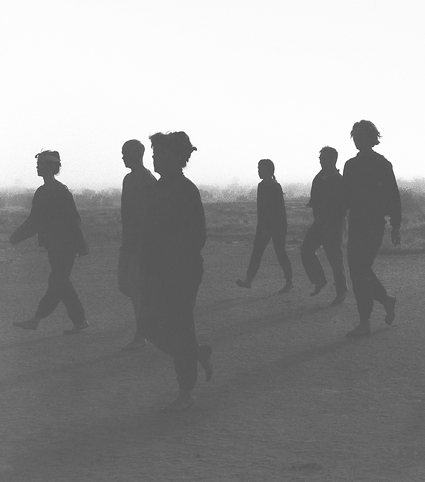
Lake Mungo, 1991
photo Heidrun Löhr
Lake Mungo, 1991
A gathering in hard space and virtual space, Triple Alice engages with Australia’s Central Desert as a burning point in its mapping of the future of artistic, cultural and media practice. Held over three years 1999 – 2001, Triple Alice convenes a forum and three live, site and temporally-specific laboratories staged over three weeks each year.
We are finding that remote broadcast and networking demands a cultural delicacy but also a technical capacity which as yet is under-resourced in its ability to meet the vision of this event. The KOZ online Community Publishing System will be fundamental to the project. Linked to the main site, KOZ creates an online congregation minus html phobia, and gives each visitor or, rather, ‘online resident’ their own web page and email address.
Triple Alice is initiated by Tess de Quincey, current recipient of the Australia Council Choreographic Fellowship. She has worked extensively in Japan, Europe, India and Australia as solo performer, teacher and director.
Triple Alice is a partnership between BodyWeather, Desart, Centre for Performance Studies (University of Sydney) and The Performance Space.
www.triplealice.net [expired] September 20 – October 10. Workshop component Australia Council funded.
Humanoids in progress
Arthur Wicks
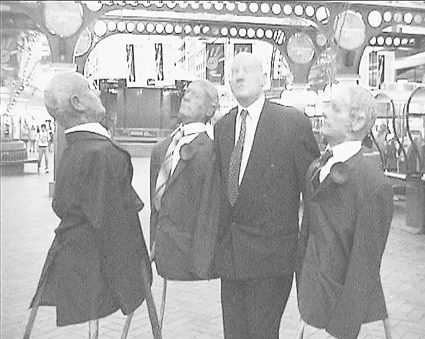
Arthur Wicks, Humanoids in progress
This is the early stage of a mixed media work where a group of “humanoids” are mobilised by remote control. The next stage of the project is to implant sensors which respond to a variety of inputs. The humanoids will then be able to interact relatively independently with an audience. Control of the physical servo mechanisms will be through a series of micro processors programmed to relate sensor input to specific physical responses. This phase of the project requires collaboration with an electronic engineer and the testing of stronger and more intricate physical servo mechanisms (such as those used in aerodynamics). This will enable the humanoid to perform more intricate physical responses over a longer period. Project time frame approximately 1999 – 2002.
Arthur Wicks has been involved with performance since the early 1970s. More recent works have involved the construction of machines which are “barely engineered, nearly built, narrowly operative. They teeter on the edge of collapse.” (David Hansen on Wicks’ Last Work,The Daily Advertiser, 1992)
Tower of Light
Melbourne Workers Theatre, The Institute of Complex Entertainment
Tower of Light explores gaming culture and corporate responsibility in a world where winning is everything and losing is invisible. It incorporates live performance and music, community groups, large scale puppetry and soundscape with projected digital video, slide and other electronic media. Director Susie Dee, visual media designer Chris Harris and lighting designer Nathan Thompson explore the role of immersive media spectacle in creating the illusory promise of gaming culture. They have been working in close collaboration with the writer, musical director and set designer to create an environment of images designed not only to seduce and dislocate, but also provide another effective layer of truthful communication within the performance itself.
The challenge for the creative team has been to use technology to build an environment of light and projection which successfully interacts with all the other elements and maintains the performance’s integrity.
Chris Harris studied sculpture at the SA School of Art and was a core creative member of desoxy Theatre for four years. He now works in Melbourne as theatrical stage and projection designer and a production manager. Nathan Thompson runs The Flaming Beacon, a small lighting design office in Melbourne. He has created lighting designs for performance, architecture and new media in projects on 5 continents. His recent piece with Christian Möeller, Audio Grove, installed at the Spiral Gallery Tokyo won a prize at last year’s Prix Ars Electronica and was re-mounted for Cyber 98 in Lisbon.
October 17 – 30, Melbourne Festival, Royal Melbourne Showgrounds. New media component funded by New Media Arts Fund, Australia Council
White Collar Project
Nerve Shell
A sound/performance installation to take place on a rooftop site in Sydney’s CBD. A hybrid of telecommunication devices, dance, spoken word, film and soundtrack. The audience, issued with personalised aural receivers, will experience a relayed series of live mixed and ever changing events emanating from remote performance sites. Primarily driven by the sound, the performance will implicate the invisible traces of the digitalised human and the gridded exchanges of the millennial city.
Among the challenges for White Collar Project are ways to immerse the spectator in a constructed world using real architecture, sights and sounds in a responsive way so that the prefabricated elements spark ‘incidents.’ Some of the challenges will be purely practical: negotiating fierce environments for access to city space during 2000; sourcing the most flexible technology: and interlacing, through live mixing, all the strands of this experience.
Nerve Shell is Caitlin Newton-Broad and Gail Priest. Together they created Dead Girls’ Party (The Performance Space Gallery 1997), a sound performance installation exploring the lost lives of famous artists’ wives. Caitlin is a writer/director. Gail is a sound designer/performance artist. Other artists contributing to this event include Samuel James, Shane Wynter, Regina Heilmann, Joel Markham and Ben Rogan.
April 2000. New Media Arts Fund, Australia Council
To Eat Flowers and Walk on Glass
Salamanca Theatre Company & syt (salamanca youth theatre)
A performance and installation with video,To Eat Flowers and Walk on Glass resulted from an 8 week creative development process involving STC artistic director Deborah Pollard, guest installation artist from Indonesia Hedi Hariyanto, Sean Bacon, Sally Rees, Poonkhin Khut and other emerging Hobart artists. The title is inspired by the Javanese trance dance called Jatilan in which the male dancer falls into trance and become possessed by horse spirits. The horse spirits are fed flower petals. The project will examine the many subcultures that exist within contemporary youth culture and compare them to some traditional counterparts.
The work will stylistically explore the interface of live action (tattooing and piercing) in relation to pre-recorded and live video. The ability of the video eye to digitally bring the action to a scale that is larger than life will be pitted against the effect of real action in real time. The installation will take place over 4 hours. Just as a tattoo slowly transfigures the body, video installations will create an atmosphere of constant transition as they imperceptibly change over the course of the work. A constant beat drawn from myriad trance cultures will continuously build and subside. The sound installation comprises live mixing and percussion.
CAST Gallery, Friday 27 August. Hedi Hariyanto courtesy of an artist-in-residence program, University of Tasmania. Australia Council, Arts Tasmania; with support from CAST (Contemporary Art Services Tasmania).
States Of Kinship
Doppio-Parallelo, Sustenance Productions
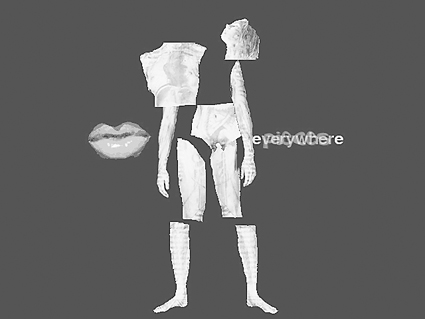
Lynne Sanderson, States of Kinship
States of Kinship was created as an adjunct to Doppio-Parallelo’s live theatre performance of the same name, written by Melina Marchetta. Based on a journey of cultural/personal discovery, the website relates to the rites of passage of the main character, Francesca. Enhanced by animated images and sound, the user explores her inner world. The script is set someplace between sleep and waking, between the physical dimension of live performance and the virtual space accessed via technology.
Beyond the technical difficulties of multiple platforms and browser differences was the challenge of condensing and distilling the essence of the script into a website to complement the live performance. We wanted to look at new approaches to performance writing and ways of engaging our communities in both urban and rural centres. In 1998 we brought a national group of cultural workers to our On Contested Ground public seminar at Ngapartji Multimedia Centre to discuss the notions of kinship, memory and racism—themes that are influencing our work over the next few years. Discussions were held with both real and online communities about what these issues mean to them today in Australia.
With the support of the Australian Film Commission, Ngapartji, Media Resource Centre and Australian Network for Art & Technology, a research group called Rosebud was established to undertake study regarding narrative and interactivity for performance. This group would later inform the practice for the States of Kinship project.
As Sustenance Productions, Lynne Sanderson (Digital Artist) and Peter Sansom (Sound Designer/Composer), have collaborated on computer animations Need and Primal Debug which have been exhibited extensively including MTV Australia and the touring exhibition An Eccentric Orbit which opened at MoMA, NYC and is currently touring nationally. Other works include the multi-screen installation …mutant!… exhibited at the EAF and the website Somnolent Fantasies (www.unisa.edu.au/sleep/art/title.html) created during a residency at the Centre for Sleep Research, Queen Elizabeth Hospital, Adelaide. http://sustenance.va.com.au/-Sustenance Productions
www.doppio-parallelo.on.net [expired] States of Kinship, the performance, July 26 – August 7 1999, EDS Centre, North Terrace, Adelaide. Australia Council and ArtsSA.
Monster Mouth
Dina Panozzo
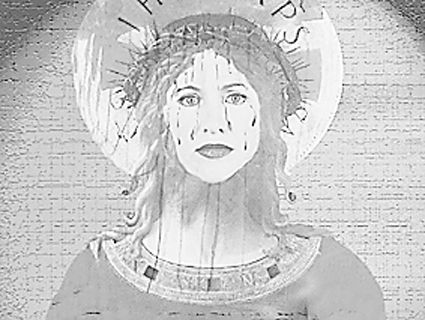
Dina Panozzo, Monster Mouth
A live performance with CD-ROM. In a state of psychic torment, a woman searches the internet for spiritual guidance. Along the way she encounters a female Jesus, a ghost turned body snatcher and finally her own personal apocalypse.
For the writer the challenges have included negotiating the different languages of computer graphics and text for a live performance. A sketch for a scene involving the snatching of my body almost wrote itself when I saw Maria Miranda’s images. For Maria, creating a trashy net-like world as well as a set of surreal images for large scale projection meant stretching the capacity of her low-end equipment to the limit: “For this scale of projection it’s all silicon graphics these days, but I enjoyed pushing Photoshop to do something wilder than normal. And the fact that the work is not timed for an interactive user but for an audience watching a live performance has sometimes meant more precision in the design.” Yet to be encountered is the challenge of Greg White’s programming and his sound design as they relate to the rhythms of spoken language and Elena Katz-Chernin’s music, followed by the interactions of live performer, a very large screen and an audience.
Dina Panozzo is a performer and writer living in Sydney. Her performance work with live video camera, Varda Che Bruta…Poretta (Look how ugly she is, poor thing) was produced with Open City in 1995, premiered in Sydney and toured to Adelaide and Melbourne.
Creative development of the CD-ROM component funded by the New Media Arts Fund, Australia Council. Dramaturgy and administration, Open City. Additional support from Playworks.
RealTime issue #32 Aug-Sept 1999 pg. 15
© RealTime ; for permission to reproduce apply to realtime@realtimearts.net
We were reminded early in the day that art and technology were once one and the same in the Ancient Greek ‘techne.’ Project 1 was an intensive, one day Online Australia forum for cultural organisations and web-developers. As Federal Minister for the Arts Peter McGauran put it in his opening address, “Project 1 aims to encourage dialogue and interaction between the cultural and the online sectors. Ideally today’s workshop will produce new partnerships, new opportunities…”
The forum was timely, lively and sometimes overwhelming as vocabularies were shared, upgraded and our mental spellchecks failed to recognise. In the morning keynote speaker Tiffany Shlain, Executive Director & Creative Producer of the Webby Awards and President of the International Academy of the Digital Arts and Sciences (US), defined online culture and panels of speakers briefly commented on their online cultural and business goals and experiences. In the afternoon, small, informal groups gathered in 45 minute Breakout sessions to discuss topics posted by those attending the forum. Any one of these sessions could have become the subject of at least a half day’s discussion. To this extent, Project 1 provided for artists and cultural organisations starting points that warrant continued consideration and debate. Also evident was the disparity in levels of knowledge, not just between business and the arts, but within the arts where the range of experience with new technologies runs from naive to expert. At the end of the day the most frequent comment heard was, “We need more of this.”
Putting the words together
Project 1 was an intense wordfest, a word wrestle, a yoking together of terms and concepts not often used in each other’s company. In the red, plush comfort of the Sydney Opera House’s The Studio, words that we thought we knew lunged at us like dark strangers, others fell apart like drunks, some staggered about high on overuse (what industry other than the net describes its customers as users, someone asked) and metaphors got dangerously cocktailed. Strangest (though who should be surprised as we dizzily fight off ever recurring bouts of economic rationalism) was the way key words from the communalism of social responsibility and the kingdom of capital overlapped and intersected or crossed the line or put an uncertain foot in each camp. Words like community, trust, heritage, cultural identity and diversity served all-comers, and mixed it with brand, industry, delivery, value-adding, currency, bonuses, marketplace and consumer, though more than one speaker stumbled over ‘arts industry’ and ‘culture’ stuck in a few voice boxes.
After setting the scene—“The development of communications technology this century has done much to weave the tapestry of Australian society by combatting the tyranny of distance which we inherited so long ago and bringing Australians together in new and often unexpected ways”—Peter McGauran coolly brought home the dialectic—”…in this increasingly globalised world we must ensure that all Australians continue to participate in our diverse cultural life and heritage”—which we worried at the rest of the day along with the business/arts tussle.
Back(s) to the future?
It was a day in which time as well as language was subject to delirium. How many times were we told that everything would be okay when we got the bandwidth we wanted, any day now, or later than we hoped, much later. Or that the arts online were three years, no five years, ten even behind business and that Australian business was five years, no seven, eight, behind America and Europe. Keynote speaker Tiffany Shlain mused that we were enjoying a New Renaissance, one analogous to the first, but with our technology at last matching our stream of consciousness. Others painted bright futures of community and access and profitability, some of it already here, some of it Australian and battling big US counterparts. One speaker gloomed that it was a future for some, but not for others as “the big five” prowled, buying up the future—small media arts companies. The same speaker, Jeffrey Cook (Director, 3V & Merlin Integrated Media), took us back to the idiosyncratic emergence of the Australian film industry (and our current international film reputation) as a model for working the net. At that moment Cook and McGauran seemed unlikely allies. Cook said, “Australian film is unique” and, by analogy with what can be achieved online, “that’s all that can save us in the future.” McGauran had declared, “our challenge is to ensure a distinctly Australian voice is heard amongst the hubbub of global discourse.” We all looked back to look forward, we looked in to look out.
Facts? What facts?
Statistics also eluded us with their instability and unavailability. It seems that the arts (the ABC aside) in this country have no idea at all who their audiences are. Business, however, does know its clients. But when it comes to the net, even business in Australia develops websites but will never market them. Peter McGauran said, “At present it is estimated that 70% of internet content accessed by Australians has been sourced overseas. It’s clear therefore that we have to develop new ways to promote our culture to ourselves and the rest of the world.” Peter Naumann (Manager Multimedia & Public Program, National Gallery of Australia) said that 50% of visitors to the National Gallery of Australia’s online gallery were from the US, 70% overall from overseas. Victoria Doidge (General Manager of the impressive Chaos Music online store, our first serious taste on the day of e-commerce for artists) said they were doing impressive business nationally but also with overseas customers (how many?).
Of course, thanks to email, to its engrossing sense of intimacy and communality, we have a means of finding out like never before who’s out there. And the AFL (Australian Football League) is right into it, engaging millions with pure information, including a weekly injuries list. Could theatre companies offer the same (instead of the atrociously quaint newsletters they print)—updates on hoarse voices, sore backs, critical thrashings. It seems the online means are there to find out more and more about our audiences and to project potential markets, but the work on it in the arts has barely begun except with some film organisation and youth culture programs.
Social good and capital success
‘Intimacy’ and ‘community’ resonated across the day with overtones of social good and capital success as we learned of the desire to belong that the net fosters through news and gossip and sensitively constructed list server levels of access (‘trust’ again). A new subjectivity emerged too, amplified in an advertising scenario where we no longer have to project onto archetypes. No. We are scanned into promotions as ourselves, like Martin Lindstrom’s (Executive Director, Zivo) story of a NY child’s face mapped onto a Barbie doll purchased through the net, and his own image (sent to him online) adorned in the latest fashions after he’d been scanned in a fashion store.
Equity and social justice occasionally surfaced from their steady subtext, humble Davids toppling corporate Goliaths in winning Shlain’s Webby Awards—anyone can succeed and it doesn’t have to be with every plug-in in the book. On the one hand, there was a happy free market belief in the power of individual will and creativity, on the other a serious concern to create systems responsive to those with “only a phone and a microwave” or the cheapest of computers. Email, said Tiffany Shlain and Ruby Blessing (Group Creative Director, Spike), was seriously under-utilised. Occasionally there was a myopic globalism—we’re all in this together, it’s universal, we’re all speaking the same language (html)—oblivious to the new class lines defined by who has the technology and who doesn’t, and to the millions in the world who have never seen a telephone let alone used one, and then there’s UNESCO’s recent report on the limited global uptake of the net. But the curious mix of laissez faire energy and the drive for social responsibility in the context of apparent technological inevitability kept issues on the boil and one’s vocabulary on red alert.
Speaking each other’s language
Key words kept recurring all day—partnerships (tied to bartering), value-adding (along with bundling and bonuses), community (whether referring to a social group, a virtual one or company employees, and tied to intimacy and trust), access (how to reach as many people as possible with the simplest technological means), currency (keeping your site ‘fresh’, or what you can barter with—’the arts are sexy, business needs you’—I never quite believe this), portals (are they working, how can we make them work for us?), lists and filters (helping direct users to areas where they can then make choices) and branding (arts companies having to look beyond their logos). These fuelled much of the afternoon discussion. But there were other words used approvingly like ‘chaos’ and ‘junk’ that reminded us of a net free of ‘convergence’, of creative mess, and, as several speakers noted, work on the web as an ongoing experience, an evolution, something unfinished.
It was a day of anecdote, hyperbole, vision, caution and timewarps, and a wobbly lexicon—not a bad thing when you’re trying to get a handle on a newish world, and not a little Shakespearean when the language is rich, silly, technical, pliant, shifting and often barely defined. Not that I left Project 1 happily branding and value-adding: I guess I like that tension between the arts and business. If we have something to learn from each other, Project 1 was a glimpse of some intriguing possibilities needing further thought and more dialogue. True to the promise of Project 1, web developers and business managers met with artists and members of arts organisations in a dialogue worth continuing. Of course there are many artists who are web designers by the very nature of their online work and more than a few intersect the worlds of commerce and art.
Go online for more of Project 1 [no-longeer available]
. It includes a detailed account of keynote speaker Tiffany Shlain’s address on online culture and how the Webby Awards work (for one thing as another kind of filter, she suggested), plus summaries of talks from Richard Fidler (panel chair, writer, performer, TV host)—“the lovely thing about the web is that it’s such messy business, genuinely chaotic. Business men want to impose some elegance on it”; David Thompson (Senior Consultant, Deloitte Touche Tomatsu)—“creativity in new media hasn’t yet delivered…hasn’t hit on a winning formula”; Claire Byrnes (Producer, ABC Arts & Culture Online)—the need for “a content that everyone can see, therefore not reliant on plug-ins…”; Tess Dryza (Creative Director, Multimedia, Open Training & Education Network)—the task of building online communities generating trust and intimacy; Ruby Blessing (Group Creative Director, Spike)—“define different groups within your database rather than using a blanket approach”; Martin Lindstrom (Executive Director, Zivo)—“Now it’s a matter of the customer becoming the star. I’m the centre”; Victoria Doidge (General Manager Chaos Music)—“we’re selling Australian music to the world and it’s working well for us—the top 5 on the chart are Australian independents. We create a web page for them for each of their products. They can go in and manage that page and link it to other sites and list performances”; Jeffrey Cook (Director, 3V & Merlin Integrated Media)—“For years I’ve been trying to get cultural organisations to work together. That’s supposed to get a laugh…If we had one arts portal—not a damn government one—everyone would go to it! e-commerce you haven’t seen anything yet.” Peter Naumann (Manager Multimeda, Australian National Gallery)—“The gallery has 100,000 works in store rooms, has launched 5,000 on screen, and by the end of year will have 10 – 16,000 accessible.”
Also in the online report from the afternoon Breakout sessions is a detailed account of the discussion of the future of the Australian Cultural Network which included issues of research and marketing, mega-portals, the success of the AFL site and why the Australian Cultural Network includes Skippy and Neighbours sites (thousands of hits for them). Very briefly summarised too are sessions on youth culture online, regional needs and branding, along with a few of the notable provocations including, “Only Victoria is forward-looking in new media—the rest are casualties”.
Project 1 was presented by OnLine Australia (a project of The National Office for The Information Economy) in partnership with the Australia Council, RealTime and the Department of Communications Information Technology and the Arts.
RealTime issue #32 Aug-Sept 1999 pg. 10-
© Keith Gallasch; for permission to reproduce apply to realtime@realtimearts.net
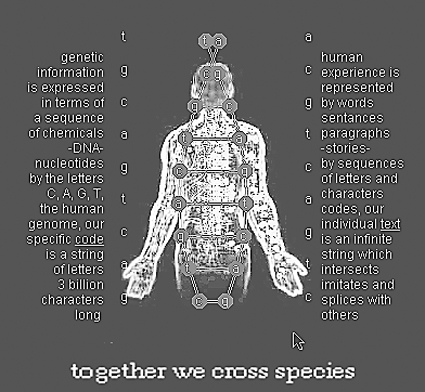
Melinda Rackham, carrier
Carrier
Melinda Rackham
Carrier is an experimental website investigating viral symbiosis in the virtual and biological domains, focusing on the hepatitis C (HCV) epidemic. A Java applet, named infectious agent, navigates the viewer along a unique site pathway, dependent upon the viewer’s interactions.
The major technical challenge on Carrier has been for Damien Everett and John Tonkin who have worked on the stable implementation of both Java and sound on the site, which has required many alterations to the original concept because of Browser, Browser Version and Java inconsistencies between the Macintosh and PC platforms.
Melinda Rackham, an artist and writer residing on the east coast of Australia, has been working online since 1995 in her domain www.subtle.net. Her earlier sites a.land, line and tunnel have been widely seen both in Australia and overseas. She is currently a Doctoral Candidate at COFA, UNSW.
www.subtle.net/carrier Completion 31 July. New Media Arts Fund, Australia Council.
Elementia
Kate Richards
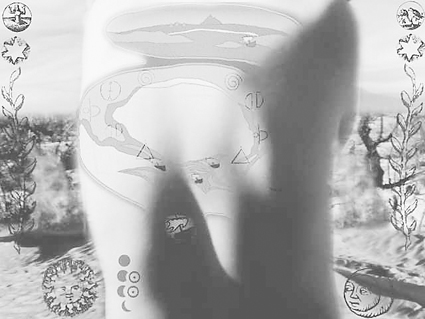
Kate Richards, Elementia
The interactive CD-ROM Elementia is an allegory for our obsessive search to reconcile matter and spirit. The tale unfolds through Anax Helio’s private collection of Elementian maps: cartographs bizarre and eerie, urbane and greedy, of metal and stone and skin and luxite. Elementia is an experience inspired by Bahktin’s chronotope: “A time/space, a fictional setting, where time thickens, takes on flesh, becomes artistically visible.”
Interactive multimedia is especially demanding in its conception as both “architectural” space and time-based media. The artist needs to create discrete sequences that can connect to multiple others, and yet are integral to an overall scheme. Thinking in this modular way is easier than developing rigorous concepts and themes across linear media, and yet more difficult if one doesn’t want to create a mere patchwork. Once this is solved, “process” is still fairly uncharted terrain. We have a way to go before art IMM will have the well-tested production and technical processes of linear media.
Director/producer, Kate Richards; programmer, Ryan Sabir; designers, Chris Caines, David Lawford, Ayca Smith.
Kate Richards is a multimedia artist and producer, and an Honorary Research Fellow in New Media at University of Technology, Sydney. Current projects also include: Life After Wartime (CD-ROM), as producer, with writer/director Ross Gibson.
Completion December 1999. Australian Film Commission.
Pretty Aprons
Alyssa Rothwell
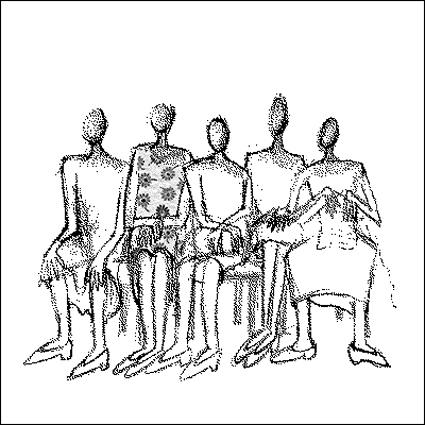
Alyssa Rothwell, Pretty Aprons
From the creator of the award-winning Three Mile Creek, Pretty Aprons allows you to ‘sew’ your way through stories and explore the lives of rural women. Narrated by a young girl, you are asked to help sew aprons as Christmas gifts for all the ladies she knows.
The emotional engagement that narrative in film can offer is something I try to include on CD-ROM. Maintaining an audience’s sense of immersion in the interactive non-linear format of the stories, and using layered sound to provide a cinematic quality, are constant challenges due to the physical limitations of the medium and the computer screen.
Coming through dance and the visual arts, Alyssa graduated from the Centre for Animation and Interactive Media, RMIT in 1996. She has exhibited internationally, was a winner of an ATOM award in 1997, and represented Australia in the New Talent Pavilion at MILIA, Cannes in 1998. Between lecturing in multimedia at UNSW and producing her new CD-ROM, Alyssa freelances as a new media artist. www.ozemail.com.au/~alyssar/ [expired]
Completion late 1999. Australian Film Commission.
The March of the Photobots
Dave Sag, Mike Cooper
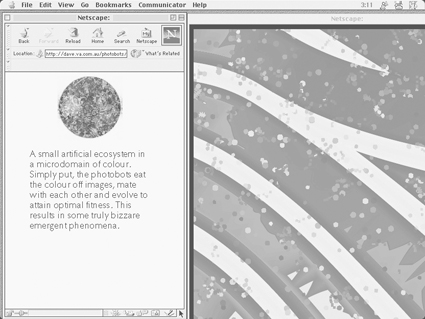
Dave Sag, Mike Cooper, The March of the Photobots
The idea: small ‘artificial’ creatures consisting entirely of colour are fed an image which they use as a basic foodstuff. In a matter of days they will gather in large ‘caterpillar balls’ which act as a whole, sucking all colour and light from the image. Dave is evolving the work into two projects, one called V-Aura, a wearable networked photobot environment, and one called The yard, which is an online persistent playground for Java based life.
Dave developed the concept and wrote the specification for the bugs’ initial behaviour. The scientist, Mike Cooper, coded the photobots in Java and devised the viewer for examining the bugs in detail.
The challenges faced. Technical: the photobots can learn without having any memory, thousands of them will run within a single web page. Theoretical: conflicting theories of intelligence, machine learning and memetics. We succeeded in building creatures which can learn without having any memory of their own.
Entrant in the mcmogatk 1999 Arts on the Net exhibition, Japan. Self-funded: cheap to make, just takes ideas and a little time. The March of the Photobots exhibition is up in prototype stage at art.by.arena.ne.jp/mcmogatk/1999/d_sag [expired]
My Room Le Grand Canal
Philip Samartzis
My Room Le Grand Canal is a DVD-ROM-based project examining the specific flow, texture, space, tone and dimensional qualities unique to the city of Venice. The project will expansively draw upon these qualities in the development of a physiological, spatial and psychological portrait of a city which simultaneously acts as an anthropomorphic metaphor.
The technical aim of the project is to explore the potential of the DVD format by combining Dolby digital surround sound with full motion and full screen digital video, and digital imaging and graphics in an expansive audio visual presentation. Another aim is to combine both analogue and digital processes in the abstraction and manipulation of sound and image, so that strategies may be developed which will create a rich and unified experience of action and space.
Philip Samartzis is a Melbourne-based sound artist. He recently co-ordinated and curated the Immersion series of 35mm Dolby encoded surround sound performances. He also recently collaborated with Martine Corompt on Dodg’em, a driveable surround sound installation presented at Gallery 101, Melbourne.
Completion December 2000. Developed in co-operation with the Studio for Room Acoustics, IRCAM, France. New Media Arts Fund, Australia Council.
blue in the bluebird
Jennifer Seevinck
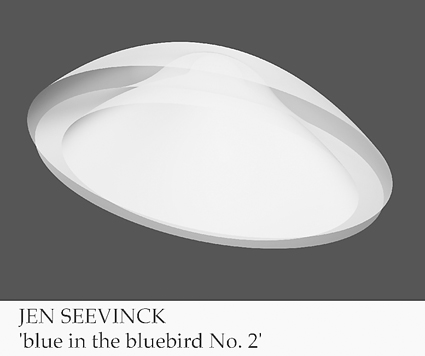
Jennifer Seevinck, blue in the bluebird
blue in the bluebird is a computer animation loop of 6 minutes, intended for gallery installation. Concept and animation by Jen Seevinck and sound by Tim Kreger (see interview in RealTime #32).
After modelling birds in 3D computer space these were animated in specialised animation software, Houdini, as flocks. ‘Forces’ in cyberspace were modelled to animate both individual birds and the flock. Successfully integrating these layered, fluid movements inherent to the conceptual structure within the limitations of computing and rendering large data streams was a challenge.
Originally trained in architecture, Jen Seevinck has worked in theatre design, independent filmmaking, dance and digital media. Her research interest in ‘cyberplace’ complements her computer animation work and collaborations. After teaching and submitting her Masters in Electronic Arts at the Australian Centre for the Arts and Technology, ANU, she has moved to Deakin University to continue lecturing in animation and multimedia.
Completed June, 1999. Will be installed as part of the contemporary media exhibition Probe in Beijing, October 1999.
Scar tissue
Jason Sweeney
Scar tissue is a sound installation/online performance/net audio project investigating the veneer of background music, everyday noise, speech and electronic hum—one that questions systems, confronts the codes and digits, infiltrates the surface of sound construction, by breaking into the codes of the media lying at my disposal.
During a residency at Banff in Canada I will investigate, pull apart, reassemble, argue, discuss and research the nature of sound/music/noise as a tangible, changeable, permeable and highly volatile entity—taking a scalpel to technology, confronting the problems of techno-accessibility and viability of sound and performance in an online environment. The lo-fi vs hi-fi possibilities…
As an artist I work across disciplines of audio/sound art, the internet, performance and writing. My work interrogates the processes and implications of technologies of the past, present and future, technology that simultaneously throws itself in my face, without invitation, triggering me to push back and question its intrusion.
Completion mid-2000, Australia/Canada; to be developed at Banff Centre for the Arts, Canada as part of an Australia Council New Media Arts Residency.
Sensory Overload
Kevin Tham
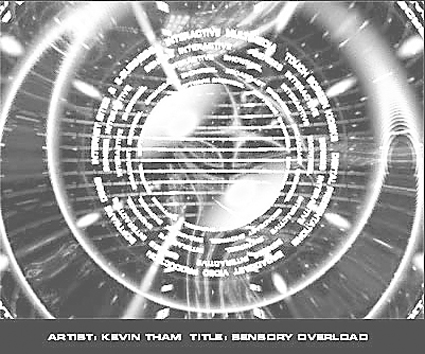
Kevin Tham, Sensory Overload
Sensory Overload is an experimental, promotional, multimedia CD-ROM for Senses Interactive Pty Ltd. Filled with an array of animations, text, sound, video and special effects, it utilises the latest in digital video technology to create a fully realised Video Interactive (VI).
In attempting to create a full screen moving, Video Interactive, we have had to completely re-learn and rethink the way we usually create multimedia. We are utilising a combination of Director, Videoscript and Custom code to enable full screen video interaction, working out seamless video menu loops and transitions, multi-layered video scripting, quality compression and data rates, multi-video masking and animated video rollovers.
Kevin Tham, New Media Designer/Interactivist, Bachelor of Design degree, College of Fine Arts, UNSW. Trade shows and conferences, software packages, broadcast TVCs, CD-ROM Magazines (This! Zine Issues 0,1), CD Case Studies, CD Tourism interactives, interactive banking, corporate and government sales presenters and demos.
Spatial Emergence
Paul Thomas
The concept behind the project is the transphysical city, an exploration of the spatial intervals and boundaries between autonomous architectural structures. If one was to view the buildings within the city as words, then the street could be seen as a sentence. The spaces, or pauses, between the words give the sentence added meaning. Due to telecommunications, architectural infra-structures no longer need to remain in their present form. The ability to renegotiate perspectival constraints is vital research for artists at this point in time. The work is completed in its CD-ROM form but is also linked to its own developing website: www.imago.com.au/spatial [expired]
Technology has assisted in articulating the range of emergent spaces subtly operating within every metropolis, exposing and revealing them. The challenges to visualise this were many, for instance understanding various software packages and creating video, sound, still images in an interactive format. As well there was the challenge of making the work crossplatform and having the CD-ROM link to the internet to access the website as well as download images.
My art reflects a conscious and unconscious construct of dislocation. This sense also appears in my work as social and cultural critic. Works include Media-Space (1981-86).
www.imago.com.au/spatial/spatialdir/ss.dcr [expired] CD-ROM project funding: New Media Arts Fund, Australia Council.
A Grand Unified Theory of Self
John Tonkin
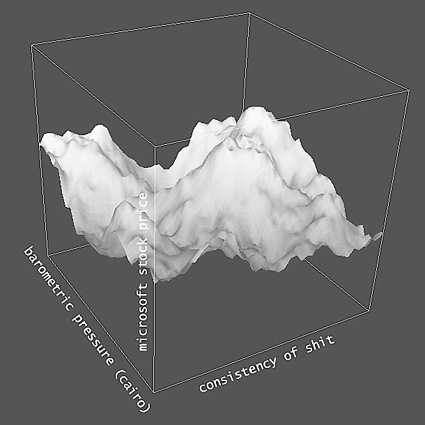
John Tonkin, A Grand Unified Theory of Self
A Grand Unified Theory of Self is a study of complexity theory. Interactive data analysis and visualisation tools will correlate personal details (amount of sleep, consistency of faeces, heart rate at moment of orgasm) with global indicators harvested from the web (Microsoft’s stock index, barometric pressure in Cairo).
I write software using languages such as C++ and Java. For this project I will need to develop Java-based data storage, analysis, charting and visualisation software. This will draw from source code and reference material available on the web, and involve consultation with research scientists from the Supercomputing Lab, ANU. The medium will be an interactive (Java based) online website but will also be exhibited as a more technically sophisticated installation with realtime 3D graphics and live data feeds.
John Tonkin began making computer animation in 1985. Animations include air, water parts 1, 2 & 3 (1993-95) and these are the days (1994). meniscus (1995-99) is a series of works exploring ideas relating to subjectivity, scientific belief systems and the body (http://207.225.33.116/meniscus -expired).
The project is the major component of John Tonkin’s Australia Council New Media Arts Fund Fellowship. Completion mid 2001.
memo
Sarah Waterson, Anna Sabiel
how can I touch you if you’re not there…
memo is an experiment about taking a performance installation environment and its incumbent physical experiences into a virtual environment. Conceptually memo draws upon ideas of physical memory and image triggers that are felt or interpreted in the body.
Through a VRML scaffold structure, memo presents short vignettes of image-based movements triggered by the users or, more accurately, the cursor’s proximity. memo is also an audio environment with specifically located sound. The user is immersed in a virtual ‘instrument’, their movement triggering a unique soundscape and mix depending on the path chosen. memo consists of multiple nodes branching out from the central scaffold structure. At present there is a VRML textspace with spatially presented hypertext links. Other nodes are planned to extend the present scope of the work.
Sarah Waterson is an installation/multimedia artist whose work deals with possible cyborg futures and the influence of electronic technologies on subjectivities. She is a lecturer in digital media, UWS Nepean and was a participating artist in the Brandon Project, Guggenheim Museum, New York, USA. Anna Sabiel is a Sydney-based performance/installation/sound artist. The interaction between body/movement and the production of sound has been a major concern of her work. Works include Tensile (originally devised for SoundCulture 1991) and Internalised Cities series (with Sarah Waterson and Shane Fahey). Currently Sabiel works authoring and designing educational CD-ROMs for the Board of Studies, NSW.
www.artspace.org.au/spaceinvaders/memo [expired] Launched June 99, Artspace, Space Invaders. New Media Arts Fund, Australia Council.
bodyssey
Gary Zebington
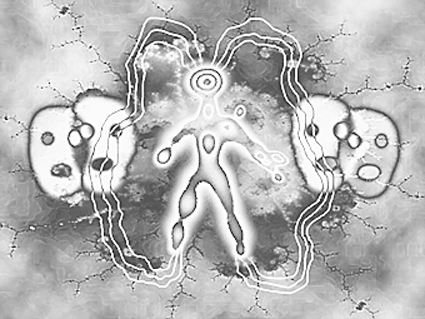
Gary Zebington, bodyssey
bodyssey is a CD-ROM (metabody phase 2) about corporeality’s meanderings through an ecology of post-and-pophuman ideas. Body forms transmute to thoughts and utterances encountered in a space of technological and wordly wanderings.
One challenge is to coax patterns or schemes of text/body relations from the intertwinings of a number of elements—vrml, responsive text, text-to-speech, speech recognition and non-linear sound. Another is then to let the schemes wander freely.
Gary Zebington arts and programs technological semi-fictions at travelling outposts and rarely encounters steering committees. Fellow bodyssey collaborators are Mary-Anne Breeze (mez), electrostatic artist and hypertext wordsmithess, and Andrew Garton, sound and media artist who creates net and generative works.
Completion 2000. Australian Film Commission.
RealTime issue #32 Aug-Sept 1999 pg. 9
© RealTime ; for permission to reproduce apply to realtime@realtimearts.net
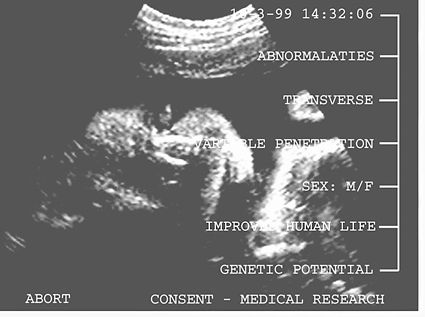
Michele Barker, Præternatural
Præternatural
Michele Barker
Præternatural aims to present a genealogical exploration of the cultural, medical, and scientific role of the monster in Western culture from the 17th century to the 20th century. Further, it questions contemporary contextualisations of the monstrous due to developments in the area of biomedical and genetic research.
Originally, Præternatural was designed to be a DVD-ROM work, a platform that would have allowed me to produce the piece without compromising on video and audio quality. Unfortunately, DVD-ROM is not so widely developed for the Mac platform, forcing me back to CD-ROM and all of its constraints.
Michele Barker works as an artist within the area of new media and her recent work on the monstrous will form part of a PhD. Exhibitions include Specimens at Artspace and State of the Heart at The Australian Centre for Photography. A former Digital Media Coordinator for the Museum of Sydney, she currently lectures in Photomedia at the College of Fine Arts, UNSW.
Completion October 1999. Australian Film Commission.
Cooking with Carmen
Tracey Benson
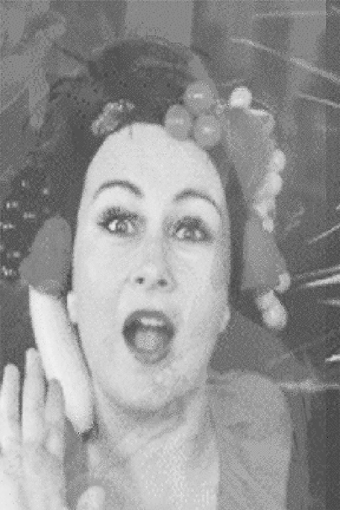
Tracey Benson, Cooking with Carmen
Cooking with Carmen is the latest in an ongoing project titled Big Banana Time Inc. which focuses on notions of identity and the role of tourism in promoting national and cultural archetypes. Cooking with Carmen intersects the relation of identity to self via the act of cooking, by analysing the act of consumption. This is an interactive web-based work aimed at broadening ideas around participation and collaboration by engaging responses from the audience.
There have been many challenges surrounding this project, on a conceptual and technical level. Primarily, I need to present a product which inspires participation. This is a general issue to all web developers, as is defining your audience, let alone getting them to your site.
Tracey Benson is a Brisbane based multimedia artist and curator. She has exhibited her work from the Big Banana Time Inc. project extensively to a national and international audience through exhibitions, performances and conference papers. Her new web-based work titled Bananarama2000 is currently being hosted at the new Experimenta Media Arts online gallery www.experimenta.org.
Completion September.
cipher
Linda Carroli, Josephine Wilson
cipher is a work of hypertext fiction which explores the thriller genre. The enigmatic M receives a series of mysterious emails from the equally enigmatic C over a period of ten days. With each message, M is further drawn into a web of political intrigue.
Challenges of producing online work include keeping it simple and relatively easy to negotiate; maintaining a focus on written text; ensuring that you hang on to your audience, create a readerly flow by constructing pages which download in a reasonable amount of time. Technical challenges include keeping up with what’s possible, trying to blend skills with creative development and decision-making.
Linda Carroli and Josephine Wilson collaborated online to produce the award-winning *water always writes in *plural. Carroli’s writing background is critical and non-fiction, while Wilson writes primarily narrative fiction and performance.
Completion, September 1999. New Media Arts Fund, Australia Council
Dream Kitchen
Leon Cmielewski
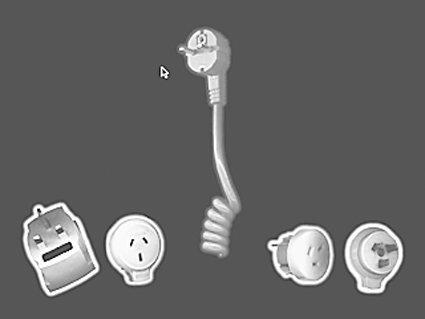
Leon Cmielewski, Josephine Starrts, Dream Kitchen
Dream Kitchen is an interactive installation. The interactive animation incorporates both 3D and stop motion techniques. It starts in an antiseptically clean “Mr Sheen” kitchen and then takes us to those areas where the moral cleansers can’t reach. Beneath the surface runs a parallel interior zone populated with inspirited objects. This subterranean zone could be interpreted in many ways: a catalogue of dread, a cabinet of memories, an archive of fantasies.
The challenge in this project has been to keep the freedom and directness of stop motion film animation while working within a computer interactive framework. Director/animator, Leon Cmielewski; producer: Josephine Starrs; programmer, Adam Hinshaw; sound designer, Panos Couros.
Leon Cmielewski and Josephine Starrs are artists whose work includes the new media installations User Unfriendly Interface and Diagnostic Tools for the New Millennium. Both separately and together they have produced work in various media which has been exhibited nationally and internationally.
Co-production with the Banff Centre, Canada. Australian Film Commission. Completion October 1999.
Los Dias Y Las Noches De Los Muertos
Francesca da Rimini with Los Fantasmos
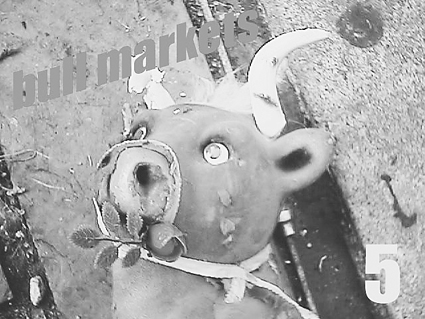
Francesca da Rimini with Los Fantasmos, Los Dias Y Las Noches De Los Muertos
we were a cipher in the big accounts of capital…the gigantic market of maximum irrationality that trades in dignities Zapatista text Los Dias Y Las Noches De Los Muertos (The Days And Nights Of The Dead); a collaborative online project—Adelaide/New York/Rome/Chiapas. A ghost work of counter-memories, opening thresholds of impossibilities outside of pan-capitalism. A drifting carnival of souls which gathers together the spectres of late capitalism, soft conspiracies, forgotten phantoms and digital Zapatismo.
More cultural and aesthetic than technical, as the technology is relatively simple—HTML code, framesets, streaming audio, CUseeme. Cultural—developing and looking after relationships amongst participating ghosts scattered over 3 continents. Aesthetic—striving towards the creation of a new genre, neither a poem nor a film but something inbetween.
Most of my work happens online—negotiated email relationships, online communities, ghost girls and riverboys, narrative architectures. With Marco Dereriis, recently completed a commissioned work acid test for the Wilhelm Lehmbruck Museum, Duisberg, Germany. Received a Fellowship from the New Media Arts Fund of the Australia Council for soft accidents, an exploration of some relationships between quantum physics and Indigenous knowledge systems.
All online projects linked to autonomous.org/~gashgirl [expired]
www.thing.net/~dollyoko/LOSDIAS/INDEX.HTML
VACF (Visual Arts/Craft Fund), Australia Council.
empiricosis
geniwate
empiricosis is a net-based cycle of text, image and audio which takes as its theme some of the ways in which science and art collide, and how science is visualised in popular culture.
empiricosis is a complex amalgam of text and other media. I am starting to create multiple outcome hyperlinked poetry mainly using Flash. I experience challenges concerning download time and streaming, especially since I am keen to incorporate audio tracks into the poetry, to be played concurrently with other media. A further challenge is presented by my extremely limited programming skills.
I started writing conventional poetry in the early 90s. This soon metamorphosed into performance poetry, and then to electronic ‘poetry.’ This journey has always been about amalgamating different media.
Ambitions for the future include developing a concept of installation poetry. I recently won the trAce/Alt-x International Hypertext Competition for my project rice. www.idaspoetics.com.au/rice [ex[ire]. I work as an editor at the University of South Australia.
www.adelaide.net.au/~slick/sitefrite/emindex.html [expired] Completion September 1999. Commenced during the 1999 ANAT Summer School. Further development facilitated via an online workshop: thanks Christy Sheffield Sanford and trAce (UK).
Joovin8
Michelle Glaser, Andrew Hutchinson, Marie-Louise Xavier
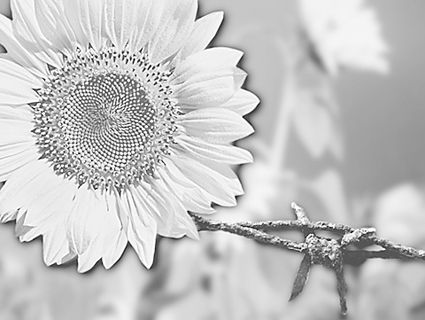
Joovin8, Michelle Glaser, Andrew Hutchinson, Marie-Louise Xavier
The Joovin8 CD-ROM is an interactive narrative featuring a series of hyperreal scenes which echo the intense sensory perception experienced by the dying. The thread of one life is depicted in a series of emotionally rich moments which explore the ever present duality of decay and rejuvenation. The episodic structure imitates the selective and non linear nature of memory. This gift of perception is bestowed upon the dying.
After double clicking on the icon to launch Joovin8, the mouse need never be clicked again. Narrative development is achieved by moving the mouse only. In Joovin8 feedback is incremental, not boolean. This means that the closer the cursor is moved to an image’s focus the higher the degree of reaction and feedback.
www.imago.com.au/tetragenia [expired] Completion September 1999. ArtsWA and the Australian Film Commission.
meme_shift#0
Teri Hoskin
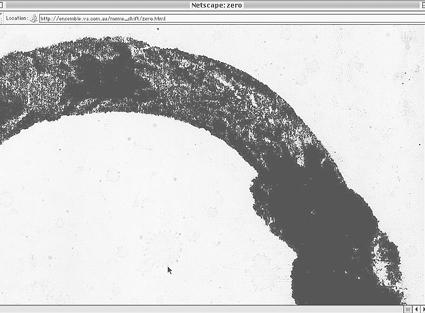
meme_shift#0
meme_shift#0 is an interactive website. It’s to do with an obsession with all things Japanese, as a site of the ultimate Western Other. The sources are historical, literary, philosophical, social and personal, and this environment, playing with the way we read a text, the way one can write. I’m still (always) working on and with this in the hope that a pattern will emerge. The work continues-in-process. I don’t have a deadline.
The challenge is to use the technology simply and elegantly, in such a way that tests the limits of language and meaning in a digital writing space: to push what I already know. To keep files as small as possible and to utilise all the writing spaces. Next step for meme_shift#0 is sound, simple. I want to make an atmosphere, a cinematic engagement.
Teri Hoskin is a visual artist/writer. She works with text, paper, Adobe Illustrator and a text editor (BBEdit) in contemporary gallery spaces and online. She is Editor for the Electronic Writing Research Ensemble, Adelaide.
http://ensemble.va.com.au/meme_shift An Adelaide Festival 2000 project in conjunction with ANAT, CACSA (Contemporary Arts Centre, South Australia), EWRE (Electronic Writing Ensemble).
Untitled
Matthew Johnston
The two CD-ROM projects are an interactive narrative and an interactive that depends on sound frequency and modulation. The first is a series of short scenes composed in a similar manner to a 3D crossword puzzle that allows the user to jump in-between tracks of video. The second uses frequency modulation to effect a 3D object in its environment.
The development of hierarchical structure needs to be a strong point of these projects to overcome a myopic time-line, but the most challenging aspect of both is the design of a 3D engine for the narrative’s platform and 3D modelling for the other. The programming is the most exciting aspect because of the foreign nature of V-B scripting.
Matthew Johnston originally trained in painting/drawing and sculpture at Newcastle Art School between 1994-5; over these two years he showed in a number of small collective exhibitions. He enrolled at the College of Fine Arts, UNSW, completing a BFA majoring in time-based art (film and multimedia), and was part of the AFC/ABC Stuff-art initiative for 1999.
Completion November 1999.
Observatine
Zina Kaye
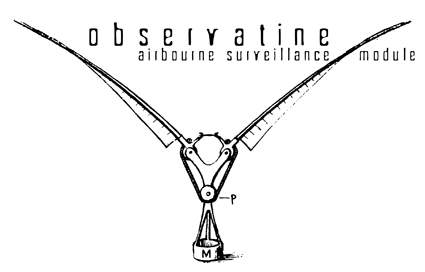
Zina Kaye, Observatine
Observatine is a flying machine that gives a viewer the experience and control of flying, via a bird’s eye view of the landscape. A pilot navigates by a projection on the floor. Since it is managed by a web-server, web-based viewers may be pilots and viewers.
This is an unmanned autonomous flying vehicle, and developing a completely untried system to manage it using the internet requires an enormous amount of team work from people with a great range of skills. Building a “roll your own” aircraft with respected members of the hobby community is humbling. One retired gentleman is the world’s most accomplished forager and has turned his unit into a tooled-up workshop for “greazys” and gliders. It’s like stepping into Chew’s cold room in Blade Runner.
Zina Kaye is a new media artist who uses sound composition, video and communications technologies to muse on the nature of metaphysical boundaries and the secret life of the inside. Integral to her practice is research into spatial interface and transport systems architecture. While broadcasting over terrestrial and internet radio, Kaye maintains a popular net.sound.art website with her partner mr. snow, http://laudanum.net/, housing a large collection of Australian and New Zealand sound content amongst online works and theory presentations.
observatine.net [ex[ired]will come online in August. Completion September 30, 1999. New Media Arts Fund, Australia Council and the Commission for European Communities.
Neonverte
Anita Kocsis
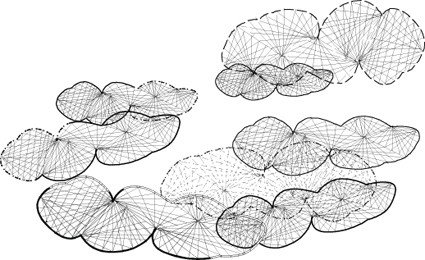
Anita Kocsis, Neonverte
Neonverte is a web based installation built as a garden—sometimes a neon evergreen, a fluorescent terrarium or a thorny ‘K-Mart meets Las Vegas’ undergrowth sewn with an organic structure. Stuff grows and dies, gets used and discarded. I tend to weed, restore, defrag, reload, plant and graft. Neonverte is perishable. A compost of interconnections has begun through working online.
Neonverte is built predominantly utilising Macromedia Flash 4. A combination of animations, sound, and Javascripts are used. QTVR and VRML animations initially for the site have resulted in video format utilised in installation rather than sitting in the ‘plug-in’ dependent corner of the web garden.
Anita Kocsis has worked in installation and painting within a digital context. She investigates “immersion environments” with emphasis on the collisions between spatial constructs in painting and virtual environments. Her own work and collaborations as a nervous_object have furthered her interest in the prismic modality of an online practice.
Neonverte is part of the Login series of residencies at 200 Gertrude Street gallery in Melbourne. Login is supported by the Visual Arts/Craft Fund of the Australia Council and ANAT. It aims to assist visual artists in the development of web based projects.
The Neonverte residency commences August. www.anat.org.au/projects/login/anat_anita/neonverte [expired]
Mr. White’s Diary
Derek Kreckler
“Mr. White’s Diary: an incomplete view of the end interplays text and image in an engrossing unfolding of the last hours/words of Mr White: a bleakly entertaining suicide trip through diary, crumpled notes and screen messages that in another time, other media, might have been scored by a Peter Handke or Thomas Bernhard.” (Ed.)
Mr. White’s Diary is a work in progress in the traditional humanist sense. And…oh…yeh we are still working on it! We have to somehow get it to work on Internet Explorer I am sure the Netscape users will catch up but I.E. users will have to wait because these two browsers are now quite different. This work is impossible to view without Flash 3, QT3 and QT3VR plug-ins; the browser should only be Netscape 4.5+. The site uses mainly Flash and is indicative of where the web will go in the future. The site is experimental, of poor temperament, but delicious.
Derek Kreckler is Co-ordinator Electronic Arts and Information Technology Management; Chairman, Academy Research and Development Committee, WA Academy of Performing Arts. Edith Cowan University.
www.working.com/spaceinvaders/white [expired] Opened June 99, Artspace, Space Invaders. New Media Arts Fund, Australia Council.
Fan Girl
Dooley Le Cappellaine
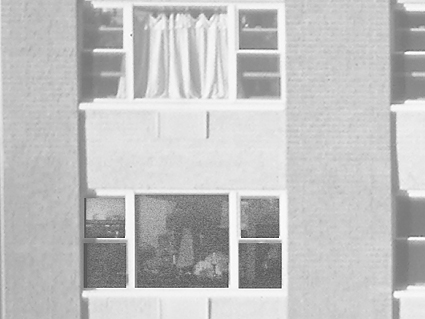
Dooley Le Cappellaine, Fan Girl
Fan Girl is a CD-ROM work. In January 1995 I began to take a photograph each day at a different time of the progress of a building going up across the street. I was waiting for something to happen. Finally it did. The building was complete, destroying half my view of the New York skyline and I began to consider moving. I noticed that due to the remarkably shallow architectural plan of the apartments across the street, the occupants were almost on permanent public display. The building took on the fascinating aspect of an antfarm and I soon had names for my favourite characters. (I don’t watch TV.) My favourite was the “fan girl.” I first noticed her on a bright early afternoon performing spectacular sex almost on the window ledge. This went on with amazing regularity always with a new partner. Eventually she found a boyfriend and gradually the performances tapered off; it must have just been a phase in her life; things change.
One of the things I had been thinking of while working on some interactive projects was how passive and ingratiating most art for walls is and also how “interactivity” is generally just click/reward/click/reward. I began to study programming in Director earnestly for a way to make the “fan girl” an artwork which would operate according to its subject matter, voyeurism. After about a year I was able to write the program: at specific times (day/month) uncontrollable by the viewer the work will change to show a different episode in the life I observed for a time.
Dooley Le Cappellaine is an artist who has exhibited internationally and curated Technophobia, the first independently produced interactive exhibition of original multimedia works on CD-ROM. She is currently curating a program of web art works at http://www.thing.net/dooley [expired]
SonteL
Mike Leggett
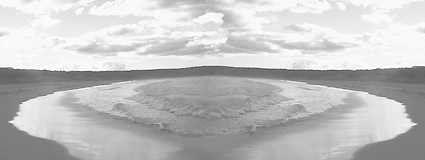
Mike Leggett, SonteL
SonteL (working title) is an interactive multimedia work, a prototype CD-ROM. Landscape is the mediated image, a representation central to beliefs and identity within Australian culture both Indigenous and non-indigenous. Through a dynamic and interactive process of presentation, intersections are made with interpretations and mediations about The Land. In collaboration with Brad Miller, Adam Hinshaw, Alex Davies, Bruno Koenig and Kathryn Wells.
The navigational precept involves the technically complex intersection of four Quicktime movies at any one time—sequenced images which take the user forward through the landscape, or back through the route just travelled. Or a 360 degree view visible from various key zones, panning either to left or right. This continuous pan is a morphed image of landscape which enables, as an option, access to various series of short narratives (topographies of knowledge), associated with the land, its many appearances, its many histories.
Mike Leggett has been working across the institutions of art, education, cinema and television with media since the early 70s. He has film and video work in archives and collections in Europe, Australia, North and South America and practises professionally as an artist, curator, writer, director, producer, editor, photographer, teacher, manager, administrator and computer consultant.
Prototype completed with the assistance of the Australian Film Commission in June 1999, project completion 2000.
The Glass Bell
Sophea Lerner
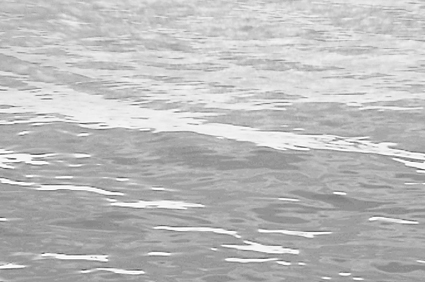
Sophea Lerner, The Glass Bell
The Glass Bell is a gesture-driven, audiographic installation. It comes out of stories which resonate through the lives of three generations of women in the artist’s family. It is a fictional poetic construct, an underwater archaeology which explores the role of stories as placeholders for the unutterable, for what falls between languages and places when we leave. It will comprise a large ‘touchscreen’ (about 1m x 1.5m) with water running across it. Diverse gestures on this surface will effect various changes in the audio, narrative and visual elements. The audio was developed first during a residency with The Listening Room in 1998.
There is no such thing as a touch screen that big so we have to start from scratch designing and building the hardware and the interfaces. Another challenge has been designing the software component to be flexible and modular enough to use as a compositional tool for flexible duration work, not just to stick everything together after decisions have been finalised. To be operated from a Powermac 7300 with a PC running part of the interface to the screen hardware and a K2000 carrying a fair chunk of the audio processing.
Sophea Lerner, an artist and broadcaster with a special interest in flexible duration audio works, has spoken internationally on sound design for new media and was last year’s Australia Council New Media Arts Fund artist in residence with The Listening Room. Collaborators for The Glass Bell include artist/engineer David Bartolo and programmer Ryan Sabir.
Completion early 2000. New Media Arts Fund, Australia Council
RealTime issue #32 Aug-Sept 1999 pg. 8
© RealTime ; for permission to reproduce apply to realtime@realtimearts.net
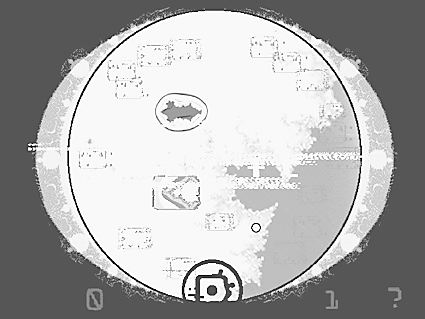
Kathryn Mew, Muto
Muto
Kathryn Mew
Muto is a hyperreal planet, a hybrid of the digital and the organic. Gameplay is highly experimental, using a three dimensional navigation system, textless interface and interactive themes of creation, mutation and destruction. The user is invited to explore Muto’s simulated environments. Red represents corporeal, an environment of breathing, breeding tissue. Green represents earth, a habitat of fertile soil, and flourishing plant life. Blue represents water and the atmosphere. Black represents a world of creation on the smallest of organic molecular levels. White represents an opposing pole of digital reproduction.
Muto, a CD-ROM, began as a post-graduate project (RMIT). The major challenges have been to push the capabilities of the commercially available software (Macromedia Director) to match my vision, and to keep up with new versions of the product as the deadline blows out. Holding down full-time employment and/or freelancing within the multimedia industry during the production process has also been difficult for final completion of the project. Although the work is not yet completed, I have managed to have it exhibited in several national and international multimedia exhibitions (also a lot of work in itself), which helps drive me toward completion.
Kathryn Mew is a Melbourne-based designer. Her main areas of research include interface design, experimental virtual environments and digital culture. Her work ranges from websites to live theatre video support, to CD-ROMs and has appeared in Kabaret Internet in both Munich and Cologne, the Downloading Downunder exhibition in Amsterdam, the Next Wave Festival in Melbourne, dLux Media Arts’ D.art 99 and the ARS Electronica Life Science exhibition Linz, Austria.
Completion December 1999. Australian Film Commission.
Volcano: Shifting Ground
Maria Miranda
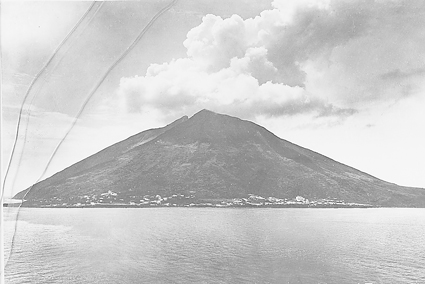
Maria Miranda, Volcano: Shifting Ground
This installation will use the volcano and its shifting ground to explore cultural questions of uprootedness. It will play with notions of surface and depth. Volcano is also a metaphor for the way new media art shifts the ground materially and conceptually. Computers normally map geological activity and volcanism; in Volcano a fissure will be opened up by/in the technology.
One of the artistic challenges will be to find a form of interactivity that poetically expresses a shifting ground, its disruptions and eruptions, rather than following narrative paths. One of the main technical challenges is to explore the different grounds and/or materials of an image through scanning and downloading and to explore the interaction of images and sound.
Maria Miranda is a visual artist working in new media art. She was the visual artist on the award winning CD-ROM Shock in the Ear. She is currently collaborating as visual artist on the new media art installation Dead Centre: the body with organs, and on Dina Panozzo’s performance with interactive media, Monster Mouth.
Completion July 2000. New Media Arts Fund, Australia Council
Wunderkammer
Anna Munster
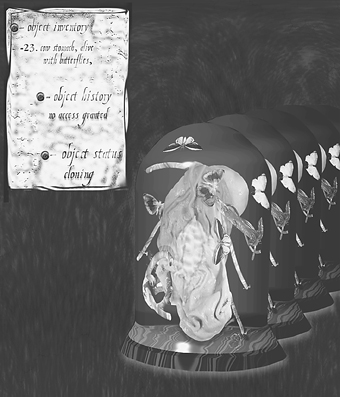
Anna Munster, Wunderkammer
Wunderkammer is an experimental interactive for CD-ROM. Using the visual metaphor of a baroque Cabinet of Wonders, it encourages the user to explore labyrinthine digital spaces and to collect bizarre specimens. These can be used to furnish the user’s own virtual cabinet. While the user wanders and constructs, the specimens take on a life of their own displaying surprising and destabilising behaviours.
Wunderkammer uses both game and behavioural elements programmed in Director and using Quicktime VR interfaces supported by relational databases to inquire into curiosity and wonder. Technical challenges involve the smooth integration of graphics, sound and movie databases into CD-ROM format.
Anna Munster is a digital artist and writer living in Sydney. She has exhibited at Artspace, Australian Centre for Photography in Sydney, Kawasaki City Museum in Tokyo, and most recently at the 1998 Melbourne Festival.
Completion April 2000. Australian Film Commission.
Archiving Imagination
Robin Petterd
Archiving Imagination is an online exploration of the process of collaboration between web authors Robin Petterd (media artist) and Diane Caney (writer). The project incorporates visual and verbal language, utilising and interrogating terms such as intertextuality, interdisciplinarity, net-poetry and the internet.
Documenting the process of collaboration is not a simple task. We have used sound, text and images to record meetings and versions in an attempt to show our thinking processes, but the enmeshing of ideas goes beyond these encounters.
Robin is doing her PhD at the Digital Art Research Facility at the Tasmania School of Art on a project that explores the relationships between what is organisation and dis-organisation. After completing her doctorate in 1997, Diane became intrigued by the medium of html. She began working with Robin in 1997.
www.archiving.com.au Completion August 1999. New Media Arts Fund, Australia Council.
Uncle Bill
Debra Petrovitch
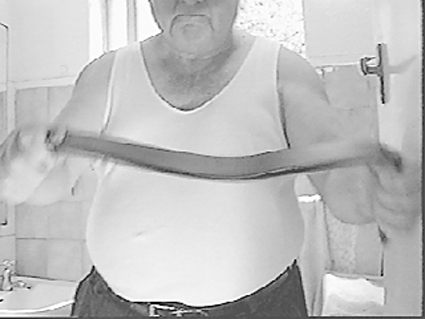
Debra Petrovitch, Uncle Bill
Uncle Bill is an interactive CD-ROM, a semi-autobiographical account of growing up in Wollongong during the 1960s, based on a performance text by Sydney sound artist Debra Petrovitch. It is predominantly a sound and visual artwork set against a harsh industrial backdrop and violent domestic situation. Uncle Bill is aimed to be exhibited within an installation context. A wider audience for Uncle Bill are domestic violence groups and support networks for survivors of child abuse.
Uncle Bill includes text screens, original sound pieces, video, animations and archival footage. Director, Debra Petrovitch; interactive designer, Wade Marynowsky; producer, Julianne Pierce.
Debra Petrovitch is a visual, sound and performance artist who has exhibited widely as well as producing independent soundworks and commissioned film and video soundtracks. Wade Marynowsky is a digital artist currently completing a Master of Fine Arts at College of Fine Art, Sydney. Julianne Pierce is an interactive media artist and producer and part time Project Co-ordinator at The Performance Space, Sydney.
Completion December 1999. Australian Film Commission.
intelligence agency
Julianne Pierce
An online portal, video and performance project currently in development, intelligence agency is an interactive media project, a host site for information corruption and counter-intelligence. The participants are female identities who (under)mine data, capital and IT economy. Currently acting as a research and transmission hub, intelligence agency is a contact point for identities wishing to continue their highly visible activities by remaining totally anonymous.
Julianne Pierce is an interactive media producer, artist and curator, a founding member of the collaborative computer art group VNS Matrix, and has presented work at international exhibitions and conferences including ISEA and Ars Electronica. In 1997, she was a co-ordinator of the 1st Cyberfeminist International (Hybrid Workspace) at Documenta X in Germany. She is currently producing an interactive media project Uncle Bill with sound artist Debra Petrovitch; developing the Digital Artstore distribution project with Jeffrey Cook (3V Media). She is also part-time Project Co-ordinator at The Performance Space, Sydney and is a Board member of the Australian Network for Art and Technology (ANAT) and Artspace.
www.intelligenceagency.org [expired] New Media Arts Fund, Australia Council
Escape from Station E
Irene Proebsting
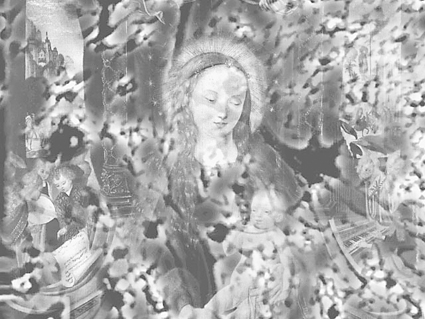
Irene Proebsting, Escape from Station E
An interactive CD-ROM based around the themes of industrial decay, work practices and gender issues, coupled with biological and technological experimentation. I have drawn on various ideas from textbooks, news items, cinema and historical documentation and presented them as an abstract series of events using a variety of stylistic elements from collage to sci-fi movies.
Using Macromedia Director as the main assembly program and incorporating scanned images, collage and 3D, I have created an environment which will enable the user to explore various spaces and activate animations linking different images and themes. Lingo scripting, image manipulation, 3D modelling, sound & video capture, editing & animation have been the challenges of this project.
Recent exhibitions: S8 film screenings: 1999, Ultraprojections 2, Melbourne; 1998, XLR8 Summer Salon, CCP, Melbourne, Traceable Emissions, Queen Vic Women’s Centre, Melbourne; 1997, SURPRISE International Short Film Festival, Taiwan; 1996, Dispersions, Erwin Rado Theatre, Fitzroy; Viva 8, London Filmmakers Co-op, Toynbee Hall, London.
Completion late 1999.
As I May Write
Sally Pryor
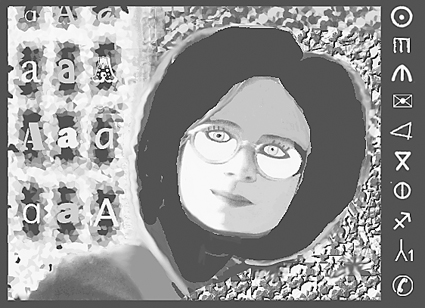
Sally Pryor, As I May Write
As I May Write is an experimental and interactive art-work about writing systems and the human-computer interface. Explores histories (earliest graphemes, “Picture Writing”), contemporary visual languages (Blissymbolics, logos), relevant theories (hypertext, semiotics), and possible applications of “intelligent” icons in an interactive media space.
My biggest challenge is that I make art in order to find out what I think/feel about something. So I can’t do detailed technical and artistic planning before starting. I have to program it, “look” at it, re-program it etc in a spiral process that works for me but makes team work difficult. The medium will probably be a combination of CD-ROM (for the bandwidth) and interactive online (for the connectivity and fluidity).
Sally Pryor is an artist/programmer and independent multimedia developer with an eclectic background including biochemistry and 3D computer animation. Her most recent work was the internationally award-winning CD-ROM Postcard From Tunis.
www.ozemail.com.au/~spryor/write.html [expired] Completion December 2000. New Media Arts Fund Fellowship, Australia Council
RealTime issue #32 Aug-Sept 1999 pg. 5
© RealTime ; for permission to reproduce apply to realtime@realtimearts.net
Art and I sit down to sample the delicacies of the internet. We are on a mission. Open up Copernic, a groovy little download which manoeuvres through all the search engines at once, and enter the exact phrase “Australian porn.” Hotbot. Excite. Altavista baby. We’re on the path to fulfilling desire…
1. http://www.erotic-movies.ahost.net/index.html [link expired]
Free Nude Teen Thumbnail Galleries. This is first on the list, and I’m trying to imagine the appeal of looking at grotty adolescent fingernails. My own are raggedy around the edges—must book in with Carmel, my nail technician. Click here for more porn than you can shake a dick at. The technological sophistication is astounding. Click on the butt—FUCK my Ass is revealed bottom left of screen. Calling all BUTTmen—some sort of extra terrestrial lifeform perhaps? That’s a banana, Art cries accusingly. This site promotes teen sex which means teen girls having sex for the very first time apparently. While promoted as being very young and all virgins, the disclaimer at the bottom maintains that all models are 18 years or over. Almost teens. Net Nanny software links mean cruising fathers can feel assured that their precious teenage girls are safe.
The women look like aliens. They have strange black blobby shapes over their bodies. Pixelated pussies. Live pornpourri. FREE to all members. We eagerly click on How To Join. Receive FREE newsletter: Sex Files. We enter the required information. Name. Email address. Birthdate. Password. Member name. joblow15 is ready to rock and roll. Other porn sites keep flashing up. Close a window, a new site jumps in the fray. Cafe Flesh. XXX world. Virgin sluts. Jesus Christ, Art keeps exclaiming, they’re popping up from everywhere, his fingers juddering crazily on the mouse. We’re now one step away from seeing live teen sex, but what’s this? Credit card details for legal age verification. Oh, Art moans. He’s never let us have a credit card. Always insists on paying everything in cash. He likes to keep control of our budget and expenditure and you know what women are like with plastic! We can’t get to the tele-fucking level but we can get free XXX pics delivered to our email box. We set up a hotmail account and joblow15 gets delivered. Who can resist the promised land: potty shots—hidden cameras reveal young girls going to the bathroom (a blondie sits on tiles, next to the loo, legs spreadeagled, looking straight at us!). Va Va Voom.
2 http://www.alsscan.com/ [accessed 1999]
Warning, warning, warning. Stop. Do not access. You must be 21 years or over: “if you are accessing from any country where adult material is specifically prohibited by law, go no further.” All these reminders are a bit of a dampener to the drive, darling. I sign a form stating that I am not a US postal officer or law enforcement agent and will not use information as evidence for prosecution of individuals or for the purpose of entrapment. Well, it all depends, really. I started hiring a private detective to follow Art when I found various items of my lace underwear missing. I am visitor number 31,759,980, part of an intimate club almost twice the population of Australia.
Art tries to download Jessica’s shoot right to our computer. Here’s Amy, “wild crazy…watch her lean back and piss into a glass bowl.” Look at the quality of that scan, Art cries, zooming into a pierced nipple. They use digital cameras, the site says proudly, giving a quick plug to the Sony VX 1000. See pissing, fisting, bottle and veggie insertions, and a speculum. Which reminds me, I must book in for that pap smear which I’ve been putting off for years. Those blasted ads on TV make me feel guilty. If I do get cervical cancer, apparently I won’t have an excuse if I don’t go every 18 months. I have to certify that “anal sex, urination, vegetable and bottle penetration and fisting, do not violate the community standards of [my] street, village, city, town, country, state, province or country.” I am nervous about this. Perhaps we should do a quick survey of Hope Street, Art suggests. Mmmm Hope Street. I always suspected he had a bit on the side with that tart who lives opposite the RSL, the fake blonde with the German accent and red stilettos. Aaaah, ooooooooh, 2 girls are engaged in a lip pulling contest and then there’s the carrots. Eggplants. Zucchinis. Squash. Art reckons this site’s so hot he’s going to cook a stir fry tonight.
3. Video licking free XXXX SheMales
We want to watch Pammy and Tommy’s home video, see live video channels, find out more about that blonde bombshell lying in a fog filter with a finger placed delicately in her mouth, and look at those millions of hidden cameras: inside toilets, under desks, in the tip of a dildo. But that blasted credit card screen comes up every time. (Meanwhile, Tina Tripoli has delivered our bi-weekly Sex Files newsletter and we reply to receive pics.) Butts, boobs, beavers and more pop ups, “perverse and on the fringe of decadence.” Cheri in The House of the Rising Cum. Teenfacials and tittycities. A flash tour of booptropolis. Use your powers of deduction to select the natural redhead (it’s not as easy as it sounds).
4. http://rosie.ozsex.com/australia/ebony305/porn.html [link expired]
At last some Oz porn (which was what we were looking for in the first place but it’s so hard to find). A definite Oz flavour with “stacks of real life roots.” Suck for free samples, lick my whip, and I’m transported back into Penthouseville, circa 1982, with the reader’s input: 1st prize winner goes to Pantyhose vs Stockings where a man seduces a woman in a library who “has A format beautiful breasts.” So that’s why Art spends so much time at the State Library. I always thought he went there to take notes for his Business Management course. We find other Aussie links: Urination nation; Transvestites, “yes, that is both pieces Tackle and Snatch”; and Pregnant women. Adult Check. Age Check. Ishield. Adult Age. Christ, what happened to the age of instant gratification, Art cries, scrummaging in the drawer for his cheque book.
5. http://www.3d-entertainment.com [link expired]
Art says he wants to see more multimedia, audio and video. The use of sound has been most disappointing. I guess gasps of pleasure are more intrusive than photos of a woman chained naked to cane furniture, dog-collar-linked to her terrier. So we visit a site which has porn in Stereoscopy and Virtual Reality: “A review of images in stereo format allows us to look at the even common things from a new perspective and get quite different kicks. Especially it refers to Erotica. The sense of reality makes them especially Piquant.[sic/k]” Art immediately perks up and puts on his blue and red glasses, saved from the Three Stooges TV special a few decades ago. The 3D effect reveals a girl tied to a boat backdropped by a beautiful deep blue sky. She looks cold, her goosebumps through the glasses big bright boils. Click to Enlarge. Every man’s dream. She has pubic hair. Art recoils, and it is a bit of a shock after the shiny, sanded and polished pubises of the American teens, as denuded as the Daintree after a bulldozer has torn through. The Virtual chat room is unfortunately out of order, but a new nude avatar world is on its way. You no longer need to go to Gentleman’s clubs or Woody’s car wash to ogle topless women. That’s good news for Art, who pretends he’s going to the TAB, but I’ve seen photos of him at Hooters. He’s gone now…up the street to pick up a few vegies.
RealTime issue #32 Aug-Sept 1999 pg. 31
© Ivana Caprice; for permission to reproduce apply to realtime@realtimearts.net
It seems that one of the few ways to see new international film and video work these days is to step offshore from time to time. The artificial and unnecessary separation between film culture and ‘new media’ culture which has occurred in Australia in recent years (due largely to funding policy) has meant that festival events are determined along media lines, which means that little experimental film has been reaching our shores for quite some time. As somebody who admits to being promiscuous (ie working across film, video and digital media) and who enjoys playing with the differences as well as the points of intersection between these media formats, I’m relieved to find some international festivals which strongly support cross-media programming styles.
A few major European festivals with film origins seem to have transcended these boundaries and are providing audiences with strong and varied film and video programming. In particular, I’m referring to Impakt in Utrecht, Netherlands, which also includes an impressive music component, and the European Media Arts festival in Osnabrück, Germany.
The 1999 Impakt featured many works which were creatively exploring the points of intersection between ‘old’ and ‘new’ media, rather than rejecting one for the other. Kodwo Eshun (who also recently spoke at the Cinesonic conference in Melbourne—see RealTime 33, October-November) referred to McLuhan’s “realization that obsolete tech becomes the artform for the present.” This may be true, but many artists working with digital sampling technology are retaining a strong interest in the live performance, the screening event, and the live audience.
Likewise, I doubt that the cinema as a screening site for film and video will ever really become obsolete, since humans enjoy the act of seeing and hearing and communicating in public zones. What is the place of web-based art in this equation? A recent ‘opening’ in Sydney of work attracted a mere handful of visitors. However, at both EMAF (European Media Arts Festival) and Impakt, installation, web-art and CD-ROM managed to happily co-exist with the screening programs, with EMAF also hosting a VRML art exhibition.
Some of the themes regarding technology and degradation evident in the excellent music programming at Impakt (see our website for Merewether’s account of this. Eds) were also reflected in the films presented at both EMAF and Impakt. In Matthias Müller’s Vacancy (Germany), a meditation on Brasilia, the “city of hope”, or “ultimate utopia of the 20th century” (Eco), the filmmaker matches images from 60s feature films with identically framed shots in the present, highlighting the processes of transformation from utopia to dystopia, of the failed modernist social experiment. At Impakt, Gerhard Holthuis’s Hong Kong—HKG used stunning black and white cinematography to explore the bizarre incongruities of scale and context which occur as jumbo jets land at Hong Kong’s (now closed) Kai Tak airport. The planes are both overwhelming and ‘as light as angels’, a threatening presence as they cruise in through the rows of high rise apartment blocks.
David Gatten’s What the Water Said nos 1-3 (USA) was created by placing raw film stock into crab baskets and allowing the sea’s wave action to act upon the surface of the celluloid to create both image and soundtrack. Likewise, Jürgen Reble’s Zillertal (Germany) was created by exposing an old 16mm trailer to the weather and to chemicals, exploring the processes of disintegration and reformation of the image. Jeff Scher’s Yours (USA) also utilised a piece of found footage, a 1950s music clip, to create a stunningly vibrant film overlaid with pop iconography, wallpaper textures and painted surfaces from the period. These are all examples of process-driven filmmaking, deeply tied to the materiality of celluloid, and so much richer than the trend towards digital scratch and dust effects ‘applied’ to video footage to give it the ‘appearance’ of film.
A work which seemed to put pressure on the medium to the point of breaking, was Sam Easterson’s A Sheep in Wolf’s Clothing (USA). Intriguing in its presentation of a sheep’s-view of life from within a flock, this work is one of many produced by his Animal Vegetable Video organisation, which aims to capture video footage taken from the perspective of every living plant and animal on earth (ambitious!). Other than the unusual point of view, the most interesting aesthetic quality of this work emerges from the fact that the video and audio apparatus cannot cope with the jerky running motion of the sheep ‘host’, thus when the sheep runs with the flock, violent blackouts and interruptions to the soundtrack occur. The randomness of these digital blackouts and intersected ‘baa’ sounds, caused by violent camera shake, led to an amusing level of absurdity.
Bob Arnold’s Morphology of Desire (USA), also shown at Impakt, and winner of the Best Experimental short at the Uppsala festival in Sweden last year, combined digital and film processes in its morphed imagery derived from romance novel cover art. The complex relationship between the reader (viewer), and the poster-painted romantic heroine, is wittily explored. Arnold’s use of sparse sound effects, breaking the rhythm of the pulsating heartbeat which drives the morphed transitions between images, is, as ever, curiously engaging. The finished work, with its digitally morphed transitions, was filmed as an animation, frame by frame with a Bolex camera, for the final translation back to 16mm.
A special program in Impakt, The Experience, was dedicated specifically to stimulating the body into perceiving unusual physical experiences and mental sensations, for example in Mark Bain’s Transient Vehicle, a shipping container fitted out with various oscillators, into which the audience was locked and vibrated. On another occasion, Klaar van der Lippe led groups of participants on a blindfolded tour though the city of Utrecht. Cyrus Frisch, a Dutch video artist whose work pushes the boundaries between himself as ‘director’ and his subjects, mostly disabled drug addicts, allowed himself to be hypnotised in public to exorcise some of his demons. Joe Gibbons (USA), in his 1979 8mm film Spying, forced the viewer to reconsider his/her collusion with the filmmaker, whilst participating with him in secretly spying on ordinary people in the act of, amongst other things, lovemaking or sunbathing. These varied events successfully extended the range of activities a contemporary festival can offer audiences.
Oddly enough, the most common enquiry I had from curators from the USA and Europe was “Where have all the Australian film and video artists gone?” Obviously, our funding climate, which heavily favours interactive formats, is adversely affecting the balance of local production, and has meant that filmmakers such as Paul Winkler are almost the sole representatives from Australia in these festivals. At the Ann Arbor Experimental Festival in the USA recently, Sydney films took out three of the awards, and all were self-funded by the filmmakers (Winkler’s Rotation, Greg Godhard’s Mind’s Eye and my own Cheap Blonde).
At events such as Impakt, it seems that the integration of film, video, digital media and sound/music events in the one festival encourages debate, and acknowledges the processes of cross fertilisation between formats, a dialogue, which, in Australia, does not seem to be occurring very frequently. The separation of ‘film festivals’ from ‘new media’ events is unfortunate, as digital art screenings are looking more like showcases of visual effects rather than explorations of ideas, and local filmmaking suffers from a paucity of visual ideas. In the meantime, I’ll happily continue to be suspended in the crossover zone, enjoying the best of both worlds.
Impakt, Utrecht, Netherlands, 11 – 16 May; EMAF Festival, Osnabrück, Germany, 5 – 9, May.
RealTime issue #32 Aug-Sept 1999 pg. 13
© Janet Merewether; for permission to reproduce apply to realtime@realtimearts.net
“if [the cartoon film] belongs fully to the cinema, this is because the drawing no longer constitutes a pose or a completed figure, but the description of a figure which is always in the process of being formed or dissolving through the movement of lines and points taken at any-instant-whatevers of their course…it does not give us a figure described in a unique moment, but the continuity of the movement which describes the figure.”
Gilles Deleuze, Cinema 1: the movement-image, Minnesota UP, 1983
“Animation is not the art of drawings that move but of movements that are drawn.”
Norman McLaren.
Let us work with these two definitions to think about the convergence of cinema and animation that is taking place in contemporary action cinema and television, a convergence which is redefining the relations of production and post-production, and therefore the pro-filmic event itself. The first definition comes from the philosopher, film theorist, Gilles Deleuze and the second from the animator and animation theorist, Norman McLaren. Taken together the definitions indicate a point of convergence, conceptual, but nevertheless real, between cinema and animation. Gilles Deleuze’s definition of the “cartoon film” is presented in the context of a definition of the specific qualities of the cinematic image. The first thing we notice is how close it is to McLaren’s definition of animation—the first proposition of a theory of animation. It presents, I think, an essential inversion of the concept of animation as making animate things that are inanimate. The first thing we notice is how close it is to Deleuze’s definition of the cinema.
For Deleuze, cinema is defined as an art of movement, its distinguishing feature as an art; its distinct modernity is that it introduces movement into the image, “it makes movement the immediate given of the image. This kind of movement no longer relies on a moving body or an object which realises it, nor on a spirit which reconstitutes it. It is the image which itself moves in itself.” (Gilles Deleuze, Cinema 2: the time-image, Minnesota UP, 1985) Deleuze’s definition of the cinema is “animatic” because its material is movement and movement can only be described not represented.
For McLaren animation is also defined as an art of movement, of drawing movement. This definition is an inversion of the notion of making the inanimate animate because it refers animation to the animate. It is precisely the animate that is drawn, but not in the sense of an outline or in terms of figuration, but, to use Deleuze’s term, figurally. Drawing works with movement, with transitions, with those moments when indistinction is the rule. McLaren’s definition of animation is cinematic because it throws attention onto the relation between images, into the gaps in the frames—the explicit topic of his second proposition. Deleuze and McLaren’s definitions of animation as cinema, and cinema as animation, converge on the concept of drawing movement.
It is in this sense that animation and cinema can be said to be forms of drawing and that drawing is a means of expressing the contours of things and not representing the state of things in fixed images that happen to move. The representation of objects is less important than unleashing the forces that constitute them, and which do not appear on their surfaces. This task of “rendering visible invisible forces”, an aesthetic borrowed by Deleuze from Paul Klee, is the sense in which drawing functions in both definitions of animation. And it can provide the basis of an examination of the convergence of cinema and animation which is presently taking place with the increased utility of new media technologies. Martin Scorsese often refers to the camera as a brush and the shot as a stroke. Film theory has investigated the notion of the camera as stylus. McLaren seemed to eschew the camera by drawing directly onto the celluloid, but it seems in doing so he was not so much replacing the camera as reinventing its function as descriptor not recorder.
From Clouzot’s Picasso to The Matrix
A remarkable example of what I mean by the convergence of cinema and animation can be found in Henri-George Clouzot’s film, The Mystery of Picasso aka The Picasso Mystery. This is an untimely example from film history. It was made in 1956, but it points to the convergence under discussion albeit from another direction. Clouzot sets up a unique convergence of animation and cinema by situating Picasso on the other side of a sheet of glass that is inserted between himself and the camera and which serves as a frame for the camera. Picasso then goes to work drawing in black on the surface of the glass. What is henceforth presented is not so much the process of the production of an image of a bull or whatever, but a temporal series of movements of hand and line. And it is the movement at the heart of Picasso’s drawings that emerges as the strictly artistic component of the film. Drawing is here as an art of movement. It is cinematic and animatic.
We can in fact go a step further and argue that one of the effects of new media technology is precisely the production of this drawing-effect. Clouzot’s film could be used as a model of computer animation. The upshot of this would be that the big budget action-suspense or action-adventure film (which seems to be where the more grandiose animatic effects are happening) would become more and more animated, more and more like the ‘cartoon film’ described by Deleuze and more and more the fulfilment of McLaren’s notion of “movements that are drawn.” One only needs to watch The Matrix to appreciate that bodies and objects can be presented as drawn movements. I am thinking here of the cascading code but also of the Reeves character’s ability to slip in-between and in and out of the motion of things, of the trajectory of objects, and to perceptually liquefy the space around him.
The expansion of post-production beyond the status of supplemental facility (if it ever was this) which has accompanied the rise of outfits such as Animal Logic attests to the possibility of a radical transformation of the ‘content’ of the cinematic image—a transformation which extends beyond the invention of DVD and tele-visual screens to the very definition of the image, and the pro-filmic event. This scenario would not herald the actorless cinema but rather a cinema where the actorliness of the actor is constituted at a very different level.
This is not to say that realism is dead, or even dying. Animated effects play a strong role in sustaining or deepening the sense of reality that the cinema and television are offering viewers. Ally MacBeal for instance, presents an order of mental-caricature through the animation of thought-clichés. Antz offers an infantilised notion of the colony of individuals which is Spielberg’s trademark narrative of American social formation. Animation is being used to resuscitate not only the careers of screen actors by transforming them into voice-sketch combinations but also to strengthen the claim of verisimilitude in a wide array of projects.
The convergence of cinema and animation which is envisaged through the definition of drawing movement does not take place at this level but it is clear that animation is reinvigorating cinematic realism. The Matrix remains realist to the extent that the cascading code seeks to articulate what is assumed to be already there, the matrix and the web of plug-ins, be they objects, bodies, or the actions of bodies on objects and vice versa. If I use my credit card to buy a bottle of wine from a bottlo I set in motion and interact with all manner of cascading codes, the codes of purchase, the codes of credit and debit, of stock control, the linguistic codes of the transaction between salesperson (whose name appears on the register) and purchaser (whose name appears on the bill), the codes on the label of the bottle, especially the one that reads 1.5 litre, the codes which differentiate wine from other forms of alcohol, etc. The Matrix’s use of code seems to place such things in the image, but it does not remove the image from its realist framework.
Surveying Australian animators: drawing with the computer
Let me shift focus and come at this question from a more practical perspective. In a recent survey of Australian animation companies that I conducted on behalf of the AFTRS (Australian Film, Television and Radio School) it became clear that producing reality-effects is bread and butter for a number of computer animation companies and animators. For instance the recent Australian mini-series Day of the Roses had sequences animated for visual embellishment. Sparks and flames were inserted into a crash sequence. One can surmise myriad situations where such embellishments can be used.
In the course of the study the question of drawing by computer came up again and again. Drawing with a computer is a decidedly different task from that which McLaren set himself but it is clearly an issue that confronts today’s animators.
The survey was conducted on behalf of AFTRS Research and asked animators, or representatives of the animation operations of a particular company, to answer a series of questions about their operations. One set of questions pertained to the practicalities of computer animation. What skills are animators looking for in new animators? What skills are they finding hard to get? A good number of animators stipulated that young computer animators do not know ‘basic animation’ or ‘traditional animation.’ And by basic animation they mean, drawing. They referred to modelling, and to design principles, but mostly drawing. To use the words of one respondent, “we don’t need operators, we need animators.” It is not that young animators themselves are somehow bereft of the capacity to draw, but that the amount of preparation that is required before one can even begin to animate anything by computer is forbidding. Animation (read drawing) is now also a question of the operation of new technologies with their own cascades of codes, or to put it another way, the operations which make up the process of animation have been transformed quite dramatically from when McLaren set down his propositions. Images of McLaren at work with his magnifying glass and light table reveal a quite different apparatus from images of animation students working with mouse in hand at their Macintoshes. From a distance, the students look like office workers whereas McLaren looks like a jeweller. It seems that drawing with a computer requires a different set of optics and a different order of gesture, of habit, than drawing with scratches.
It would seem also that contrary to the rhetoric of computers being machines of great speed, objects of the future, new in the strict sense of the term, that they are slow machines, that they do not make the process of generating images any easier but aid in the combination of images. This is probably saying little more than they are the technology of slow beings. McLaren after all had to draw movements frame by frame, a very laborious and slow process, or operation, indeed.
RealTime issue #32 Aug-Sept 1999 pg. 8
© Richard Smith; for permission to reproduce apply to realtime@realtimearts.net
The urge to write this article as some kind of hypertext is almost overpowering. Just imagine: I could lay it out in a variety of fonts. I could zig-zag the text across the page. I could get a photo of Ross Gibson, creative director of the major exhibition space in the new Cinemedia complex in Federation Square, and I could colour his face with the reflected light from a monitor, smother it with a thousand lines of Zeros and Ones. We could all look ever so new and exciting.
But that’s not the point. At least Gibson doesn’t think so, and it’s a philosophy he wants to apply to his curatorship of the digital culture focused Platform 1.0 Gallery in Federation Square. While the foundations of the complex are currently being pile driven, eventually the entire basement will be a massive underground space dedicated to new media and operating under the overall definition of the “history of moving image culture.”
It is an approach which hopes to avoid two popular new media gallery cliches. 1) The Staple Gun Technique: in which a ‘new’ collection is attached with duct tape to the fringe of an existing exhibition or gallery space, just to prove that the curator is aware that new media does exist. 2) The New for the sake of New Technique: in which an application is made for funding or space to put together an exhibition of ‘new’ work, and once the project is given the green light the curator feels it necessary (considering his/her ‘new media’ brief) to exhibit only that work which screams out how new and fresh it is.
And while the official opening of the project is not until May 2001, Gibson has already begun negotiations with international artists and is assembling a wish list of local talent. The aim is to create an ongoing environment for art. The building itself is a synthesizer, offering access to shared resources worldwide through the web, and a chance on the floors above Platform 1.0 for seminars, workshops and public search and research facilities. It aims to be the performance of exhibited culture in time, something traditional galleries have never done well. This gallery is aiming to refigure itself in real time and although Gibson shies away from the concept of creating interactivity for its own sake, he wants to “create a situation in which production, interpretation and examination occur simultaneously.”
More interestingly, Gibson wants to give digital culture an historical context, acknowledging that even the newest work does not exist in a vacuum. One of his primary concerns is to create an historical canon for the gallery, a concept which is alien to the more traditional arts for several reasons. Firstly because new media is often not accorded any sense of history—seen instead as a kind of artistic pimple which bursts onto the scene from nowhere, says a whole lot of irrelevant things very loudly before disappearing back into irrelevance—and secondly, because it is an impossible task for virtually any other medium. A gallery of physical culture may be able to acknowledge the history of its medium, but it cannot put it on display. Says Gibson: “The museuming of digital culture is challenging the curators of physical culture who have often seen their task as limiting the public’s access to great works of art, because every time you allow people access to them, the more dangerous it becomes. Not only physically, but intellectually. Repetition devalues the work.”
This is in striking opposition to digital culture, which is often born of repetition, which accepts mass production as one of its strongest points. One of the greatest things about new media Gibson says is its “non-exclusive behaviour.” It is completely feasible to gather a collection of the best digital culture has to offer because the concept of a facsimile or copy does not apply. This is especially important with an art form which already occupies a tenuous position in the eyes of the general public. It is important, Gibson stresses, to “make sure the stuff you show is cogent…people’s opinions are low enough as it is.”
This sense of inclusiveness extends beyond the work itself, to the relationship of the gallery with other groups. Although Cinemedia’s emphasis will be its own presentations, Gibson wants to emphasise its continuing commitment to maintaining and strengthening its associations with other organizations. “If new media teaches anything, it is that communal culture is productive. New media, like pop culture, shares its power with group reference. The more the better.”
In terms of content, Platform 1.0 has no specific brief. The aim is “not to fit work to a label, but to label the work after the fact.” Nevertheless, several themes are already becoming apparent: the representation of the urban environment, of ecological systems, of surveillance and detection exist already in the work produced and will be represented in the final line-up of creators and works. However, although what exactly this work will be and how it will be presented is still a grey area this far out from the launch date, even now two issues seem particularly important: the transience of much digital culture (its location on the edge of a specific time-frame reference point to maintain its relevance) and the removal of much of the work from its native habitat (taking it from the computer screen in somebody’s bedroom and essentially hanging it on a wall). How will the gallery manage to push itself as a permanent collection of the best digital culture has to offer if the whole concept is by definition fluid? And how will the space manage to maintain the integrity of work designed for intimate, close-quarters experience in a room the size of an aircraft hangar?
In an effort to circumvent the first issue, Platform 1.0 aims for a high turn-over of work, a space in a continual state of metamorphosis. Also, the existence of lightning fast electronic delivery systems and the storage capacity of the modern computer means that work can be changed, moved and stored at high speeds. A digital gallery can display and keep work in a far more efficient manner than a traditional gallery. It has the ability to stay much closer to the pulse. Apparent transience is not necessarily a weakness either: it is also its greatest strength, and the notion of disposable or mass produced work does not lessen its value as work which can be re-analysed and re-experienced.
The second issue is more difficult. Digital media, especially on-line works, are designed as highly personal objects to be displayed/experienced on a 15 -17 inch monitor in someone’s bedroom or office. It would be impossible to recreate this environment in a public space, if only because you can’t walk around it naked at 3am with a cup of Milo and believe it or not, this does affect the work. Where other art forms have organised, institutionalised delivery systems, where painters work to be hung and writers to be bound, digital artists can find themselves refigured by delivery systems, by the setup of end-users’ computer systems, by the vastly different types of environment in which their work is eventually viewed.
This is of course not true of all digital media art—an incredibly diverse form —but is an example of just one of the challenges of presenting it. And it is a challenge which Platform 1.0 aims to counteract using the environment itself. In the design phase the space is an underground complex, a dark space, which will be built and re-built to accommodate the needs of each work on a case by case basis. I like to imagine it as resembling the simulated natural habitats at modern zoos as compared to the cement cubicles of yesteryear.
In fact this re-presentation of work in a slightly different context can be seen not only as the gallery’s greatest challenge, but also its greatest asset. It could be argued that what makes Platform 1.0 so exciting is that it will be a dedicated display of digital art not shoe-horned into a space beside other art forms. Galleries, like museums, are laced with value judgements. From their architecture down they are designed to demonstrate the worth of the objects they display. The fact that Platform 1.0 is also a large, government funded project which aims to present as ‘worthwhile’ something the general public might have its doubts about, and to allow a level of interactivity not available in other galleries, provides the space with a rare opportunity.
Where traditional galleries provide end points, a point at which people can look back at ‘great’ art and acknowledge its historical importance, Platform 1.0 could be an opportunity to acknowledge the here and now of digital art, to see it as close to its time of production as possible. A chance to put your feet in the blocks, see art in process, and maybe even start running yourself.
RealTime issue #32 Aug-Sept 1999 pg. 4
© Alex Hutchinson; for permission to reproduce apply to realtime@realtimearts.net
verve Fr, from L, verva, the head of a ram sculptured then something whimsical or capricious; poetical or artistic rapture or enthusiasm; great spirit; energy; rapture.
As I read and write I am thinking about the convergence of visual, aural and verbal literacy. Gregory Ulmer’s word/concept (puncept) for this is ‘electracy.’ He writes, “electracy is to the digital as literacy is to print technologies.” (Gregory L Ulmer, Choragraphy (a map) ensemble.va.com.au/enslogic/text/ulm_lct.htm) An electrate language would be one that works in–between oral and literate cultures. He proposes that literate thinking organised itself around shapes and forms that evolved into conceptual classification systems. Alongside literacy, electrate thinking is coming into existence via felt moods or atmospheres. Felt moods or atmospheres are the space of non-closure, generative spaces that allow a reader to write with a text, that allow an other writing.
Helene Cixous’ textual practice of écriture féminine comes into play here too. This way of writing has no exchange or market value, it falls outside of the economy of use. It suggests a writing that comes from the relationship of the body to the social world, its practice is an undoing of the limits of logic. This is a feminine that moves around, between and amongst genders and genres.
In her generous introduction in the preview brochure for the Telstra Adelaide Festival 2000 Robyn Archer notes, “In 2000 there will also be a lot of flaming rhetoric surrounding ‘new’ this and ‘new’ that.…we also need to question the new. What exactly is new? Is there any such thing as a new idea? Would we recognise it if we saw it?” This is a salient questioning that Robyn has backed up with her commitment to a consideration of writing that does not usually fall into the domain of the book. VERVE :The Other Writing, a celebration of online writing as part of the Adelaide Festival, will be an opportunity to consider the places where writing and the visual arts intersect. This writing finds its place in net art, CD-ROMs, video, film, comics, performance and music.
Derrida has asserted that writing comes before speech. Artists, musicians, performers, filmmakers, thinkers have known this for some time. What constitutes writing? In 1967 he wrote, “…we say ‘writing’ for all that gives rise to an inscription in general, whether it is literal or not and even if what it distributes in space is alien to the order of the voice: cinematography, choreography, of course, but also pictorial, musical, sculptural ‘writing’ (Jacques Derrida, Of Grammatology, 1974).
The space and place of electronic writing is highly speculative. Many things are being played out: changes to the ways we read and write—meaning how one makes thinking. The conceptual apparatus that draws discernible lines between content, meaning and style as yet lacks the light touch necessary for a critical engagement of hyperscreen works/writing. We are participants in the process of inventing a new critical faculty for reading and writing the art of new technologies. Perhaps a digital age offers possibilities for reclaiming and inventing forms of communication that have been eroded or are not possible via systems of alphabetic logic.
A few different shapes:
Electronic writing as poetics
Poetics leaves from the middle, it writes fragments and seeks to rupture the stability of syntax, sentence and narrative. Writing in this way is like constructing an object; it is like making something sing. Current marketing strategies in book publishing do not welcome shorter formats or writing perceived as ‘difficult’ (ie neither narrative nor poem). The web has provided an opportunity to circulate poetic practices and opened up new networks of exchange. The work may exist on a single screen, the movement and associative/poetic logic happening within the writing itself. One can leave, return, print out the work and hold it close. Linda Marie Walker is preparing a piece called The Sadness Prayer. She talks about “writing as composing, in the way of making a score for musical instruments or an opera. That is with many parts, threads. It is a spatial architecture, working from the ‘inside’ out, constructing a mobility at home, an inner home.”
Electronic poetry
Adelaide writer geniwate, co-winner of the recent trAce/alt-x hypertext competition, is currently working on lost/found, a series of poems that will draw on her recent travels. Stick Figures is a component of lost/found based on childhood nightmares. In a recent email geni wrote, “As an aspect of lost/found, this would be the panic session! It would overtly draw on some part of my experiences of Asia but I’m not clear about that yet. Obviously it’s not really about Asia at all, but being a late 20th century western beast in a complex world.” In an interesting twist on ‘anthology’, components of lost/found will be published simultaneously at different sites. geniwate is good at this writing. She manages to resist the overly literal visual trickery that is fairly prevalent in other e poetry (as in jump jumps). Economic use of Shockwave files ensures a fast download ensuring the interface works well with the intent of the poems.
Cinematic engagement
Michael Atavar’s **** (four stars) has written many a long horizontal scroll. In this UK site links lead away mapping a topography of the body via its movements and practices. A possible identity is created via an inventory of objects and possessions: a ‘narrative’ emerges from a process of repetition and list making. This narrative is not closed, it has no beginning and no end. This indirect writing has the effect of creating an incredible intimacy. The text is minimal, via gaps narrative seeds are sown. (www.atavar.com/)
cipher is a work in progress by ‘collaborators’ Josephine Wilson and Linda Carroli. Email conversations are the anchor for this engagement with a rhetoric that queries the value and the a/effects (now and/or eventual) of desire in the realm of electronic communication(s). There’s a bit of detective work going on. Reading here is a process of constant folding, unfurling of the text. The writing manages to be both playful and deadly serious. Read the story of M (cipher/letterM.html) for a musing on the violent beginnings of alphabetic rule in the classroom.
Mayan hieroglyphics from a codex dated at 998AD are the source for The Plagiarist Codex by Miekal And. Utilising a playful logic, curious cartoon-like hieroglyphs are coupled with an English ‘translation’ eg “real meaning involves another’s thoughts.”
The Artist as Programmer
Australian Melinda Rackham is constructing a site around a theme of some currency. carrier is about viral symbiosis, a play between the organic and machinic. In an email Melinda wrote, “I’ve tried to create an intimacy in the language with an infectious agent applet at the bottom of the screen. This is the intelligence of the site and calls its self “sHe” and addresses you by the name you choose, questioning the user almost seductively as to their preferences, which then guide them through a specific and unique site pathway, dependent upon these answers.” The graphics and sound are mesmerising and I look forward to spending more time with this one on a machine faster than mine.
Linda Marie Walker, The Sadness Prayer and geniwate, stick figures, will be published at the electronic writing ensemble site early September, ensemble.va.com.au where Josephine Wilson and Linda Carroli, cipher, can now be viewed in-process. See page 11. Miekal And, The Plagiarist’s Codex on Gravitational Intrigue, an anthology of emergent hypermedia, CD-ROM, The Little Magazine, Albany, NY. www.albany.edu/~litmag [expired]. Melinda Rackam’s Carrier is now in preview release. www.subtle.net/carrier See page 9.
RealTime issue #32 Aug-Sept 1999 pg. 12
© Teri Hoskin; for permission to reproduce apply to realtime@realtimearts.net
“Wilson: But what shall we dream of when everything becomes visible?
Virilio: We’ll dream of being blind.”
Louise Wilson, interview with Paul Virilio, “Cyberwar, God, and Television”, in Kroker, Arthur, and Marilouise (eds), Digital Delirium, St Martin’s, NY, 1997.
Perhaps too much has already been claimed for the benefits that new media technologies, the web and internet bring to the arts, and the media arts in particular. But a maturing audience, a growing “catalogue” of online work and resources, and the burgeoning of partially or wholly web-based media arts practitioners are gradually creating a lively and diverse online media arts culture.
And this in spite of the well-documented failings of the computer-based communications media of the internet and its colourful and noisy cousin, the web. This online culture is the seed bed for many of the most exciting developments in the media arts—the ways they’re practised, received, and ultimately, experienced or lived within a particular culture by its citizens. But it is still early days for this new form of cultural expression.
The digital realm’s ubiquitous influence extends to many media and arts practices and forms allowing the artist to create, manipulate and present work in new ways, and the audience to view and interact with work and exhibitions from anywhere on the globe. The web also presents many opportunities for the media artist and curator to distribute their works or collections widely and to new audiences.
The key change here is the aggregation, in potentially many new ways, of the relatively marginal and fragmented communities of artists and their audiences through the internet. This effect of integrating previously dis-integrated audiences, combined with technologies that enhance audience/viewer engagement and feedback (interactivity) may, in the end, have a far greater impact on the media arts than that of the powerful new technologies of media creation and presentation. Importantly, these different aspects are interdependent and need to be considered as a whole, both for the benefits, and the problems, they bring with them. However, there is currently a lack of knowledge about new distribution channels and the likely future of new media forms.
The recognition of this lack of knowledge has had a significant effect on Australian media arts culture by highlighting the need for government arts funding bodies to address the “downstream” of the production process, arts distribution, with the same commitment they have show to the “upstream” of the process.
The Australia Council, the Department of Communications, Information Technology and the Arts (DCITA), the Australian Film Commission and Cinemedia, among others, have begun to grapple with the intricacies of global distribution assisted by the internet by supporting a range of media arts resource organisations, sites and marketing projects.
The National Office for the Information Economy (NOIE) also has a program, Online Australia Year, to catalyse online culture, with aims that include the idea that, “artists need to be recognised as innovative contributors to the information economy. Encouraging links between cultural institutions, cultural workers and commercial content producers will help to increase the variety and quality of digital content, improve Australia’s visibility in the global online environment.”
But the internet is a vast and restless space and there are many issues that need to be taken into account in addressing distribution and access, such as:
1. The greatest issue that faces the artist, curator or arts organisations for media arts practice and culture is a simple one: access to sufficient bandwidth and resources, including sufficient knowledge of distribution and new technologies to make the right strategic and planning choices that will enhance their creativity, career and audience.
2. ‘Version 1.0’ of the internet is about to become so-called ‘Version 2.0.’ Version 2.0 will not only converge media and audiences, it will also diverge into different kinds of broad and narrow band access with different prices, platforms and audiences—just as free and pay television have become two different domains with different audiences and media forms. The low capacity internet we use today could be overshadowed or marginalised by high speed, high capacity networks that only paying subscribers can access, such as Telstra’s Big Pond. (For a rather technical but very interesting overview see the review on Ester Dyson’s site at www.edventure.com/release1.cable.html – expired)
3. To address this fragmentation of audiences as internet and other delivery platforms diverge, and failing government intervention to ensure a proportion of bandwidth and access is made available for cultural use, artists and others participating in media arts cultures online must develop online audience development and maintenance skills, or plan to work with like-minded public organisations and private companies to achieve these objectives—standing alone will no longer work, except for the biggest players.
4. To address the fragmentation of Australia’s online culture into myriad directories and independent sites (mimicking the competitive environment fostered by competitive funding policies of government support bodies), cluster or so-called cultural portal sites and strategies need to be established that bring together organisations in larger online domains that can attract sufficient audiences to gain sponsorship and support.
Visitors, customers, users or audiences come to a website primarily because of quality, innovative, unique and engaging ‘content’—not to save or make money, but to have a unique and ‘special’ experience, something artists and curators understand well, utilising theatrical and ‘entertaining’ or absorbing elements that are similar to those used in mass-market or more ‘popular’ forms. However, and most importantly, this ‘experience’ is provided in unique ways that are unlike those used by purely commercial websites.
As Stephen Ellis said recently in The Australian (15/5/99), “…brand and reputation [read identity, uniqueness and quality] may be more important on the Internet than in the [physical] world, since buyers and sellers [read the arts and their audiences] are so emphatically separated.”
Uniqueness is the media arts’ greatest resource, and used wisely and well, will ensure a future for media arts online by achieving a respect and position with audiences, government and sponsors that guarantees them a vital place in the new distribution networks, and the skills and resources to maintain this position.
* * * *
In terms of new areas for distribution, two of the more comprehensive reports are Stephen Hall’s 1997 “Performing Arts Multimedia Library: Marketing Study” for the New Media Section of DCITA (then DoCA), part of a collaborative project with Cinemedia (see www.cinemedia.net/PAML/); and the 1997 AFC report Other Spaces by Rachel Dixon (www.afc.gov.au/; to order look under “resources” and then use the search engine to find ‘Other Spaces.”
Jeffrey Cook is a director of 3V, an electronic production and publishing company. He is also a researcher and writer on media futures, an independent mediamaker and is currently undertaking postgraduate studies for a Research Masters in Art Theory at College of Fine Arts, UNSW, in digital media arts.
RealTime issue #32 Aug-Sept 1999 pg. 5
© Jeffrey Cook; for permission to reproduce apply to realtime@realtimearts.net
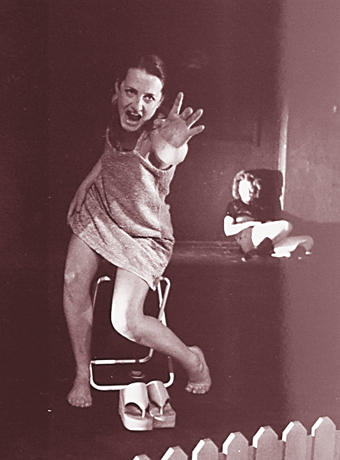
Caroline Dunphy & Lisa O’Neill, Oily Nights in Strathcliffe
In recent years, Brisbane’s been long on shorts. Diverse events have been memorably programmed by Metro Arts, Kooemba Jdarra, Renegade, the brilliant if defunct Crab Room, Cherry Herring, Zoo, LIVID and more. Director Lucinda Shaw marks the territory of CAB/SAV II as “a group of queer-aligned performing artists into difference, making unconstrained theatre that celebrates full humanity and expresses and transcends sexuality.” In the context of what else is around, this sense of unconstrained difference just never materialised —even if the final triptych was worth the wait.
The Lisa O’Neill choreographed Lino Cuts, performed by Caroline Dunphy and Christina Koch, opened the show with something less than a fanfare. Intensely gestural and ritualistic, O’Neill’s choreography usually works its way beneath the skin but this piece seemed blunt and incomplete—an anxious duet for competing ids, Lino Cuts was well performed but too long, or perhaps not long enough, to reinforce and work its themes.
Beneath a projection of Lucinda Shaw’s tidal film Shells, Jem Coones recites his poem “Postcard From a Butcher’s Window” accompanied, and finally silenced by, cellist David Sills (playing the Wesley-Smiths’ White Knight) who in turn is silenced by a kiss. Coones himself, lolling about in a hunky, singleted kind of way inside the image of a projected shell, may have provided just one allusion too many, sentimentalising what might have been a memorable telling of sexual initiation where “the ocean’s hush spoke like a foul-mouthed poet.” A multimedia concoction rather than reconstitution.
Singer/pianist Barb Daveson, accompanied by Sills, performed a charming lament of longing and leaving from her Highways And Hangovers but was poorly programmed in the middle of a set. Daveson was followed by the Babel-esque confusion of Untitled Spoken Word by poetess (sic) Jess Godfrey whose energised performance was full of self-obsessing verve (self/alienation/self/representation/self) and included a memorable moment of retort with her own projected image.
The second half momentarily stalled with Remembering Eve, a terminal film memory by Kris Kneen, but was finally hot-wired by Lucinda Shaw performing “Everywhere I Go Someone’s Reading Poetry.” Sharp, witty, monumentally present, Shaw’s gothic take on the insouciance of art and its paradoxical capacity for banality and pain was a much needed creative call to arms.
The tragi-comic fable of porn hero Joey Stefano (sex, drugs, sex, love, loss, drugs, death) in Psycho The/Rapist #2 Joey Stefano introduced a welcome queer physic. Conceived and performed by Brian Lucas, this is the second in a series of 3 works by an accomplished storyteller whose body is as eloquent as his clever use of prologue, snatch-narrative and sound-bite.
CAB/SAV II concluded with Lisa O’Neill’s powerful Oily Nights In Strathcliffe performed with intensity by O’Neill and Caroline Dunphy (with a soundtrack by Tom Waits, Beck and powermad). Ritual, and the ritual of performance itself, is at the heart of O’Neill’s work. She and Dunphy perform like giants behind miniature picket fences, isolated and out of reach of each other’s screams, playing out rites of desperation and arousal to escape the rites of emotional atrophy. In Oily Nights In Strathcliffe performance and conceptual intelligence come together—O’Neill’s choreography lures, suspends, creeps and catapults.
CAB/SAV II promised queer concentrate but never turned itself over to queerness as an event. The conscious rejection of format, the allusion to and rejection of cabaret, caused its own problems of flagging energy, restless un-anticipation, no sense of celebration or commentary and problems with set ups which a ce n’est pas CABaret attitude might have subverted with fun and SAVvy.
CAB/SAV II, a season of short works for the 1999 Pride Festival, Director Lucinda Shaw, Metro Arts Theatre, June 30 – July 3
RealTime issue #32 Aug-Sept 1999 pg. 37
© Stephen Armstrong; for permission to reproduce apply to realtime@realtimearts.net
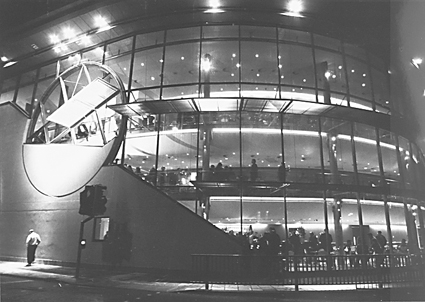
Arc, Stockton-on-Tees
photo Chris Lutherland
Arc, Stockton-on-Tees
Arc in Stockton-on-Tees in northern England is a new arts centre, a key promoter and commissioner of local, national and international contemporary artists, and a state-of-the-art digital media centre. Arc is also an example of the regions of England doing it for themselves in these times of confusion in national cultural policy-making. The Arts Council of England (ACE), the English equivalent of The Australia Council, is currently restructuring its relationship with the Regional Arts Boards (RABs), the equivalent of Australia’s state bodies. A policy of devolution of means and methodologies to the RABs has been ACE’s response to criticism of its increasing irrelevancy to and isolation from regional constituencies. The RABs, all operating divergently according to the varying prerogatives of their region, remain mostly undecided upon their interpretation of devolution.
Northern Arts Board, however, with typical Northern gusto, has wasted no time. With perhaps the most to gain from distancing itself from the London-centric policies of ACE, NAB has finished its consultation with regional stake holders ahead of its fellow RABs and will distribute its funds through regional promoters, rather than directly to organisations in 1999.
Arc is a regional promoter with strong credentials, taking over from the small scale Dovecot Arts Centre, which for 25 years battled to provide for Stockton. Looking like a UFO in its chrome and steel incongruence with this drab, post-industrial city, Arc is one of the first wave of major capital developments funded by the National Lottery. It may have opened several months behind schedule, and over budget, but it has opened on this side of the millennium and that is a triumph for the North, as other beleaguered projects, such as the Royal Opera House in London, sink ever deeper into compromise.
With the ambition which has characterised the Stockton International Festival, also directed by Arc’s Chief Executive, Frank Wilson, Arc has set its world class standards, with an inspirational programme to match its superb facilities. Arc’s curving circumference contains a theatre, a music, comedy and cabaret venue, a cinema, a studio theatre, dance studio and recording studio for community and education use, 3 bars and a health club. Most importantly, Arc boasts a digital editing suite and all the equipment needed for the production and distribution of video and multimedia arts throughout the building. These facilities distinguish Arc as one of the first venues in the UK to place new media arts in a mainstream context, and the Mirror Images programme which opened the venue in January 1999, proudly celebrated the central role of digital arts within the organisation.
The season took its name from Richard Land’s interactive video installation, which was commissioned by Arc to showcase the potential of its facilities. Triggered into action by the images of passing viewers on a monitor screen, the installation evolved over time as ghost images of previous visitors accumulated. Architect Richard Wilson’s intervention into Arc’s facade, Over Easy, was another example of the playful nature of the opening commissions. Wilson’s first permanent installation in the UK revolves in Arc’s glass frontage, inviting visitors to sample the non-stop artistic activity within. Again employing ideas of access and community, Arc commissioned Danish group Hotel Pro Forma to work with local people to create imagery and sounds for the audio visual spectacular Tall Storeys High which illuminated the building over its opening week. Marcel Li Anthunez from Barcelona performed his Epizoo mechanical masterpiece of Stelarc-like physical manipulation; Motherboard from Norway presented Maggie’s Love Bytes, an internet link up with remote international participants; and British multimedia collective Black Box set up an exhibition of interactive sound and video work in the studio. Random Dance Company presented the world premiere of their new dance and digital media production Sulphur16, featuring graphic animation and film edited in Arc’s virgin studios.
Complementing the digital season, Arc’s inaugural programme features exciting new work in more conventional media: Jumping the Waves was commissioned from local playwright Gordon Steel; The Gandini Juggling Project premiere their new piece Remembering Rastelli; amongst several visiting national touring companies, Union Dance and Northern Broadsides Theatre present Dance Tek Warriors and Twelfth Night respectively; there is an extensive music programme and the comedy, club and cinema calendars are full of events likely to bring mainstream audiences into contact with new media work. Arc’s commissions will tour internationally and artists everywhere will benefit from this pioneering approach to new media programming. Symbolism aside, Arc seems set to play an inspirational regional, national and international role.
New centres for digital arts mean new opportunities for media artists to create and present their work in conditions conducive to their appreciation. Funding from the National Lottery has significantly improved audio and video technologies in auditoria and public spaces across the UK, and in several cases, such as Arc, included digital production facilities for the creation of work on-site.
The facilitation of digital arts creation is happening across the board, in venues large and small. In 1998, The Junction, a small arts centre in Cambridge, reopened with an impressive international digital programme. The new Sadlers Wells in London included a multimedia screen and an interactive installation in its foyer and is planning a digital programme for its studio Bayliss Theatre. In March 1999, The Lowry Centre in Salford Quays opened its doors to artists from MIT Media Lab, with a programme of residencies developed in conjunction with the commercial Digital World Centre next door. Future openings, such as The Baltic Flour Mills in Newcastle or the new Tate Gallery in London promise great opportunities for digital artists, with better residencies, showcases and schemes for audience development and marketing of media arts. Existing organisations, such as arts festivals, are catching the new media wave and offering commissions to performance and visual artists to create site specific interventions, often employing the digital media they have also acquired from smaller National Lottery capital applications. There is much to excite the British media artist at the moment, and more to come.
RealTime issue #32 Aug-Sept 1999 pg. 28
© Sophie Hansen; for permission to reproduce apply to realtime@realtimearts.net
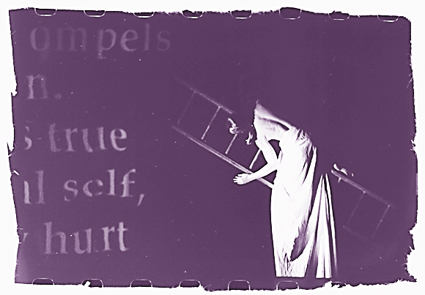
Jennifer Newman Preston, Young Woman Glass Soul
photo Andrzej
Jennifer Newman Preston, Young Woman Glass Soul
Two long-legged bodies lie, hips curving under dappled light, rolling gently together; a face appears, up high to the side, like a phantom, disembodied and peculiar. It takes a while before I realise that this man, Joseph Stanaway, is producing most of the overpowering, long resonant drone and harmonics we hear. It goes on and on, the dancers’ soft movements rippling underneath like snakes at the mercy of an almost impenetrable sound.
Young Woman Glass Soul is a work of contrasts: piercing, immediate imagery alongside movement material that seems stuck resolutely in some other mindset, loaded and unrecognised. Even so, the dancers, Georgia Carter and Jennifer Newman-Preston, move well together with meticulous grace and an unforced unity of stature and timing. But because there is such polish and completeness in the production you get the sense that there is nowhere else for this work to go, as it is. It’s a full piece, seemingly crammed into a finite stage belying the complexity of the subject matter and giving it hardly any space to breathe.
A multitude of Cinderella stories, from ancient Brazilian to comic Disney, have been researched and pored-over for this production. Newman-Preston wants to unearth the richness of pagan symbolism where ashes stand for cleanliness and purification; whereas the cinders of Charles Perrault’s story in the time of Louis XIV are dirty and polluting, and only fit to be touched by those of low birth. The search for the mysterious woman who fits the glass slipper turns out to be the Ash Girl’s search for herself, her own innate wisdom.
The symbol of the serpent in the story is not so well known to us, but provides rich imagery for the dance work. With perfect grace and timing, Newman-Preston herself suddenly appears in a remarkable and insinuatingly beautiful dance, long-legged, in black high heels, bare back arching, her arms dancing lithe and intricate steps as she sidles on all fours up to a comic and cowering Cinders, rubbing her feet ecstatically in ashes.
Another striking image: a woman-serpent half climbs and half falls, a step at a time, down a diagonally pitched and precarious ladder, her looping heavy limbs dropping suddenly like the coils of a snake from a tree, and, like a snake, supporting itself by a fierce, unseen muscular grip wedged in the angled branches.
The most beautiful of all images depicts the fairy godmother, with her small white mask/face and beckoning arm, shrouded in a dark blue cape of sleep, tall and hovering over the sleeping Cinderella. A simple puppet brings an unearthly magical reality to the character.
Outside in the foyer, there are drawings by Vinn Pitcher on the wall—seen as slides in the work itself—and texts of some of the different Cinderella stories giving a stability and depth to the performance. There may be more, possibly 350, all versions of the same story: a woman’s search for strength and inner wisdom. The illustrations seem comic sometimes, trying to incorporate both the spiritual richness of the pagan cultures and our own mass market mentality and material desires. A well-edited collection of these stories and drawings would be perfect for audiences to take home.
Young Woman Glass Soul, choreography Jennifer Newman-Preston, music Alexander Nettelbeck, performers Georgia Carter & Jennifer Newman-Preston, vocal harmonics Joseph Stanaway, word Victoria Doidge, lighting Tim Preston, images Vinn Pitcher, projections Tim Gruchy, videographer Jo Griffin, Bangarra Dance Theatre, Sydney, July 1 – 10
RealTime issue #32 Aug-Sept 1999 pg. 37
© Eleanor Brickhill; for permission to reproduce apply to realtime@realtimearts.net
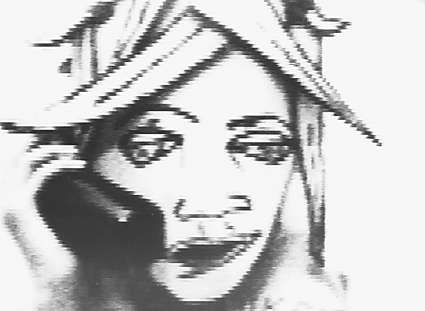
Sadie Benning, Flat is Beautiful 1998
In her introduction to Captured, curator Clare Stewart describes Experimental Cinema as “a contested and elastic term” tracing the parameters of her definition from Bruce Conner to Jim Jarmusch, including the Cantrills, Warhol and Len Lye, while stretching the term to suggest work produced beyond cinema, video and multimedia.
The historical relationship between experimental film and video and digital media practice, the real or potential intersection between them, has often been ignored as experimental work has become redefined in the spectacle of the digital media showcase. Captured goes some way to redress this in favour of work which does not trumpet its media novelty over other concerns.
Stewart’s elasticity is actually less than genre-busting and the works don’t exactly stretch definitions. Why not, for example, programme websites, or even a camera obscura for that matter? The programmes are also largely US dominated with a European coda. However such questions are somewhat churlish as Captured follows a distinctive and necessarily partial course, gathering some of the dominant strands of experimental film and video of the last 10 years or so with deftly imaginative programming.
It is an inspired decision to programme a mini Sadie Benning retrospective (Pixilated: The Oblique Vision of Sadie Benning). Benning’s early work with the Fisher-Price Pixelvision toy camera resembles the intimate, small scale personal documentary/drama that one encounters these days on websites using QuickCams. This teenage lesbian grrrl shot to recognition in the late 80s, the usual adolescent rites of passage skewed through a queer filter in suburban Milwaukee. From the bricolage bedroom video A New Year through to the ‘road movie’ It Wasn’t Love and the women’s health education, animated/live action hybrid of The Judy Spots, Pixilated tracks the development of a style as sophisticated as her older sisters’ (such as Su Freidrich, Greta Snider, etc). The new Flat is Beautiful consolidates this: a wry, affecting film about growing up queer in the 80s combines sharp takes on cod-pop psychology with some quite audacious character masks, as Benning transplants Chantal Akerman’s ‘flat’ approach into the ordinary flux of smalltown middle America.
The Ways of Being programme concentrates on the convergence of performance and video and the appropriation of popular forms. Joe Gibbons’ Multiple Barbie extends the pop-psychological theme in a Pixelvision therapy session framing an exorcism of a Barbie doll’s multiple personalities; a neat parody of tabloid obsession. The Halflifers’ Actions in Actions turns material-action performance into slapstick, or vice versa, the properties of certain foodstuffs taking on a new, metaphysical significance. One with Everything by Daniel Reeves is a technically polished ‘mockumentary’; a fast, iconoclastic ‘deconstruction’ of popular Buddhism. Zen-inspired punning culminates in the ‘punchline’ title. Anne McGuire’s I am Crazy and You’re Not Wrong, spoofing a desperate cabaret singer, drips with deadpan irony and pathos. Singing “a song for all of you who don’t fit in” (introducing Rudolph the Red Nosed Reindeer), she could be Cindy Sherman doing stand-up. The threads of barely suppressed tension and humour that entwine Ways of Being are intensified by the hallucinatory psychological landscape of Nocturne, the latest in Peggy Ahwesh’s series on sexuality, violence, nature and mortality. The promiscuous Pixelvision is again used as a formal/narrative device, its high-contrast providing occasional noir-esque intensity.
Recycled: Old, Used and Abused, consisting of work from Vienna, surely the European capital of Experimental Cinema, begins with Alone. Life Wastes Andy Harvey by Martin Arnold. Arnold, a virtuoso of the optical printer, takes fractions of old Hollywood movies through extraordinarily controlled repetitive forward and reverse reprinting; microscopic moments become tics, stuttering and breathy gasps. Alone…. follows his earlier work in the exploration of the perceptual possibilities of this technique. The extended song, utterances and exhalations of the triangle of Fay Holden, Judy Garland and Mickey Rooney become oedipal erotic tension in a distillation of structuralist aesthetics; a sinister reconstructive revisionism of cinematic language. Film Ist by Gustav Deutsch reworks a staggering catalogue of found footage into a lexicon of cinematic technological form and function; choreographed concrete construction transcends its research-based premise as an elegant post-humanist poetic essay. The final film of the programme, Lisl Ponger’s déjà vu, frames old super 8 holiday movies from ‘exotic’ locations with voice-over tourist stories. Accidental and naive complicity imbues the problematised relationship of the post-colonial ‘gaze’ with subtle nuanced reflexivity.
It is a credit to the Melbourne International Film Festival and the Australian Film Institute that they are respectively premiering and touring Captured; an altogether considered, coherent and accessible package, serving both as a progress report and captivating introduction to a rich seam of experimental cinema.
Captured, curator Clare Stewart, Melbourne International Film Festival, Treasury Theatre, Melbourne, July 28 & 30, Aug 3 & 7; Perth: Film & Television Institute, Aug 13 – 14; Adelaide: Media Resource Centre, Aug 21 – 22: The Art of the Improbable (forum + local experimental films), speakers: Edwin Daughtry, Margaret Haselgrove, Janet Merewether, Clare Stewart; Sydney: Chauvel Cinemas, Sept 2 & 3
RealTime issue #32 Aug-Sept 1999 pg. 30
© Steven Ball; for permission to reproduce apply to realtime@realtimearts.net
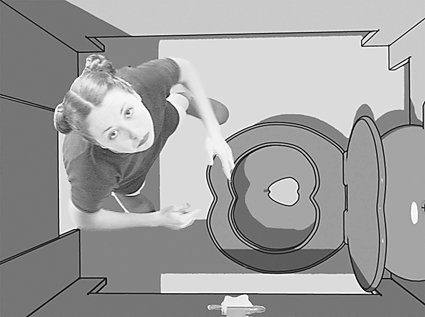
Transit Lounge, Keith Armstrong/Ross Anderson
Foyer: a place of impermanence, change, transition. Right now I need a coffee to settle my stomach. Black cushions, black cave; crawl into Saturday morning. Recovery via Art. Glossy fake turf; two screens beaming out licorice colours. Someone sticks their head around a temporary wall: “Excuse me, can you please tell me where the workshop…?” De-dede-de-de makes a happy kitsch-pop tune. Multimedia artist Keith Armstrong and I meet and greet each other.
We are in a space within the space of the Metro Arts foyer, Edward Street, CBD of Brisbane, an artifical space constituted by an installation of sound, vision, dance, 3D animation and captioning. The 2 of us begin to chat while lolling on cushions in the surrounds of this thing called the Transit Lounge: a world of many worlds and crazy characters. Keith: originator, digital video artist and artistic director.
Ling Change: a strong young woman who commands attention and investigates other worlds and ways of doing things.
What was the impetus for the project? I was on a Metro residency in 1998-99 and at the same time participating in the Jabiluka protests. In both instances I came face to face with the question of change, ie what are the conditions in which individuals or organisations can flourish and how are these conditions realized? This question’s also a bit of a follow-on from my previous project, Public Relations [from the IMA’s Art on Line series]; I’m interested in how systems lock together and influence their constituent parts and vice versa.
So, in the residency I wanted to look at how the tenants of Metro Arts might interact with the greater environment within which they operate so as to achieve a dynamic between diversity and equilibrium. I went around and spoke to tenants asking them open-ended stuff like, “How do your private ethics impact on your organisational management?” and “Do you play games?”
The Humatix: unemployed cleaners who live in decommissioned toilet blocks and dance to any available audience in the hope of picking up a tip
How did you focus this? Originally I was going to use the whole building as an installation but narrowed it down to the foyer, which allowed external traffic as well. And I conceived of the installation as a nonlinear world which would be affected by audience activity. So I’ve located it in an area where the environment is always changing and yet people have some ownership, however abstract, of the space.
The Cock Blockies: mummylike characters permanently coiled in lotus position in the tunnels of the honeycomb plateau
What was the authoring process? I wrote a script, with Lisa O’Neill (choreographer-dancer) in mind, and together we began to build storyboards. The script had the fundamental idea of a series of different worlds, with a description of each one. There were some adventures but it was a totally absurd piece. Some people asked me if I’d been on acid when I wrote it!
Lisa was very instrumental in the characterisation of the inhabitants of the worlds. She took it in directions I didn’t anticipate, such as giving a cartoonlike quality to the characters. We shot her in a TV studio, putting the 3D camera in the same spot it’d be in in the animated world.
I sketched the environments and then Sean Young, Andrew Goode and Ross Anderson [3D modelling animators] developed the Y-frames in 3D. It was at a later stage that we decided to render them in a cartoonish style. This wasn’t only because of Lisa’s work but also because I wanted something of that quality that The Simpsons and South Park have and, again, the ‘reality’ factor of the original renderings somehow flattened out the narrative.
Young Macduffles: suave salesmen who are forever seeking new opportunities to sell their product, the honey drink ‘Core’
Why did you develop a narrative? I wanted to play around on the boundaries of artistic and commercial design and to create an installation that had a broad appeal. Given the conceptual underpinnings, I wanted people to engage with the ‘artwork’, not just look at it. Of course, the narrative isn’t linear; this would’ve been contrary to my interest in change and how it is measured. I’d like, ultimately, to make a play station.
Old Macduffles: slaves who package ‘Core’ in the niche markets
What was the role of sound? Guy Webster [composer] came in to the project at a later point—mostly due to money or the lack of it! (We all contributed hours of unpaid labour and got a lot of in-kind support from the likes of QUT and Apple.) He basically had a responsive role although he contributed lots of great ideas. We decided that we’d go for a ‘music’ rather than ‘sound’ style, a soundtrack, this year’s model so to speak. He worked with miniatures of the animations and with Lisa.
Rinston, Bruce Canon & Dogs: preoccupied, unaware and insular neighbours of Ling Change
How did you structure the space? Originally I’d wanted to use the whole foyer. However, once you bring in the screens, you have a problem with light so Callum Lui [installation designer] created this cavelike structure we’re sitting in. These cushions invite people to relax and not have an us/artwork dichotomy. I’d intended a walkthrough space but this is contingent on the door at the far end being left open by Metro! The space is more enclosed than I’d originally envisaged; hence the turf as one way of bringing different environments together.
The large screen hanging above us shows the narrative as it unfolds, detours and so on. The smaller screen set up like a TV gives background information about the worlds and the characters, and the captioned thoughts of the main character Ling Change. It also includes a digital garden, the state of which is affected by the audience, and which in turn affects the narrative journey. So movement, temperature, sound and light make the flowers bloom or wither away, and these changes influence the adventures of Ling Change. The interactive code was created by Gavin Sade [interactive designer] on a Director [multimedia authoring] system, and the engine of it all is in the basement below the foyer.
The Fiscalities: narrow minded empirebuilders who restrict others but themselves get stuck on the honeycomb plateau.
Our conversation dwindles to its end. Keith and I sit there, watch the flowers grow, see the Humatix do their dancing-girls routine once again in sexy short uniforms and brassy wigs, give each a goodbye after a short black, and go our separate ways. In transit: on the go, between destinations, journeying into the…
Ling Change Thinks: line dancing is so passe
Transit Lounge, Keith Armstrong, Lisa O’Neill, Guy Webster, Callum Lui, Sean Young, Ross Anderson, Andrew Goode, Gavin Sade, Nat Abood, Raniah Haydar, Metro Arts (foyer), Brisbane, May 26 – June 19
RealTime issue #32 Aug-Sept 1999 pg. 29
© Maryanne Lynch; for permission to reproduce apply to realtime@realtimearts.net
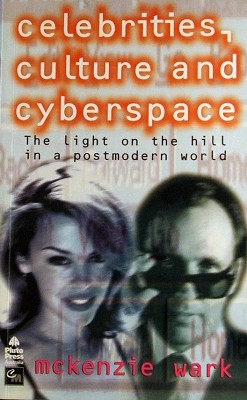 McKenzie Wark’s ongoing contribution to a contemporary understanding of Australia’s social and cultural condition cannot be underestimated. His third book, as its title indicates, paints a huge canvas and like most of his astute commentary in newspapers, academic journals and magazines, seeks to provoke reaction and stimulate further debate.
McKenzie Wark’s ongoing contribution to a contemporary understanding of Australia’s social and cultural condition cannot be underestimated. His third book, as its title indicates, paints a huge canvas and like most of his astute commentary in newspapers, academic journals and magazines, seeks to provoke reaction and stimulate further debate.
An amazing array of what at first appear to be unrelated topics make up this impressively researched opus. Both individually and collectively, the topics formulate important questions. There is suggestive analysis of the meanings generated by the likes of Kylie Minogue, Nick Cave, Peter Garrett, the Kellys (Ned and the 2 Pauls) and Natalie Imbruglia. There’s also an assessment of the “post broadcasting” era we are fast approaching, which forcefully challenges the dominance of suburban myths and values.
At the core of these matters lies Wark’s chief concern: that the ALP today has lost touch with what its constituents actually desire from everyday life. The answer lies, he argues, in an awareness and understanding of popular media-generated images through which people formulate ideas and aspirations.
Here indeed is a thinker who uses very broad brushstrokes in his view of the big picture. He examines the way new media technologies are embraced by a growing proportion of Australians as we approach the new millennium. Wark argues that being both more aware of and comfortable with cyberspace allows for a new way of seeing as well as providing newer forms of information. Yet to argue that this constitutes an end to the broadcasting age and presumably to the end of mass media is highly contentious.
There is little evidence presented here to suggest that the birth of new media automatically assumes the death or even the steady demise of old media. The internet, pay-TV and the phenomena of niche and narrowcasting may well mean that there are more choices than ever before. Yet this does not preclude the possibility that most of us will still get the majority of our news and information from traditional media sources. As he cites more and more examples of celebrity culture on mainstream TV networks, newspaper and magazine chains, Wark perhaps inadvertently proves that we are not in a post-broadcasting age.
His argument goes deeper when he proposes that those who inhabit and embrace “fortress suburbia” are largely resistant to social change in general and to new flows of information from cyberspace in particular. These citizens, he argues, are essentially inward looking, fearful of the massive changes which globalisation has brought and generally intolerant of difference. Meanwhile, those who dwell in inner city developments represent a new urban and outward looking generation who are much more adaptable to all forms of the massive changes occurring around them.
The problem with this analysis is twofold. There is no evidence presented which supports such generalisations about community attitudes, let alone usage of new media forms. A recent Rural Industries Corporation report notes that at least 20% of Australia’s regional farming community is currently online (and for longer periods of time) while the national average is 18%.
The Australian Bureau of Statistics has indicated that generation Xers are leading the way in taking up rates and overall usage of the net. Wark seems to be suggesting that the propensity to embrace new media technologies results in new and dynamic flows of information which, in turn, allows forward, adaptive and more creative thought processes. Yet in very recent Newspoll findings these same 18-24 year olds are increasingly more fervent in their support of Prime Minister Howard. If he represents the most exciting and forward thinking federal politician to the most switched on media savvy generation ever known, Wark’s overall argument loses some momentum.
There is no strong evidence to suggest that spending more time with new forms of information and entertainment correlates in any consistent way with specific attitudes or behaviour patterns to do with social, political and/or economic issues. Indeed an overview of many of the most popular chat-sites around the web reveals an amazing lack of tolerance, goodwill and openness to new agendas.
I remain unconvinced that place of abode, propensity to go online or indeed age—another of Wark’s apparent obsessions (shared with Mark Davis)—have much on their own to do with the way we feel or behave. There are far too many other variables which come into play here.
Finally it is the political implications of Wark’s acceptance of many of young ALP maverick Mark Latham’s so called “third way” approaches which I find most troublesome. Much of the current economic orthodoxy shared by both major political parties is supported by Latham who goes further to urge continuous anticipation and positive adaptation to the ongoing changes brought upon us by the “natural” forces of globalisation.
These changes are somehow seen as inevitable, as consequences of the forces of nature. Those who oppose these seemingly gravitational movements are quite clearly naïve in clinging to tired, out-of-date social principles once endorsed by the Labor Party.
This brings us back to the question of how we relate to the celebrities we encounter in all vectors. Wark argues that the Labor Party must come to understand the needs and wants of its constituents by coming to terms with the meanings and messages we receive from our celebrities. But how all of this is supposed to connect to future ALP policy formation remains rather problematic.
Throughout his book Wark remains optimistic about the sweeping changes we are all experiencing. “I write for dancers not mourners”, he stated in a recent Age interview. Clearly there are many of us who remain more sceptical about the directions we are heading in. Yet while we can disagree with and be puzzled by some of Wark’s arguments, he has raised and made readily accessible many pertinent questions about crucial issues which affect us all.
McKenzie Wark, Celebrities, Culture and Cyberspace; The Light on the Hill in a Postmodern world, Pluto Press 1999
RealTime issue #32 Aug-Sept 1999 pg. 27
© John Schwartz; for permission to reproduce apply to realtime@realtimearts.net
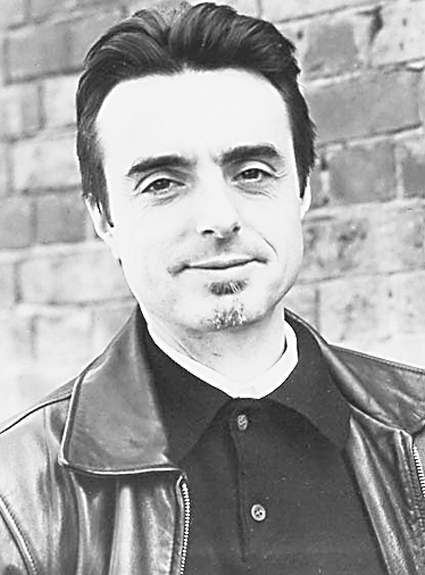
Mark Dery
Mark Dery has built a remarkable reputation as one of America’s leading cultural critics. With a vocabulary that would terrify Barry Jones, Dery happily dives into realms that most critics avoid like the plague. He roams the cultural landscape like a geigercounter searching for radioactive material. As J.G. Ballard has put it, “the ever growing pathologies of millennial America show up clearly on the X-ray screen of his penetrating analysis.”
His first book, Escape Velocity: Cyberculture at the End of the Century remains a watershed work and one of the only ‘cyber’ texts to retain its relevance as the seconds tick by to the end of the millennium. His work has appeared in The New York Times, Wired, 21*C, World Art, Suck, The Village Voice and Rolling Stone and his latest offering The Pyrotechnic Insanitarium, American Culture on the Brink (Grove Press) is a tome of collected and reworked magazine essays. Its bizarre meanderings have caused a storm of debate. He has been both savaged and lauded with many mainstream critics obviously left wondering where the hell he is coming from or going to. Meanwhile Howard Rheingold, Andrew Ross, J G Ballard and Bruce Sterling have lined up alongside Dery, with Sterling writing in Bookforum that, “Given its utterly bizarre terrain, this is a very lucid book—I can only imagine the effect of these essays on, say, some bright but sheltered 17-year-old male Southern Baptist. It would likely cause the kid’s skull to spontaneously rupture. The book is also extremely funny. Mark Dery has a hammerlock on the Zeitgeist. He may be the best cultural critic alive.”
There is no doubt however that the range is bizarre; from cloning to clowns, from degeneration to digerati. There is a distinct aesthetic running through these subjects and it is decidedly morbid. According to Dery, he is “using millennial memes like the psycho killer clown, disposable archetypes like Edvard Munch’s The Scream, and media mythologies such as the horror stories about flesh-eating bacteria and ‘hot’ viruses as prisms to refract the social, economic, and philosophical trends that are shafting through American culture at the fin-de-millennium.”
Talking to Dery is spell-binding. His vocabulary is no affectation, just the expression of an individual who truly loves words and ideas. However his ideas are far from average.
“I chose the exhibits in my postmodern Odditorium (P.T. Barnum’s name for his famous museum of monsters, marvels, and patent fabrications) because they seemed like the best examples of the media freakery, postmodern fakery, tabloid grotesquerie, and increasingly gothic social conditions all around me, here in the Evil Empire,” says Dery. “For example, Damien Hirst’s cut-up meat animals, floating in formaldehyde, seem to embody our ambivalent attitude, a sort of contemptuous nostalgia, toward the melancholy ‘meat’, as the body is derisively known in our ever more virtual world. Of course, Hirst is British, so his pickled cows can’t help but remind us, as well, of mad-cow disease, the Cronenbergian horror that has become cultural shorthand for all our dearest fears of airborne pathogens and invisible contaminants in our age of product tampering and toxic Coke, multiple-chemical sensitivity and anti-bacterial scrubs.” More and more, says Dery, public space, from our drinking water to pay telephones, “teems with microbial menaces in the paranoid imagination. At the same time, the body itself is increasingly seen as a septic nightmare, its unseen contaminants exorcised through the New Age ritual of colonic cleaning. On my dissecting table, Hirst’s pickled animals become a way of talking about these things.
“As for the ‘morbid’ aesthetic you mention, it’s a conjunction of individual temperament and Zeitgeist, I suppose. We live in gothic times, as Mark Edmundson points out in his marvellous book, Nightmare on Main Street: Angels, Sadomasochism, and the Culture of Gothic. He sees American culture as fraught with Gothic assumptions, Gothic characters and plots, from The X-Files to the O.J. Simpson trial, recovered memories of satanic ritual abuse to right-wing conspiracy theories. I’d add that we’re also witnessing the resurrection of the Gothic’s conjoined twin, the grotesque. The grotesque is the Gothic with a sense of humour. We see the grotesque in the carnival-midway mix of horror and hilarity that is a personality trait of the late 20th century—the endless replaying of R Budd Dwyer’s on-camera gunshot suicide for laughs on the web, for example.”
In an era when New York City has gone from Gotham to glisten, when President Clinton gets away with personal mayhem and announces the healthiest economy for many a year, Dery’s position, if anything, has become more extreme. It is not difficult to perceive Dery’s cultural reading in part as a reaction to political correctness.
“Don’t you mean a reaction to political in-correctness?” says Dery in response. “Namely, New York mayor Rudy Giuliani’s ongoing transformation of the ‘mongrel metropolis’ into a gated community for the mega-rich, a police state ruled by Michael Eisner, while quietly shipping the homeless off to suburban holding pens, turning a blind eye on police brutality, and cutting tax breaks for the real-estate barons pricing the lower classes out of Manhattan?
“As for the ‘extremism’ of my critique, what’s the alternative? A playful slap on the wrist for a nation rotten with power and bloated with wealth that prizes B-2 bombers over prenatal care, corporate welfare over public education? A homily from William Bennett’s Book of Virtues for a country that subverts democratically elected governments and coddles dictators, rewarding the nightstick justice meted out by pariah governments like the Suharto regime with arms shipments, the better to drive striking sweatshop workers back to their posts? I may be an egg-eating rat gnawing on the tail of a Tyrannosaurus, but as a politically engaged intellectual, speaking truth to power is part of my job description.”
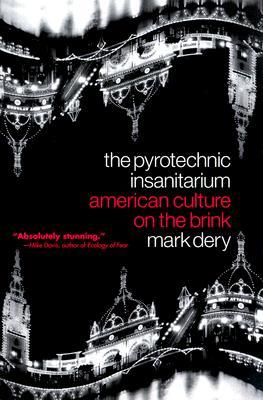 Dery’s approach to cultural criticism is remarkably inclusive. He scans popular culture as comfortably as high brow theory, from Disneyland to Deleuze. In this he shares a number of qualities with such writers as Mike Davis in City of Quartz, Greil Marcus in Lipstick Traces, Erik Davis in Techngnosis and McKenzie Wark in Virtual Geography.
Dery’s approach to cultural criticism is remarkably inclusive. He scans popular culture as comfortably as high brow theory, from Disneyland to Deleuze. In this he shares a number of qualities with such writers as Mike Davis in City of Quartz, Greil Marcus in Lipstick Traces, Erik Davis in Techngnosis and McKenzie Wark in Virtual Geography.
“I think we’re beginning to see the faint footprints, in mainstream and alternative journalism, of the first few graduating classes to cut their intellectual teeth on postmodern philosophers like Baudrillard, Foucault and Deleuze,” says Dery. “Erik Davis is an exemplar of these smart, young, incurably informed academy hackers. McKenzie Wark, who began as a rock critic and is now a card-carrying member of the professoriate, represents the trajectory from the opposite direction, namely academics who stage-dive into the mosh pit of popular culture and media exposure.”
There’s a precedent for this trend, says Dery, in 60s pop intellectuals such as McLuhan, Buckminster Fuller, Susan Sontag, Norman O. Brown, RD Laing, Leslie Fiedler and Herbert Marcuse, “all of whose stock-in-trade was typically ideas, not theory, as Andrew Ross points out in No Respect: Intellectuals & Popular Culture. (Interesting to recall a time, not so long ago, when the “critical theory” trust didn’t have a Microsoft tm monopoly on the operating system for intellectual discourse!) I think this sort of mental miscegenation is all to the good. Inbreeding, whether literal or intellectual, is a recipe for monstrosities.”
Dery comfortably hops around the cultural terrain, jumping from comparatively ‘mainstream’ subjects as the Unabomber and Heaven’s Gate to the far less publicised Mutter Museum and the grotesque comic books of Renee French.
“I’ve always been interested in unnatural history and unpopular culture,” says Dery. “It’s an obsession that springs, I suppose, from the implicitly political assumption that what’s removed from the official version, the eloquent holes left by the censor’s scissors, is more informative than what’s left in. I’m interested in the repressed truths, whether visceral or political, buried in the Freudian boiler room of mass culture: the unconsidered, like the ‘Doll Hour’ on the Home Shopping Network; the unspeakable, like the wax models of venereal horrors in medical museums; the unacceptable, like the statistics about runaway personal bankruptcies and credit-card debt downplayed by the media, lest these sour notes clash with the received truth that we’re all rewarded by the Long Boom, not just the top 20% of American families.”
Dery begins Insanitarium with the brilliant metaphor of crumbling Coney Island. It is incredibly apt for millennial culture. However one could argue in the opposite direction, that rather than the lights going out and a healthy rot setting in we are seeing the creation of soulless citadels; the cleanliness of New York, the puritanical vigilantism of Los Angeles, the plastic re-make of Singapore. It is impossible to escape the gigantic hamburger M almost anywhere on the planet and if anything the lights seem to be going on, making the ghosts and freaks scuttle away so the tourists are safe.
“Well, as your comments imply, the waking nightmare of America, late in the 20th century, with its media feeding frenzies and its copycat killings, its urban pathologies and its exurban desolation—what James Howard Kunstler calls our strip-mall, convenience-store ‘geography of nowhere’—can be every bit as scary as the night terrors of the Gothic imagination. Baudrillard hints at this in America, in his ontological vertigo in an air-conditioned Hell that exults in ‘the liquidation of all culture’ and rejoices in ‘the consecration of indifference’, an Audio-Animatronic dreamland so ghastly that even ‘dreams of death and murder, of suicide motels, of orgies and cannibalism’ offer blessed relief. Baudrillard’s fits of the vapours are a little hard to take, sometimes, but he’s hilariously on target when he suggests that nothing is spookier than the hysterical fear of nature and the body, the mysophobic sterilisation of the unconscious symbolised by the Disneyfication of public space and the creeping corporate monoculture you mention.
“I chose Coney Island at the turn of the last century as my master metaphor because it’s a janiform symbol, embodying the dualisms that are a hallmark of fin-de-siecle moments such as ours. As I note in the book’s opening essay, turn-of-the-century Coney was 20th century America in miniature, a carnival of chaos whose trademark blend of infernal fun and mass madness, technology and pathology was quintessentially American. It was transgressive, a mad, Dionysian whirl of emotional abandon and exposed flesh, speed and sensory overload that mocked the hidebound proprieties of the vanishing Victorian era and signalled the rise of a new mass culture no longer deferential to genteel tastes and values. Steeplechase, Dreamland, and Luna Park were, in today’s parlance, ‘temporary autonomous zones’ where genders, classes, and ethnicities commingled more freely than they did outside its gates.
“At the same time, Coney was also a machine for mass-producing masses—the workers and consumers of the coming age of mass media and mass consumption. Like today’s Disneyworld, the Burning Man festival, and body piercing, it was a safety valve for proletarian energies that might have been channelled into less playful, more political outlets. It instructed the immigrant working class in the machine-age pleasures of conspicuous consumption, guilt-free waste, gadget worship, and the push-button gratification of infantile desires. This is the ‘Coney Island of the Mind’ that inspired Henry Miller’s literate, liberal shudder of revulsion, the peeling pasteboard temple of cheap thrills and vulgarian pleasures. So there was a Foucauldian mechanics of transgression and repression at work in Coney that is still in effect in the millennial America it helped beget, a pyrotechnic insanitarium torn between escapist simulation and social reality, democratic promise and corporate oligarchy, the restless rabble and the power elite.”
Mark Dery, The Pyrotechnic Insanitarium, American Culture on the Brink, Grove Press, USA, 1999
RealTime issue #32 Aug-Sept 1999 pg. 26
© Ashley Crawford; for permission to reproduce apply to realtime@realtimearts.net
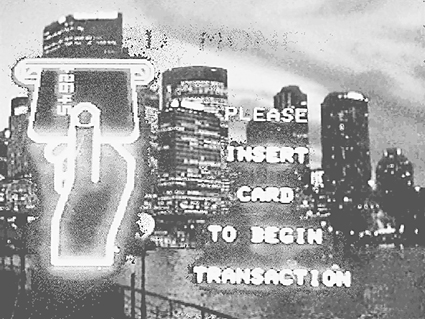
Wade Marynowsky’s Diaspora 2000
D.art 99 is a gallery exhibition of CD-ROMs and a cinema screening of linear video “made by artists who use digital processes”, both programmed by dLux media arts. The screening was presented as part of the 46th Sydney Film Festival; the CD-ROMs were exhibited at Artspace from June 10 to July 3. D.art will soon tour nationally. The opening also included a performance by Wade Marynowsky and launch of the remarkable CD-ROM Basilisk & a universe of dirt by Wayne Stamp, Lloyd Sharp and Panos Couros.
We haven’t yet reached the point on the curve of increasing bandwidth that will make many of the more interesting forms of digital art easier to distribute, so opportunities to view international works locally are still rare. At D.art 99, CD-ROMs and videos from the US, England, Spain, Brazil, the Netherlands, Finland and Canada were shown alongside work from Australia. It is heartening to recognise that media artists all over the world are striving (not always successfully) to make sensible use of digital tools beyond their preset effects. dLux media arts should be commended for continuing to program international pieces—a practice first tested at D.art 98. It seems obvious that exhibiting the best international pieces benefits local production and critical practice, in much the same way that the major film festivals have offered film practitioners an international context for their efforts. Once the relevant funding organisation emerges from the Hall of Mirrors it may be encouraged to support the exhibition of international digital media art locally.
One of the highlights of the video program was Peter Callas’ work-in-progress Lost in Translation—part 1: Plus Ultra, his first piece since moving his production process out of the video studio and onto the desktop. You have to admire anyone who will learn Unix for their art, and the result of his extensive re-skilling in SoftImage is shown in this piece which seems to offer an expanded dimension to his previous efforts in the essentially 2D world of the Fairlight video synthesiser. While still using 2D sources—images and drawings from the heroic period of Portuguese exploration and consequent non-heroic period of South American colonisation—Callas has managed to manipulate them (figures especially) in a manner which suggests a life in 3 dimensions. In one sequence a Prince-Henry-the-Navigator type of figure is seen hunched over a map and continues to draw and redraw the edges of the world. In another a bed-ridden figure cut from what looks like a Goya is made to buckle in spasms from some deep sickness of the soul. The new tools have allowed for a greater depth of texture and mood. Callas’ new work is more poetic. Lost in Translation seems to escape some of the comic harshness provided by the saturated colours of his early work, while pleasingly retaining the psychotic repetitive actions of the figures and his political concerns, and remains unmistakably a video by Peter Callas.
Michaela French’s Flux is also a beauty, or is beauty. A richly layered and textured series of visually poetic fragments carefully sewn together in the edit suite. It makes you think of all sorts of things—love, loss, longing, ferris wheels, Christ how did they do that and what is that a picture of? We are finally starting to see some spirited use of Adobe After Effects which proves that all those bank commercials with their gliding logos haven’t ruined it for everyone.
Ian Haig’s 2 minute blurt Trick or Treat “ghouls, zombies, bloodsuckers, freaks and demons are brought back from the dead”, looked like 16 different personalities vying for control of the body of Edvard Munch as it squeezed through a sphincter in the space-time continuum. It was comically unnerving in a Tobe Hooper sort of way. But it ended just as its visceral effects (significantly augmented by Philip Samartzis’ soundtrack) were starting to be felt. Hopefully, Haig will turn it into an endurance piece for those people who can’t get enough of his sort of madness.
Tina Gonsalves’ Swelling was another substantial piece in a generally high quality video program that suffered only a couple of lapses.
New media curators always have to grapple with the problem of exhibiting interactive digital media art (CD-ROMs and websites) and linear digital media art (video) in the same program. Recent attempts by film festivals to incorporate both have usually resulted in a batch of PCs with CD-ROM drives sitting in the foyer of the cinema. dLux have gone the more sensible route and put a batch of PCs in the foyer of an art gallery, allowing for a longer exhibition window. The set-up at Artspace was pretty perfunctory—4 Macs on 2 trestle tables with headphones to stop the sound spill and a bunch of chairs scattered around. It looked like one of those laundromats in Chinatown which also offers net access. But the event had people queuing up every day to see the exhibition, and with a lot of people around the unfussy approach worked well.
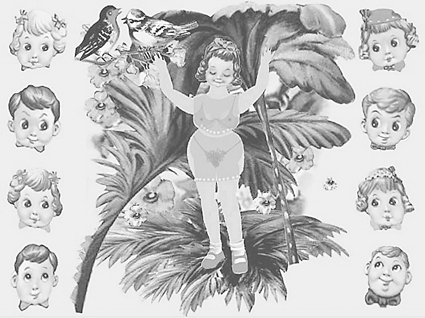
Cristina Casanova’s Vamos a Contar Mentiras (Let’s Tell Lies)
Someone always seemed to be interacting with Spaniard Cristina Casanova’s Vamos a Contar Mentiras (Let’s Tell Lies)—a popular piece. Through a menu made of happy chocolate-box cherubs, the user was able to gain access to a series of animations which told oblique stories, ostensibly about a group of school friends. It was fun and flirty and always entertaining, but had one of those confusing interfaces which, if you didn’t have a good memory, had you by mistake returning to areas already explored.
A notable tendency within D.art 99 was an emphasis on sound. Visual artists who have taken up video and digital media at art school have not always embraced sound production, especially when taught by other visual artists. There is an old rule of thumb handed down from video artist to video artist that says sound is 10% of the effect and 90% of the trouble. Chris Henschke’s Orchestra of Rust and Michael Buckley’s The Good Cook showed that with CD-ROM production it might still be 90% of the trouble, but you get full value for your effort. Likewise, Panos Couros’ soundtrack for Basilisk & a universe of dirt works effectively with Wayne Stamp and Lloyd Sharp’s bacteriological, alchemical, ahistorical, and proctological imagery.
Chris Hales is an English artist who has long worked with his own brand of interactive movie—poetic (and sometimes comic) linear videos into which he has set hotspots for the audience to select. These provide jumping off points for other scenes or other narratives. The Tallinn People’s Orchestra is a slightly different work in that it uses sound as a basis for its development. A simple locked-off shot of a square in the Estonian capital shows at various points different figures walking into the shot in the foreground, middle ground and background. Planes, pigeons, people all have a separate sound figure and can be turned off or ordered differently to evolve the soundscape. It is not as immediately fulfilling as his previous The Twelve Loveliest Things I Know and others, but still an interesting example of the development of interactivity with linear video streams. Chris Hales remains one of the few artists worldwide who is interested in this area which seems rich with possibility and may reach its height with the spread of DVD-ROM.
Wade Marynowsky’s Diaspora 2000 was both a performance and CD-ROM. The performance was held in the vestibule at Artspace after the opening speeches and during everyone’s second beer. The speakers were cranked up and the video projector above Marynowsky’s head was pumping out a stream of media against the universe. The music was a reasonable sort of bland techno filth thing. It was kind of okay in performance and the energy was up but at times it looked like another virtual anorak going through the motions.
The CD-ROM version of Diaspora 2000 (made in Director) even though the same, is another thing entirely. The user is given a very simple keyboard layout to learn and then get started. By selecting different keys, you can call up different sound samples coupled with images. Some are drum loops, some melodic sequences and some short samples. Not only can you overlay sounds over each other, but the images coupled to the sounds flash alternately, creating a sort of epilepsy-inducing oscillation between images. Eisenstein would have liked the way the images evoke different meanings when placed in proximity with each other, but the broad themes of the piece make you think of the 4 horsemen of Sydney’s Apocalypse—greed, envy, lust and the Olympics. You can build up quite complex layers of sound and image, and experiment with turning layers on and off.
After about half an hour of playing with this thing, you get that sweaty overstimulated feeling you get from video games or loud music and which is strangely satisfying to the adolescent in you. You begin to realise that this program was what Wade was interacting with to make the audio and video streams for his performance on opening night which you previously thought was a bit ho hum. What makes it so different? Why was the linear version a bit familiar, but the act of interacting with the same material so exciting and so fun? Maybe we are starting to see what interactive media is going to be able to give audiences that linear media can’t. Interactive media’s offer not of control but of play as an antidote to the didacticism of linear media will win every time.
With this event, dLux have gone out on a limb by concentrating primarily on the exhibition of digital works, a move which remains unpopular with many camera-using filmmakers. D.art 99, however, must be described as a successful event. It had a focus which its predecessor, Matinaze (1991–97), always lacked, and a breadth, through the programming of CD-ROMs, which D.art 98 couldn’t achieve. With the possible inclusion of a sound component next year, D.art seems to be morphing into a separate event altogether. And now that other film festivals are sweeping up all those pesky short dramas, dLux can concentrate on exhibiting digital media art in all its forms. And this is a prospect which is not at all unpleasant.
D.art 99 screenings, produced and presented by dLux media arts at the 46th Sydney Film Festival, Palace Academy Twin, June 18; CD-ROM exhibition, Artspace, June 10 – July 3; D.art 99 will tour nationally and internationally
RealTime issue #32 Aug-Sept 1999 pg. 19
© Michael Hill; for permission to reproduce apply to realtime@realtimearts.net
alotronic (http://users.dbworld.net.au/~allen/aloxoom/alocore4.htm – expired) is an example of what can be achieved by a personal website with a bit of creative flair. Part promotion, part experiment, Allen O’Leary’s interest in theatre and information technologies informs his hypermedia work The Casino Project. A groovy JPEG of a man running helter skelter entices you to join the pace of the site which is flashy and fast. Although a work in progress (60% complete), it is conceptually sophisticated, using frames to flesh out the inner workings of a man “jagged around the edges”, dealing with a relationship breakdown in the Melbourne Casino surrounds, “a beast with ten thousand eyes.” He drives to “her river”, contemplating ownership and borders, the need to claim spots as lovers’ spaces, as if you’re the first to discover them. Relationship breakdowns are a common theme in hyperfiction (My Father’s Father’s House, Six Sex Scenes), frames embodying in neat visual form the fractured, dislocated identity/emotions suddenly-singles experience post-love. The razzle dazzle of the Casino, “it’s two blocks long and one year old”, and dark murky depths of the Yarra, loom.
Using pixilated locations like the Crown carpark at 9.45pm, O’Leary entices you into a world of online gambling and really, all cruising, both in love and on the web, is a risk. Do you choose to look or buy? Surveillance translates well too. Men and women watch from behind cameras behind closed doors. Seductive and hesitant, like Matthew Condon’s novel The Pillow Fight (also uncovers the inner worlds of a casino/couple), The Casino Project is so far an exploration of male identity, anger and (loss of) control. which drills into the psyche.
Simpler in design, but crafty and intriguing in action, is Tulse Luper 92 suitcases (www.zen.co.uk/home/pagew/ paul.m/tlhome/html – expired). It’s a mouthful but what do you expect from a site rumoured to be filled in around the edges by Peter Greenaway. Confusing graphics of desktop meta-images—folders belonging to Greenaway, David Hockney—lead to small suitcase icons filled with the unimaginable and notions of the authentic. The Luggage Rack has bags added regularly. Stuffed and enticing, the contents are worth persevering for: little jigsaw puzzle pieces, unlabelled portraits, curiouser and curiouser. Click on screens and nothing happens. Numberly fun: letters from PG about Bacon numbers, “a measure of how closely an actor/actress is related to Kevin Bacon”, obsessions with statistics, a 30cm ruler (one foot). The writing crosses all genres but has a detective slant. Who is Tulse Luper? Where are the rest of his suitcases? Which are the real/fake ones? It’s possible to place clues and forge notes. Secret compartments lead to an unmade film about Tristram Shandy, mathematics and fly collecting, translation as art, road kill and buzzards, suitcases filled, as the intro reveals, with deaths, sounds, letters and stolen notices. Check out the feedback form for wry humour, Brit style.
Continuing with the abstract expression, extensive hypermedia works by Miekal And (http://www.net22.com/gazingulaza/ joglars/index.html – expired) focus on the textu(r)al and tactile: a ticking-over-word-puzzle tribute to intermedia composer Dick Higgins (Mesosistics for dick higgins); a typo-city font voyage (after emmett) where letters become characters (weren’t they always), exploring text-based design as language. spidertangle wordround is a hypertext workshop and playspace for creators to muck about in. Some of the works are cold and alienating at first: LogoKons plays with visual noise machines, black and white iconic windmills (or “fans for cows” as a young observer once said) that generate creaks and the spaces between that words create. The most interesting is Ubutronic Audio Faucet + Brainwave Seducer, a concentrated mix of sound, hypertext and graphics, atonal and resonant mouthmusic, building new noise rhythms according to the words you click on. Stumpsitter: a chorus of frogs and swamp boogie. A voice and harmonies appear out of nowhere. Close your eyes and it becomes trancelike, you’re a composer, making your own poem-song. Open up both Internet Explorer and Netscape browsers at the same time for the stereo mix…and my computer has a panic attack…
RealTime issue #32 Aug-Sept 1999 pg. 16
© Kirsten Krauth; for permission to reproduce apply to realtime@realtimearts.net















































 McKenzie Wark’s ongoing contribution to a contemporary understanding of Australia’s social and cultural condition cannot be underestimated. His third book, as its title indicates, paints a huge canvas and like most of his astute commentary in newspapers, academic journals and magazines, seeks to provoke reaction and stimulate further debate.
McKenzie Wark’s ongoing contribution to a contemporary understanding of Australia’s social and cultural condition cannot be underestimated. His third book, as its title indicates, paints a huge canvas and like most of his astute commentary in newspapers, academic journals and magazines, seeks to provoke reaction and stimulate further debate.
 Dery’s approach to cultural criticism is remarkably inclusive. He scans popular culture as comfortably as high brow theory, from Disneyland to Deleuze. In this he shares a number of qualities with such writers as Mike Davis in City of Quartz, Greil Marcus in Lipstick Traces, Erik Davis in Techngnosis and McKenzie Wark in Virtual Geography.
Dery’s approach to cultural criticism is remarkably inclusive. He scans popular culture as comfortably as high brow theory, from Disneyland to Deleuze. In this he shares a number of qualities with such writers as Mike Davis in City of Quartz, Greil Marcus in Lipstick Traces, Erik Davis in Techngnosis and McKenzie Wark in Virtual Geography.


